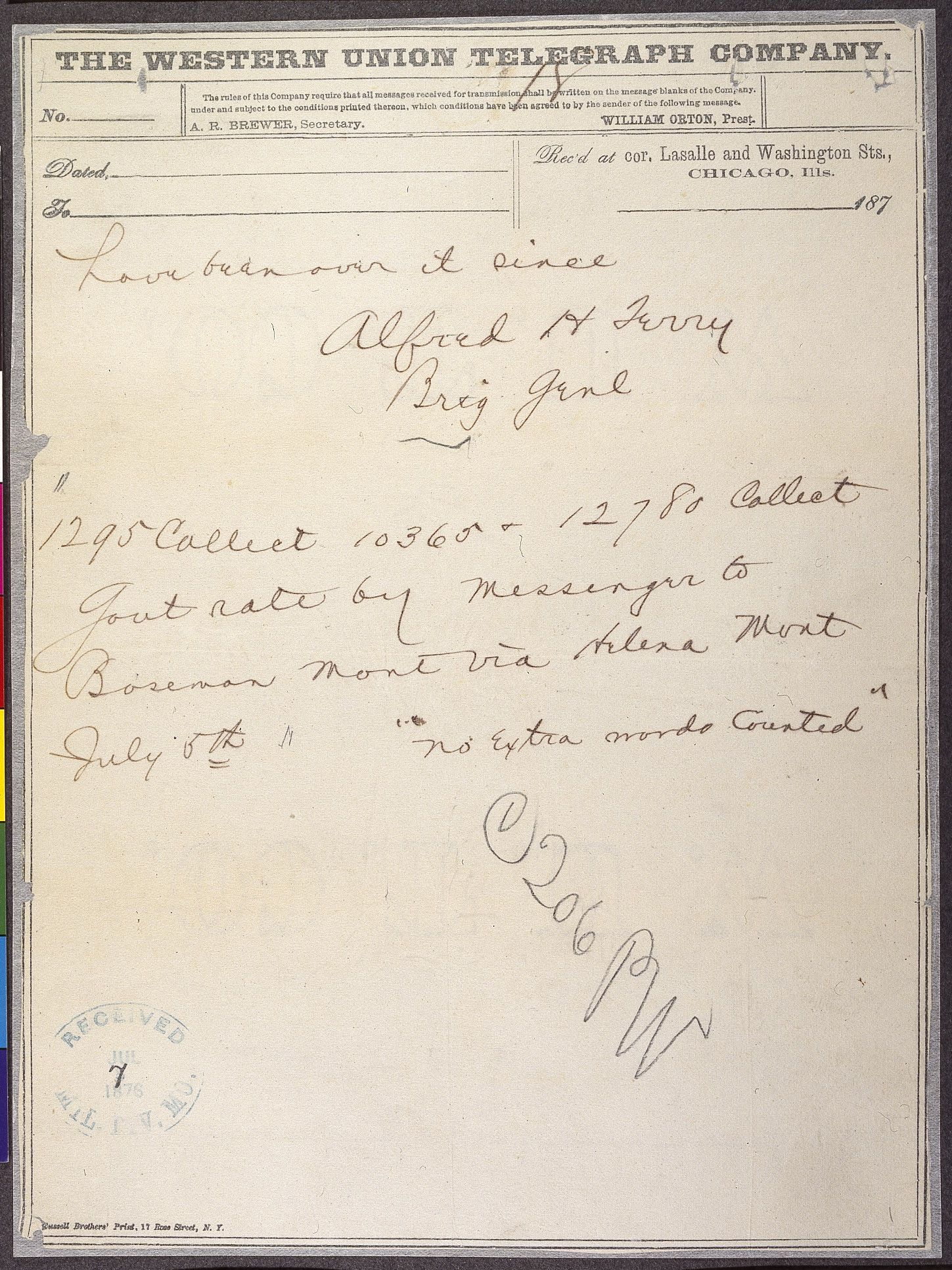The Settlement of the American West
Making Connections
All documents and text associated with this activity are printed below, followed by a worksheet for student responses.Introduction
In this activity, we will analyze primary sources that document government policies and technological improvements that led to the settlement of the American West. Notice the impact that this had on Native Americans. As a class, we will analyze each document and then figure out how they connect to tell the story of westward expansion.Examine the first three documents. What connections do you see between these documents? Are there any cause and effect relationships between these documents? Answer these questions in the next available blank text box (with the ? icon). Repeat this procedure with the next document groups.
Class:
Worksheet
The Settlement of the American West
Making Connections
Examine the documents and text included in this activity. Fill in any blanks in the sequence with your thoughts and write your conclusion response in the space provided.Abraham Lincoln, President, U.S,

Act of May 20, 1862 (Homestead Act), Public Law 37-64 (12 STAT 392).
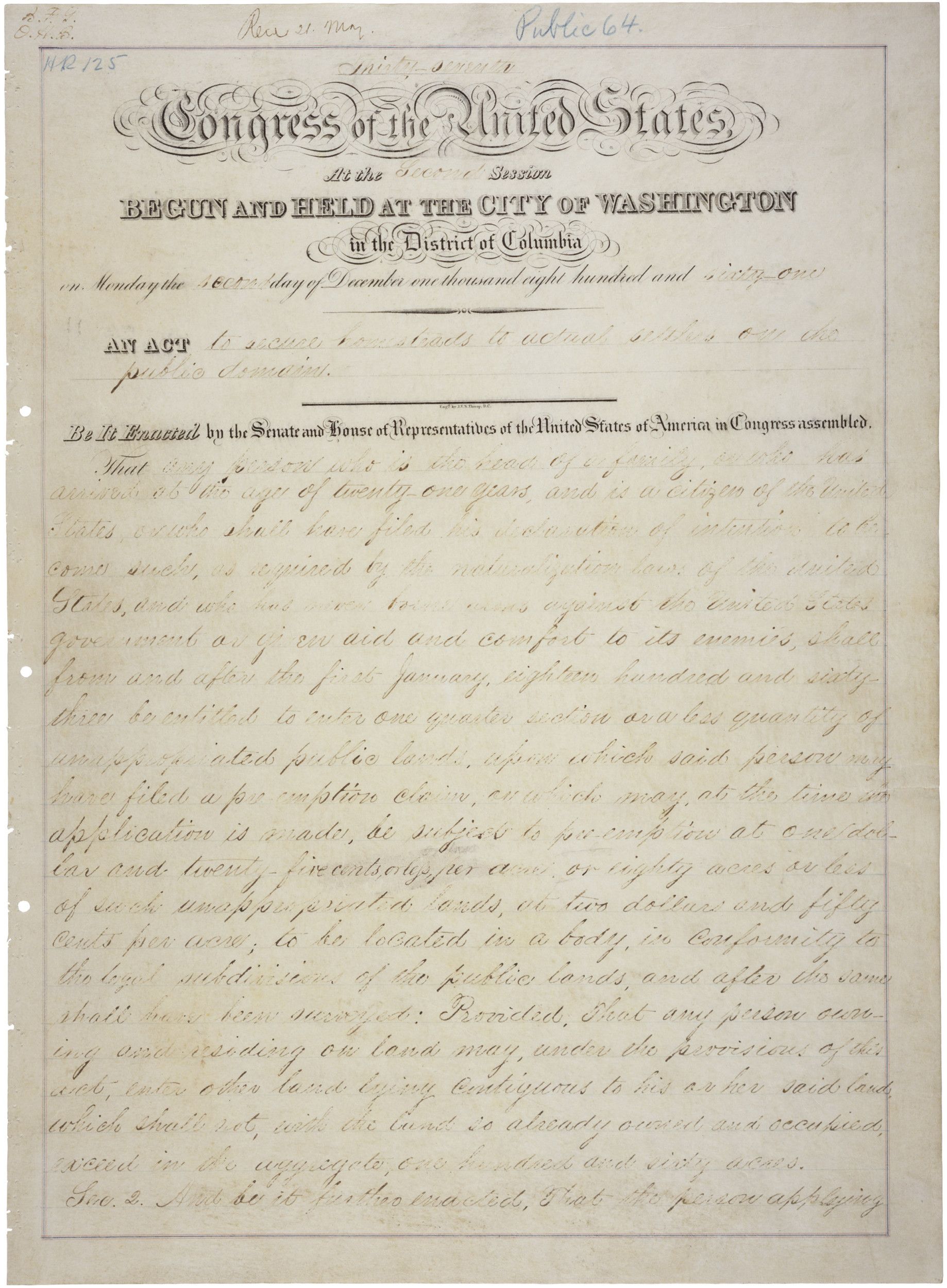
Homesteading Certificate of Eligibility for Daniel Freeman
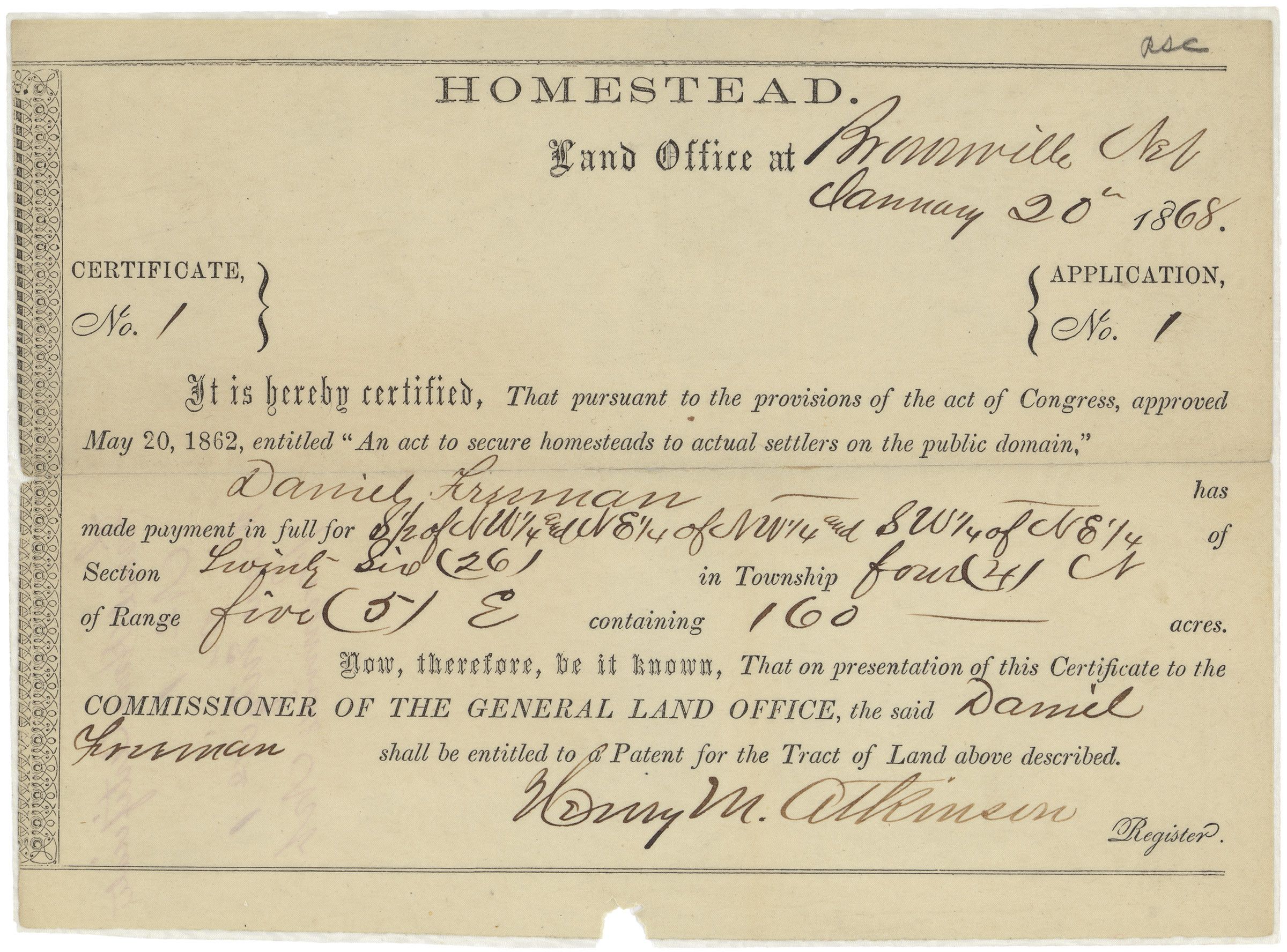
Photograph of a Family with Their Covered Wagon During the Great Western Migration
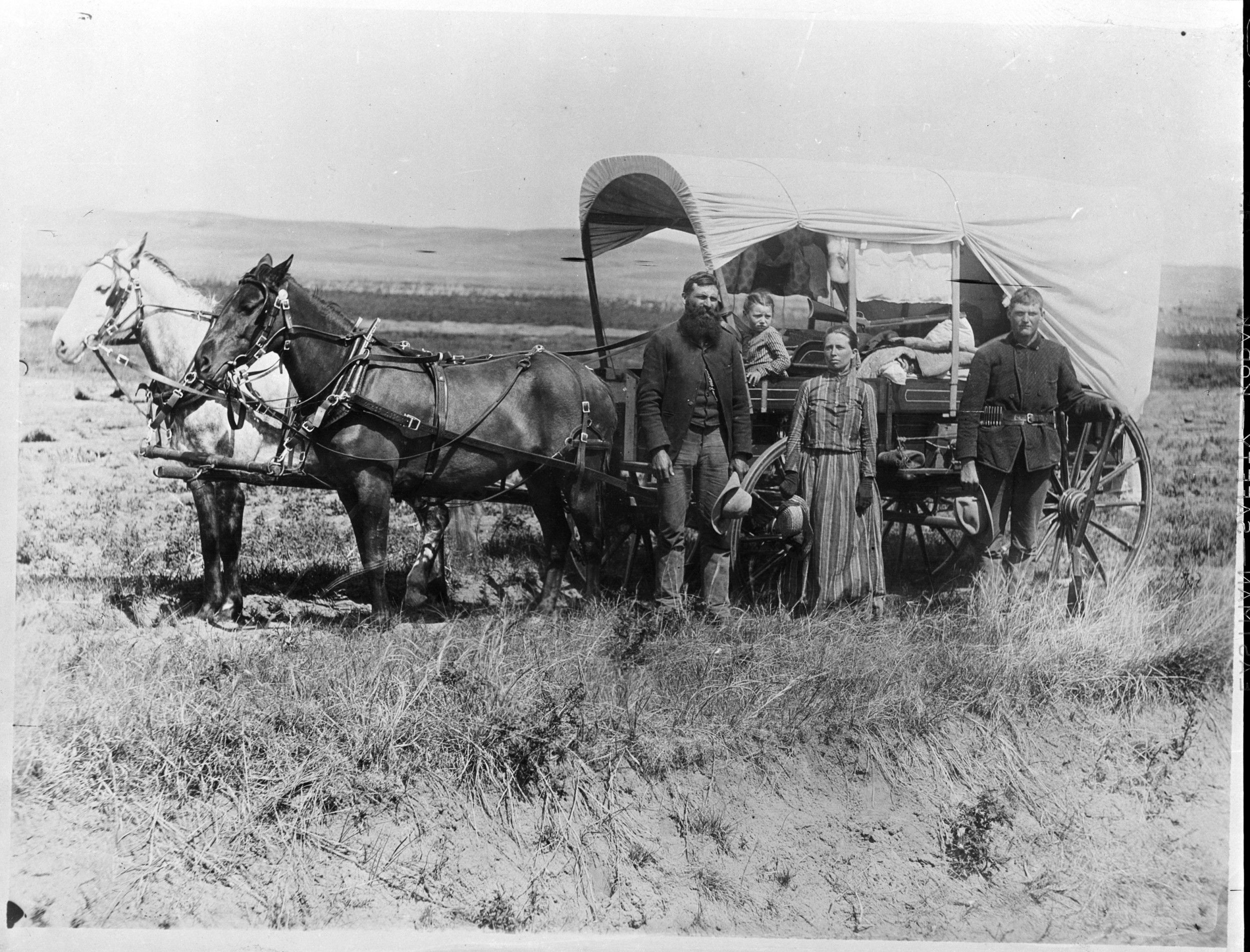
Map of Nebraska and Kansas Territories, showing the location of the Indian Reserves according to the treaties of 1854
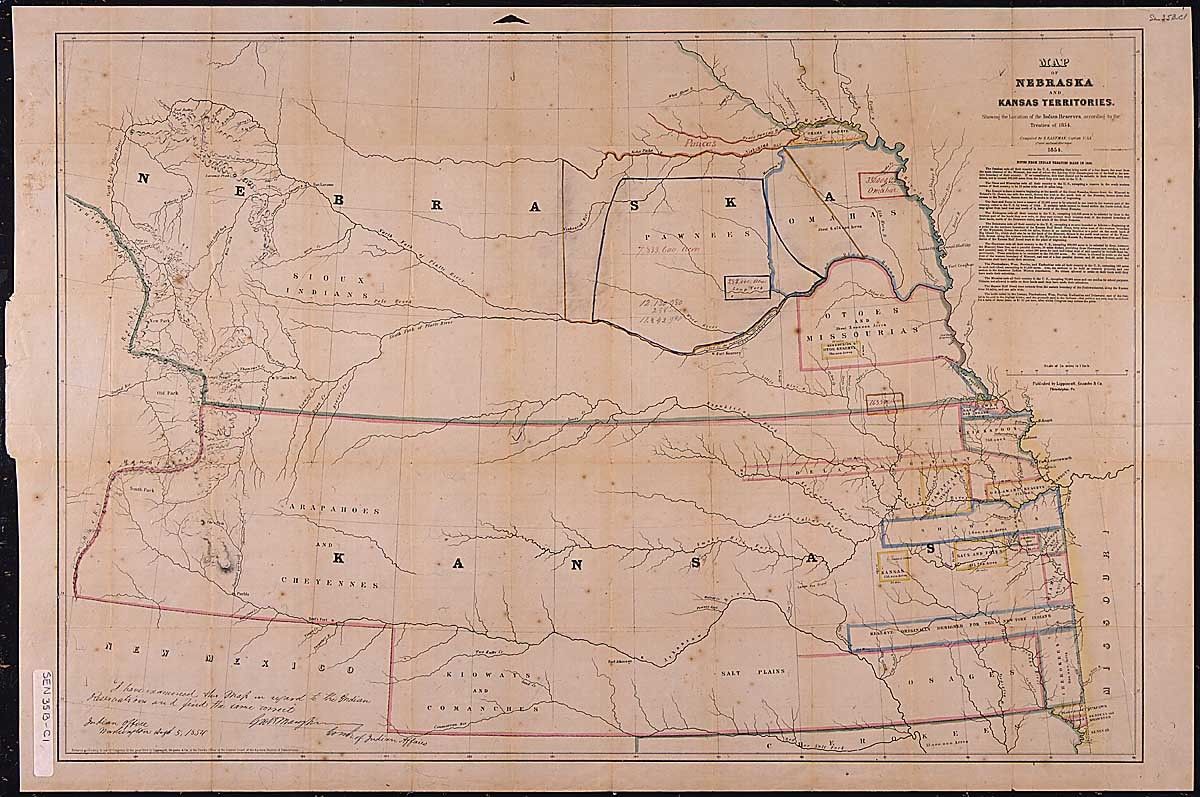
Act of July 1, 1862 (Pacific Railroad Act), 12 STAT 489, which established the construction of a railroad and telegraph line from the Missouri River to the Pacific Ocean.
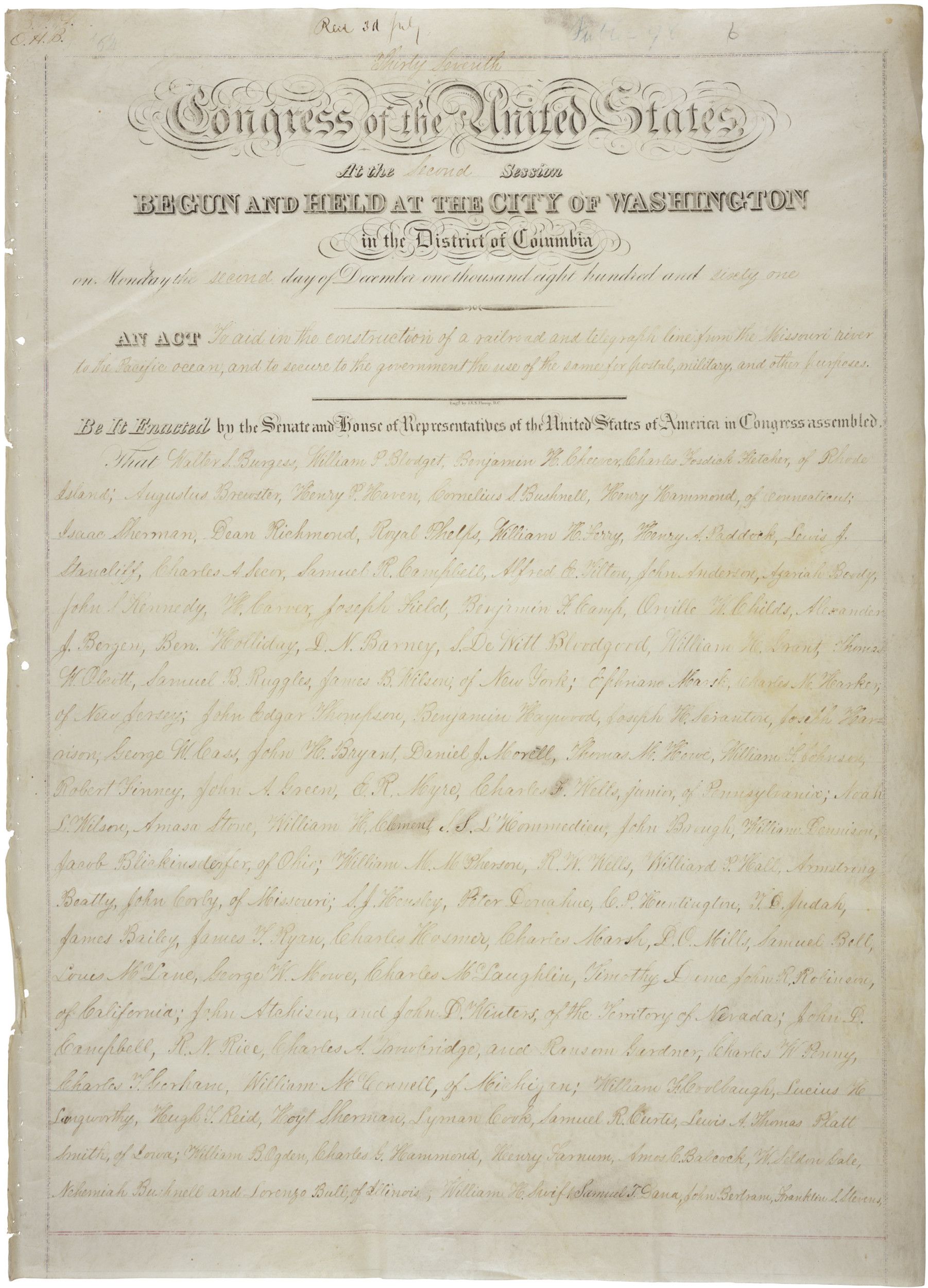
Directors of the Union Pacific Railroad
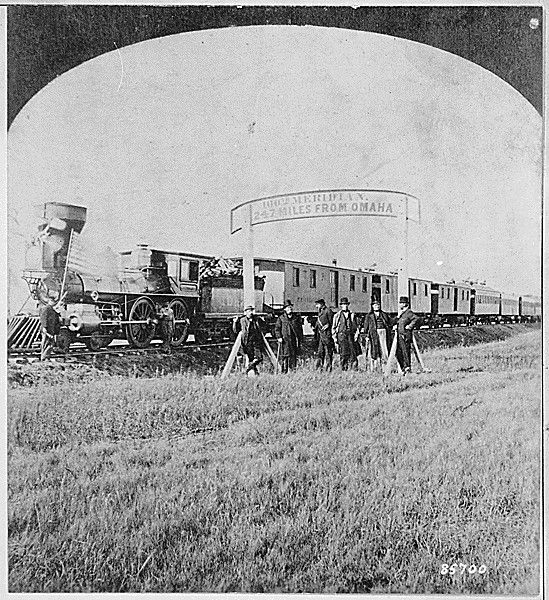
Joining the tracks for the first transcontinental railroad, Promontory, Utah, Terr., 1869

Fort Laramie Treaty
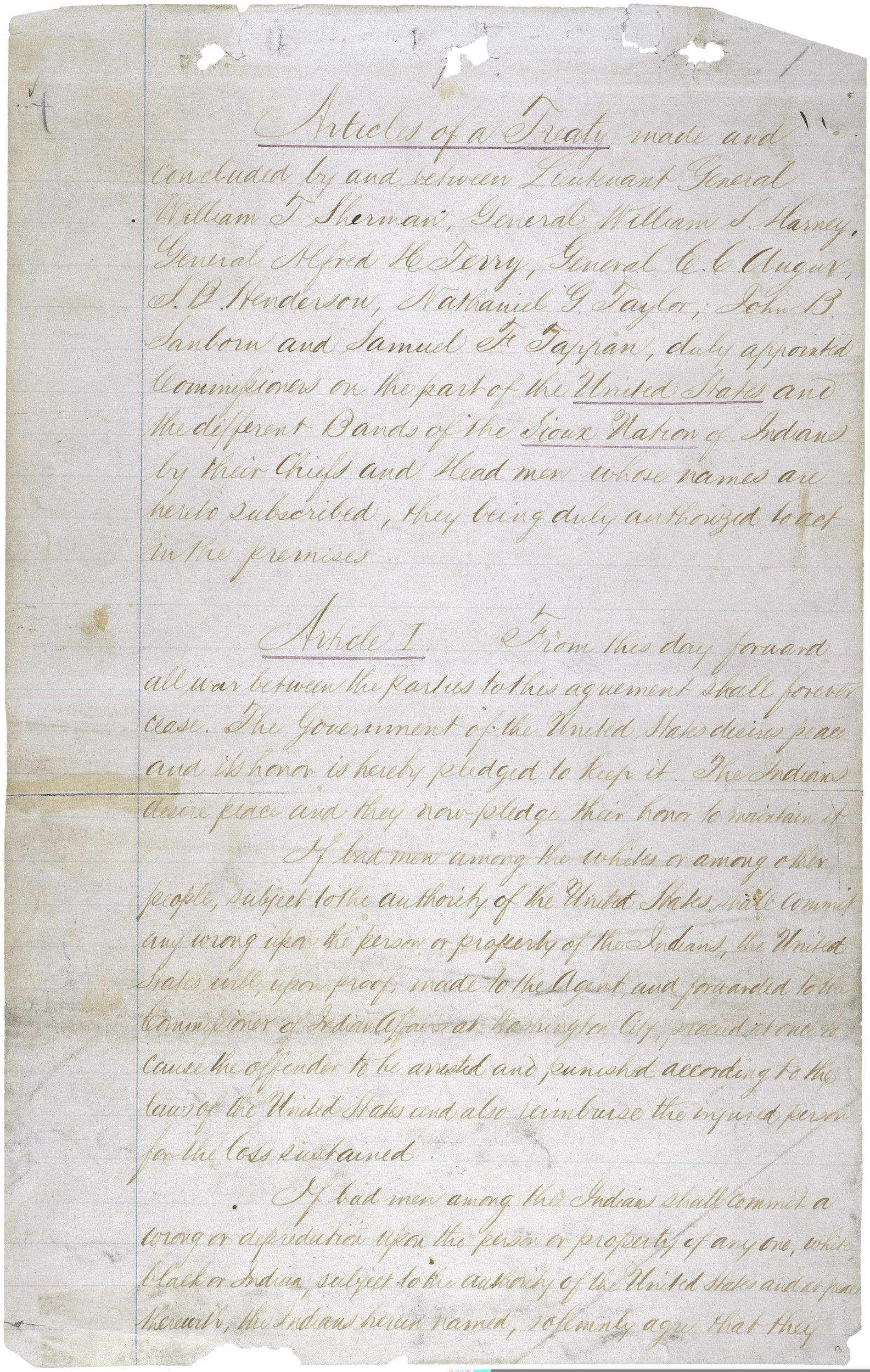
First Report of the Battle of the Little Bighorn, From Gen. Alfred H. Terry, Montana, to Assistant Adjutant General R.C. Drum, Chicago
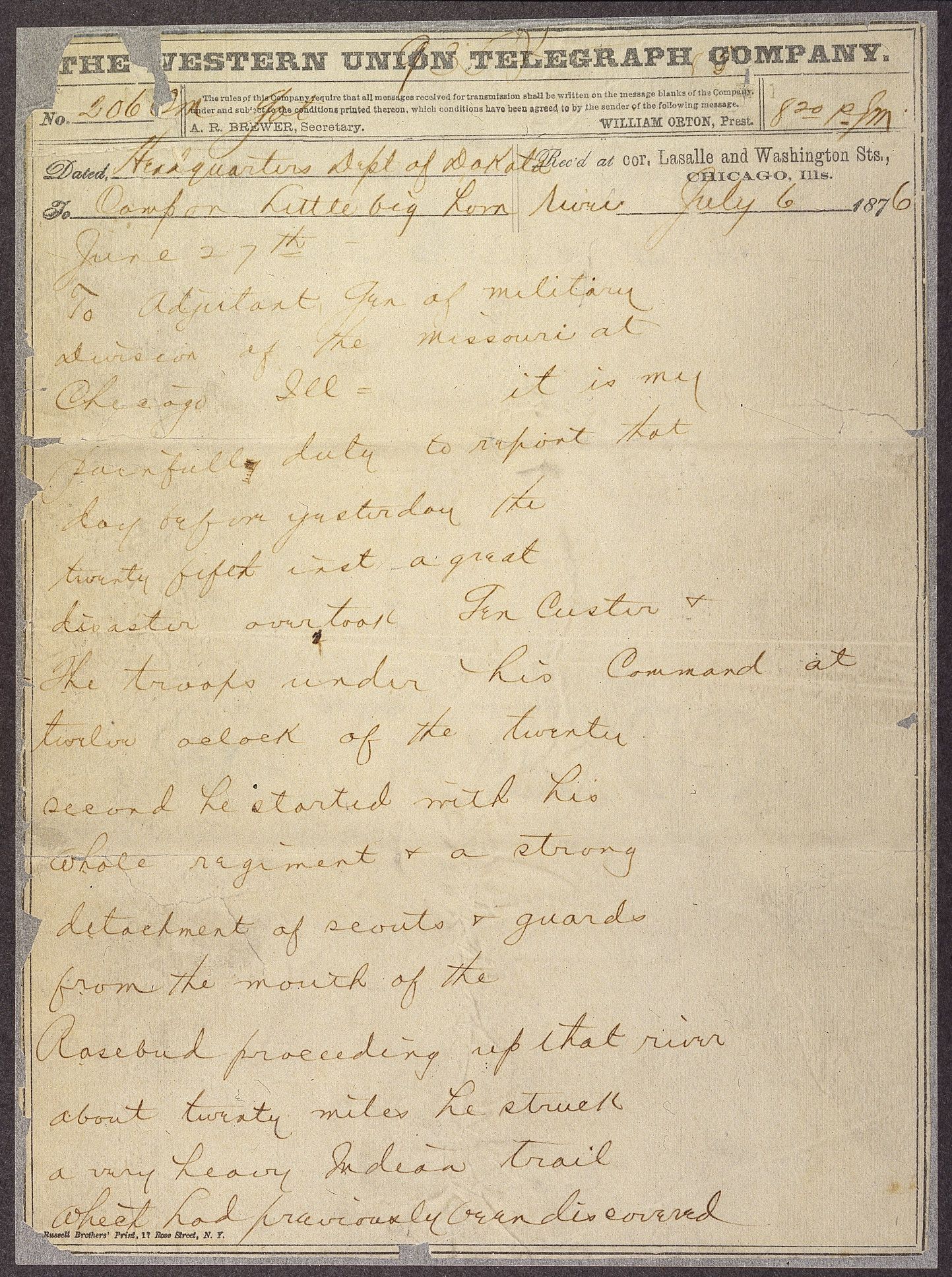
Activity Element
Abraham Lincoln, President, U.S,
Page 2

Activity Element
Act of May 20, 1862 (Homestead Act), Public Law 37-64 (12 STAT 392).
Page 1

Activity Element
Homesteading Certificate of Eligibility for Daniel Freeman
Page 1

Activity Element
Photograph of a Family with Their Covered Wagon During the Great Western Migration
Page 1

Activity Element
Map of Nebraska and Kansas Territories, showing the location of the Indian Reserves according to the treaties of 1854
Page 2

Activity Element
Act of July 1, 1862 (Pacific Railroad Act), 12 STAT 489, which established the construction of a railroad and telegraph line from the Missouri River to the Pacific Ocean.
Page 1

Activity Element
Directors of the Union Pacific Railroad
Page 2

Activity Element
Joining the tracks for the first transcontinental railroad, Promontory, Utah, Terr., 1869
Page 1

Activity Element
Fort Laramie Treaty
Page 1

Activity Element
First Report of the Battle of the Little Bighorn, From Gen. Alfred H. Terry, Montana, to Assistant Adjutant General R.C. Drum, Chicago
Page 2

Conclusion
The Settlement of the American West
Making Connections
We’ve put documents together to tell the story of the settlement of the American West.- What conclusions did you come to?
- What other kinds of documents would provide us with information about westward expansion that were not included in this activity?
- How do you think this new evidence would change your conclusions about the West?
Your Response
Document
Abraham Lincoln, President, U.S
ca. 1860 - 1865
Abraham Lincoln, President, U.S
Page 2

Document
Act of May 20, 1862 (Homestead Act), Public Law 37-64 (12 STAT 392)
5/20/1862
On January 1, 1863, Daniel Freeman made the first claim under the Act. Claimants were required to "improve" the plot by building a dwelling and cultivating the land. After 5 years on the land, the original filer was entitled to the property, free and clear, except for a small registration fee. Title could also be acquired after only a 6-month residency and trivial improvements, provided the claimant paid the government $1.25 per acre. After the Civil War, Union soldiers could deduct the time they had served from the residency requirements.
In reality, few laborers and farmers could afford to build a farm or acquire the necessary tools, seed, and livestock. Most of those who purchased land under the act came from areas quite close to their new homesteads (Iowans moved to Nebraska, Minnesotans to South Dakota, and so on). Unfortunately, the act was framed so ambiguously that it seemed to invite fraud, and early modifications by Congress only compounded the problem. Most of the land went to speculators, cattlemen, miners, lumbermen, and railroads. Of some 500 million acres dispersed by the General Land Office between 1862 and 1904, only 80 million acres went to homesteaders. Indeed, small farmers acquired more land under the Homestead Act in the 20th century than in the 19th.
Transcript
Rec[?] 21 MayPublic 64
HR 125
Thirty-seventh
Congress of the United States
At the Second Session
BEGUN AND HELD AT THE CITY OF WASHINGTON
In the District of Columbia
On Monday the [second] day of December one thousand eight-hundred and sixty-one
[line]
AN ACT to secure homesteads to actual, settlers on the public domain.
[line]
Be it Enacted by the Senate and House of Representatives of the United States of America in Congress assembled, That any person who is the head of a family, or who has arrived at the age of twenty-one years, and is a citizen of the United States, or who shall have filed his declaration of intention to become such, as required by the naturalization laws of the United States, and who has never borne arms against the United States Government or given aid and comfort to its enemies, shall, from and after the first January, eighteen hundred and. sixty-three, be entitled to enter one quarter section or a less quantity of unappropriated public lands, upon which said person may have filed a preemption claim, or which may, at the time the application is made, be subject to preemption at one dollar and twenty-five cents, or less, per acre; or eighty acres or less of such unappropriated lands, at two dollars and fifty cents per acre, to be located in a body, in conformity to the legal subdivisions of the public lands, and after the same shall have been surveyed: Provided, That any person owning and residing on land may, under the provisions of this act, enter other land lying contiguous to his or her said land, which shall not, with the land so already owned and occupied, exceed in the aggregate one hundred and sixty acres.
SEC. 2. And be it further enacted, That the person applying
for the benefit of this act shall, upon application to the register of the land office in which he or she is about to make such entry, make affidavit before the said register or receiver that he or she is the head of a family, or is twenty-one years or more of age, or shall have performed service in the army or navy of the United States, and that he has never borne arms against the Government of the United States or given aid and comfort to its enemies, and that such application is made for his or her exclusive use and benefit, and that said entry is made for the purpose of actual settlement and cultivation, and not either directly or indirectly for the use or benefit of any other person or persons whomsoever; and upon filing the said affidavit with the register or receiver, and on payment of ten dollars, he or she shall thereupon be permitted to enter the quantity of land specified: Provided, however, That no certificate shall be given or patent issued therefor until the expiration of five years from the date of such entry ; and if, at the expiration of such time, or at any time within two years thereafter, the person making such entry ; or, if he be dead, his widow; or in case of her death, his heirs or devisee; or in case of a widow making such entry, her heirs or devisee, in case of her death ; shall. prove by two credible witnesses that he, she, or they have resided upon or cultivated the same for the term of five years immediately succeeding the time of filing the affidavit aforesaid, and shall make affidavit that no part of said land has been alienated, and that he has borne rue allegiance to the Government of the United States; then, in such case, he, she, or they, if at that time a citizen of the United States, shall be entitled to a patent, as in other cases provided for by law: And provided, further, That in case of the death
of both father and mother, leaving an Infant child, or children, under twenty-one years of age, the right and fee shall ensure to the benefit of said infant child or children ; and the executor,
administrator, or guardian may, at any time within two years after the death of the surviving
parent, and in accordance with the laws of the State in which such children for the time being have their domicil, sell said land for the benefit of said infants, but for no other purpose; and the purchaser shall acquire the absolute title by the purchase, and be en- titled to a patent from the United States, on payment of the office fees and sum of money herein specified.
SEC. 3. And be it further enacted, That the register of the land office shall note all such
applications on the tract books and plats of, his office, and keep a register of all such entries, and make return thereof to the General Land Office, together with the proof upon which they have been founded.
SEC. 4. And be it further enacted, That no lands acquired under the provisions of this act shall in any event become liable to the satisfaction of any debt or debts contracted prior to the issuing of the patent therefor.
SEC. 5. And be it further enacted, That if, at any time after the filing of the affidavit, as required in the second section of this act, and before the expiration of the five years aforesaid, it shall be proven, after due notice to the settler, to the satisfaction of the register of the land office, that the person having filed such affidavit shall have actually changed his or her residence, or abandoned the said land for more than six months at any time, then and in that event the land so entered shall revert to the government.
SEC. 6. And be it further enacted, That no individual shall be permit- ted to acquire title to more than one quarter section under the provisions of this act; and that the Commissioner of the General Land Office is hereby required to prepare and issue such rules and regulations, consistent with this act, as shall be necessary and proper to carry its provisions into effect; and that the registers and receivers of the several land offices shall be entitled to receive the same compensation for any lands entered under the provisions of this act that they are
now entitled to receive when the same quantity of land is entered with money, one half to be paid by the person making the application at the time of so doing, and the other half on the issue of the certificate by the person to whom it may be issued; but this shall not be construed to enlarge the maximum of compensation now prescribed by law for any register or receiver: Provided, That nothing contained in this act shall be so construed as to im- pair or interfere in any manner whatever with existing preemption rights: And provided, further, That all persons who may have filed their applications for a preemption right prior to the passage of this act, shall be entitled to all privileges of this act: Provided, further, That no person who has served, or may hereafter serve, for a period of not less than fourteen days in the army or navy of the United States, either regular or volunteer, under the laws thereof, during the existence of an actual war, domestic or foreign, shall be deprived of the benefits of this act on account of not having attained the age of twenty-one years.
SEC. 7. And be it further enacted, That the fifth section of the act en- titled "An act in addition to an act more effectually to provide for the punishment of certain crimes against the United States, and for other purposes," approved the third of March, in the year eighteen hundred and fifty-seven, shall extend to all oaths, affirmations, and affidavits, re- quired or authorized by this act.
SEC. 8. And be it further enacted, That nothing in this act shall be 80 construed as to prevent any person who has availed him or herself of the benefits of the fir8t section of this act, from paying the minimum price, or the price to which the same may have graduated, for the quantity of land so entered at any time before the expiration of the five years, and obtain- ing a patent therefor from the government, as in other cases provided by law, on making proof of settlement and cultivation as provided by existing laws granting preemption rights.
Galusha A. Grow
Speaker of the House of Representatives
Solomon Foot,
President of the Senate protempore
Approved, May 20, 1862
Abraham Lincoln
Act of May 20, 1862 (Homestead Act), Public Law 37-64 (12 STAT 392)
Page 1
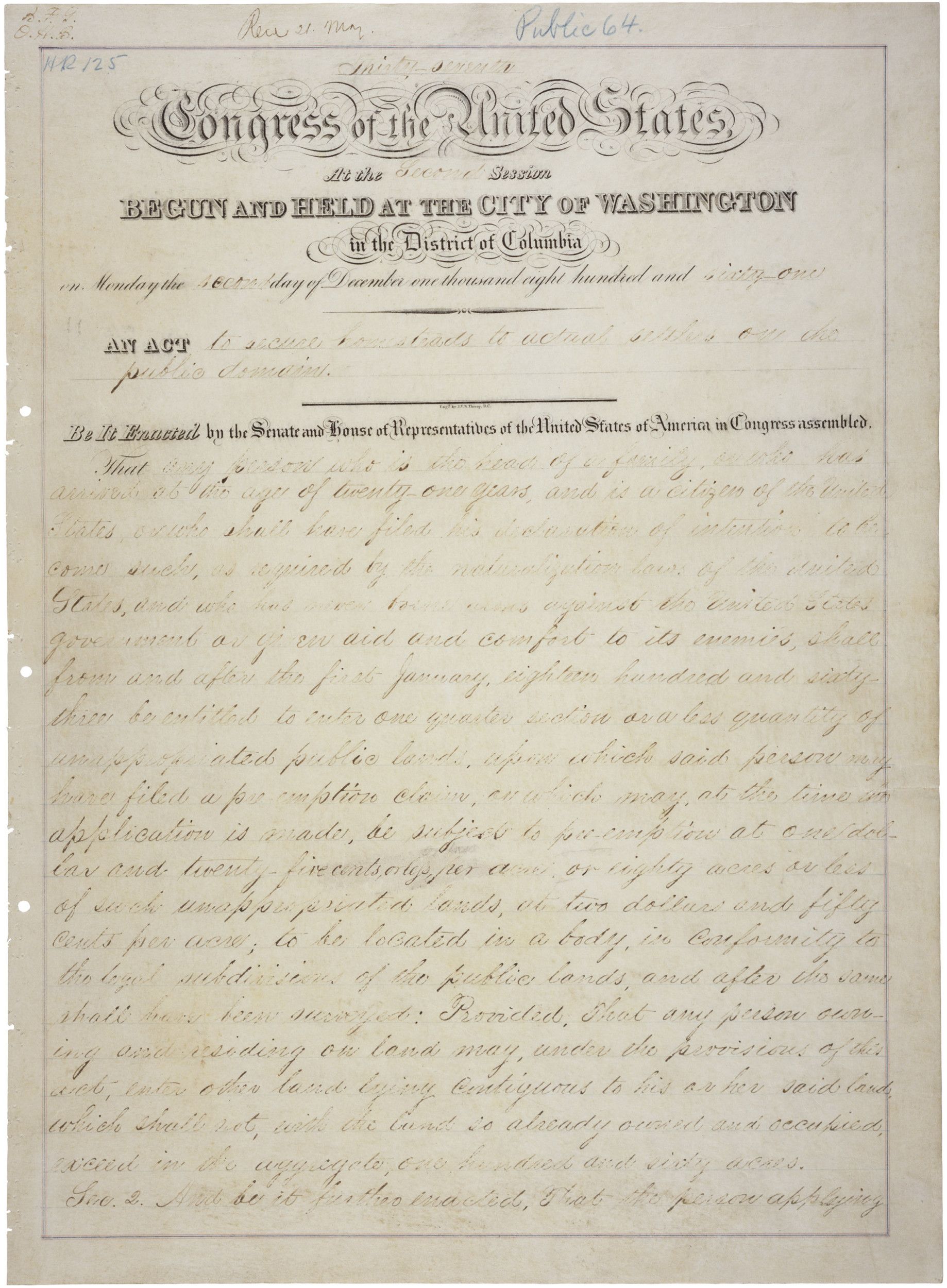
Act of May 20, 1862 (Homestead Act), Public Law 37-64 (12 STAT 392)
Page 2
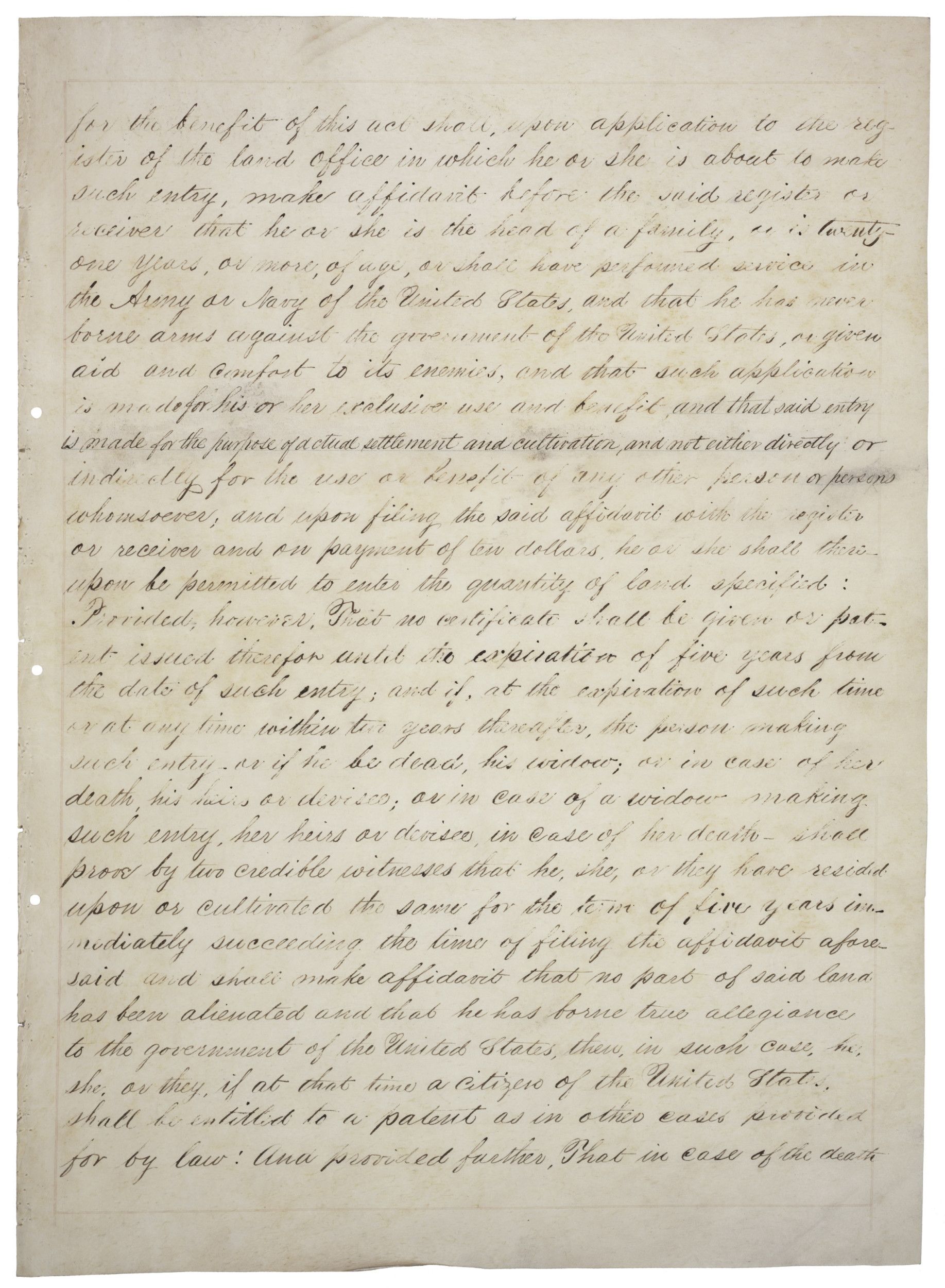
Act of May 20, 1862 (Homestead Act), Public Law 37-64 (12 STAT 392)
Page 3
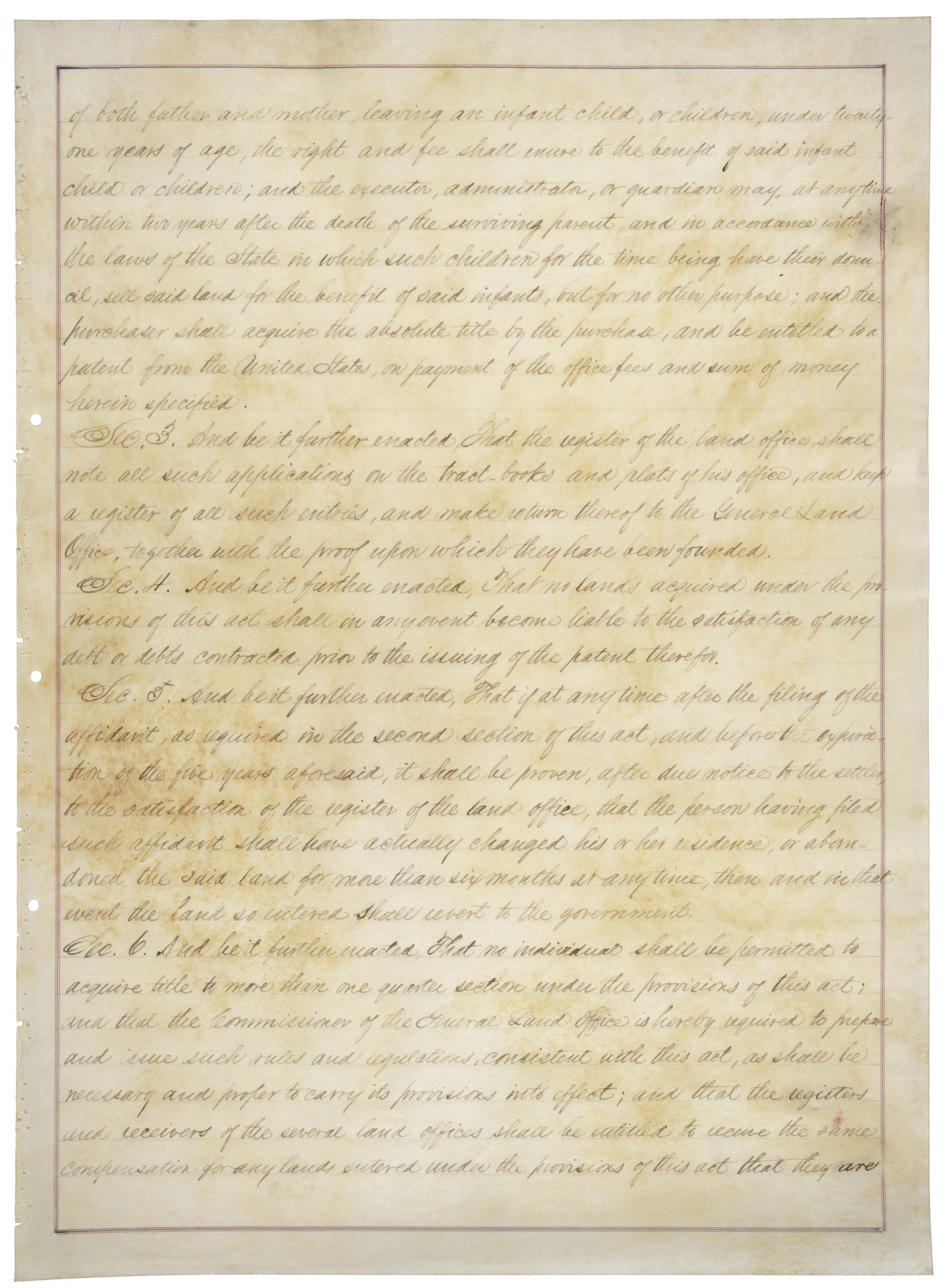
Act of May 20, 1862 (Homestead Act), Public Law 37-64 (12 STAT 392)
Page 4
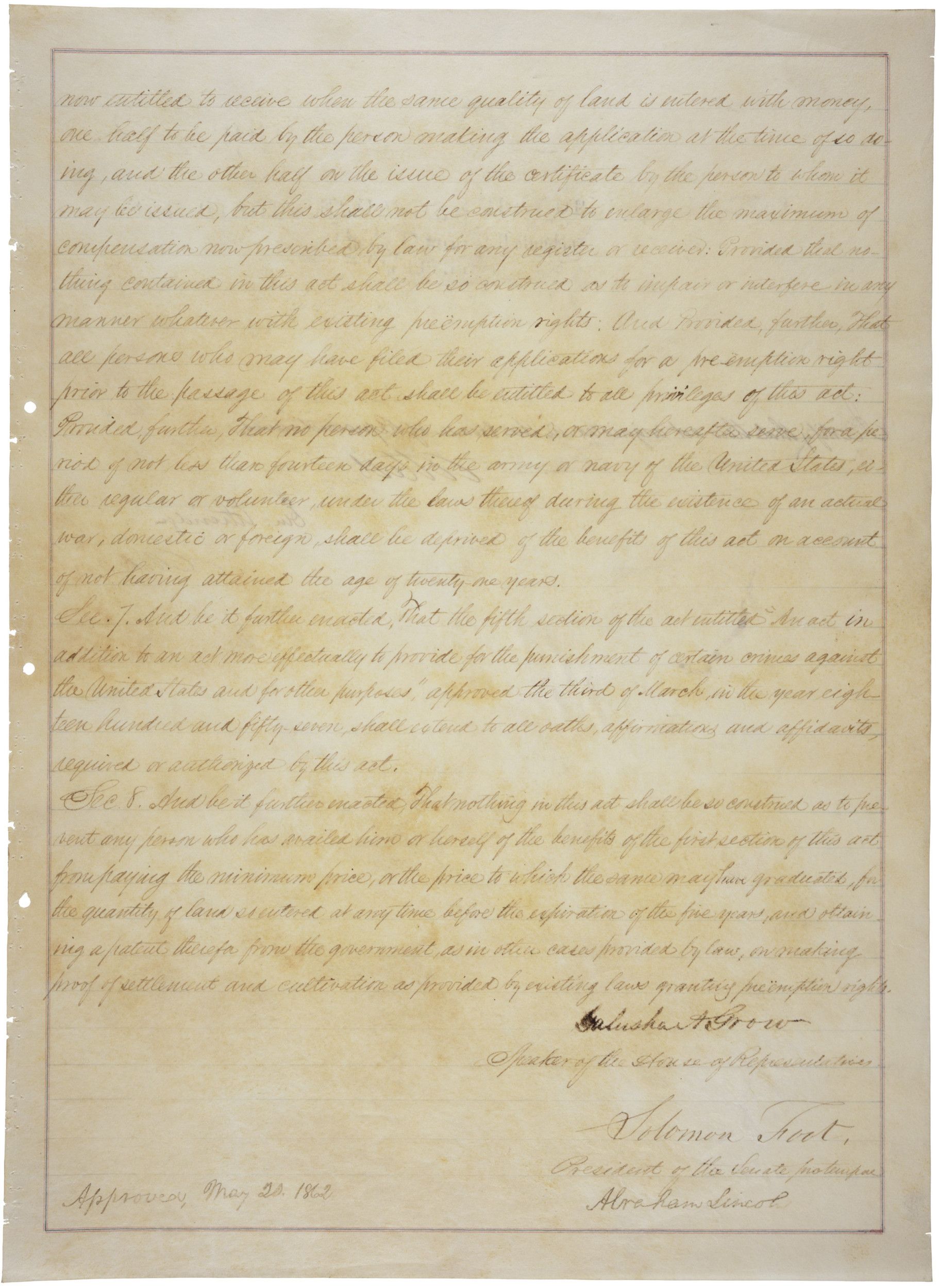
Document
Homesteading Certificate of Eligibility for Daniel Freeman
1/20/1868
Text adapted from “The Homestead Act of 1862” in the October 1997 National Council for the Social Studies (NCSS) publication Social Education.
Homesteading Certificate of Eligibility for Daniel Freeman
Page 1
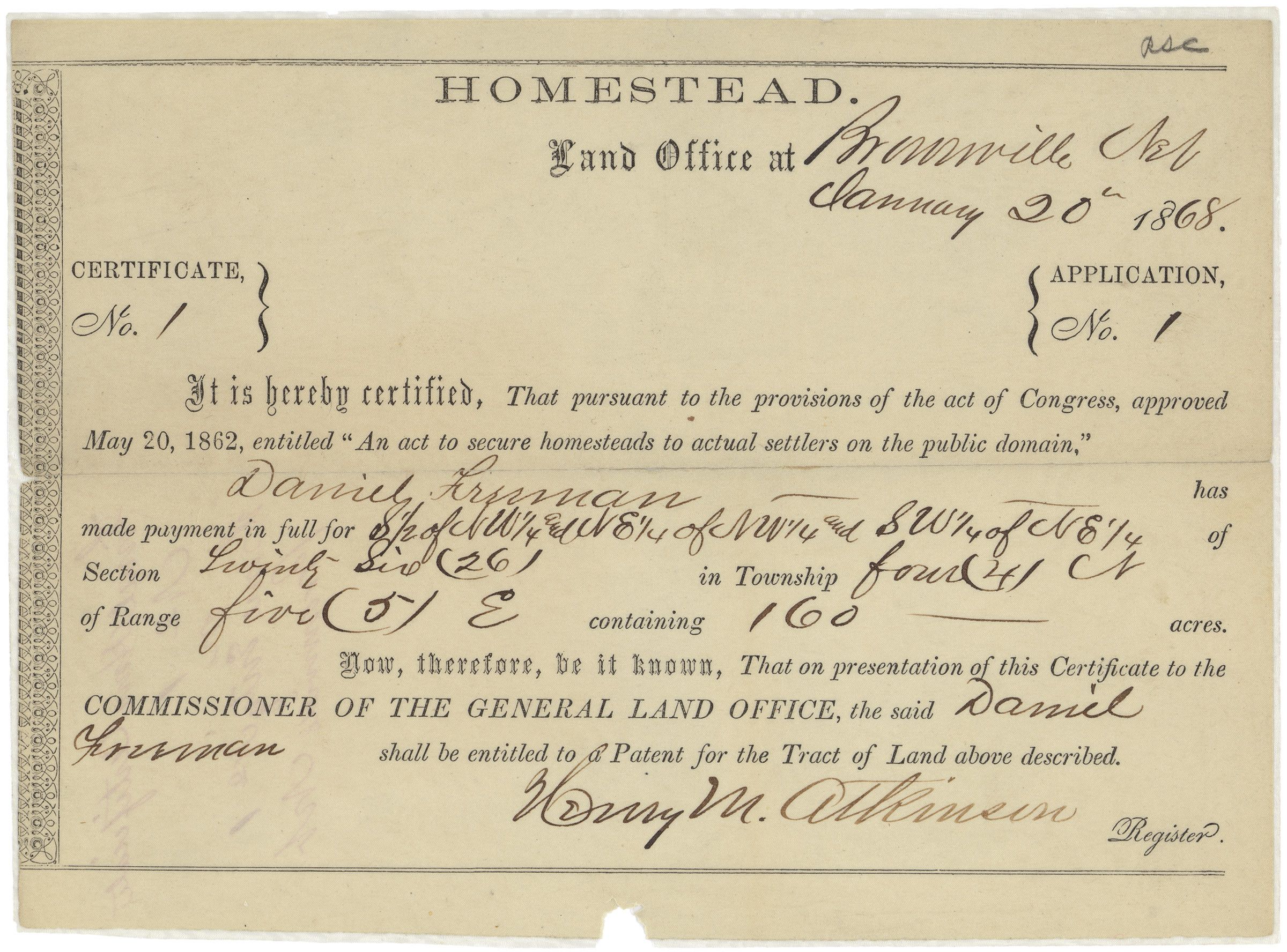
Homesteading Certificate of Eligibility for Daniel Freeman
Page 2
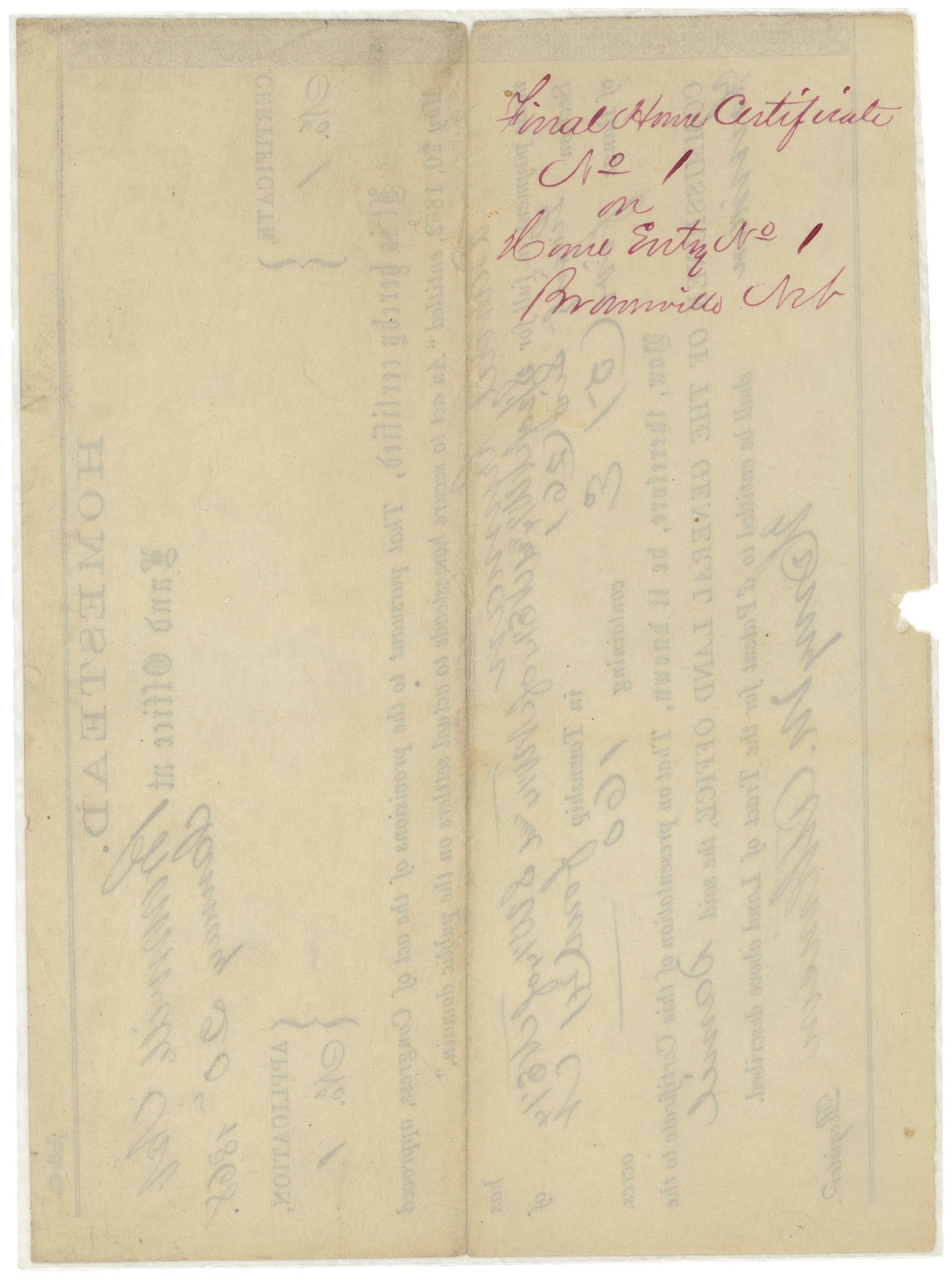
Document
Family with Their Covered Wagon During the Great Western Migration
1866
The image shows a family pausing to pose for a picture in Loup Valley, Nebraska, on their journey to a homestead. The Homestead Act of 1862 allowed a citizen to claim up to 160 acres of western lands in exchange for farming and improving that land.
Text adapted from “The Homestead Act of 1862” in the October 1997 National Council for the Social Studies (NCSS) publication Social Education, which includes background information and teaching suggestions about The Homestead Act.
Family with Their Covered Wagon During the Great Western Migration
Page 1
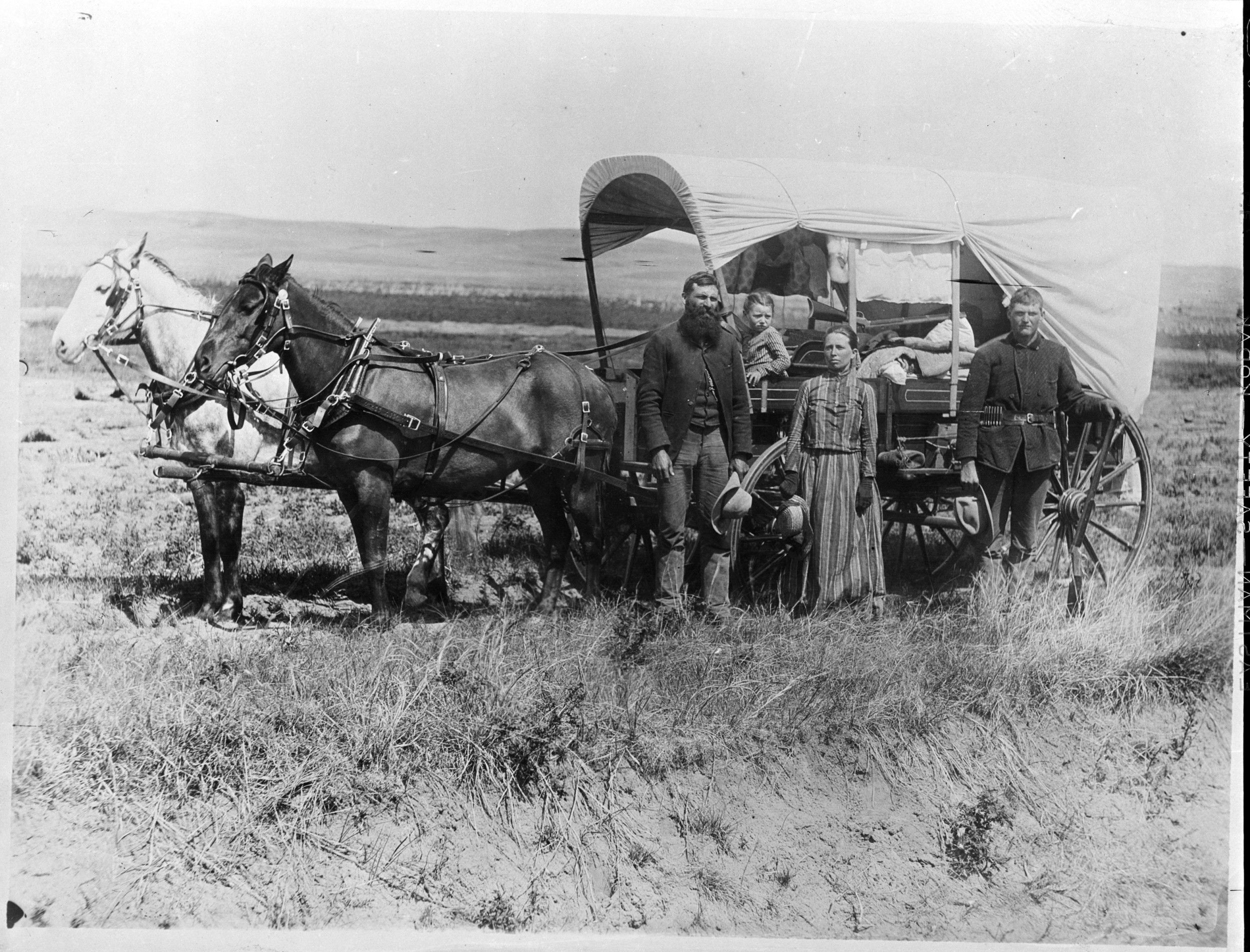
Document
Map of Nebraska and Kansas Territories, showing the location of the Indian Reserves according to the treaties of 1854
1854
Map of Nebraska and Kansas Territories, showing the location of the Indian Reserves according to the treaties of 1854
Page 2
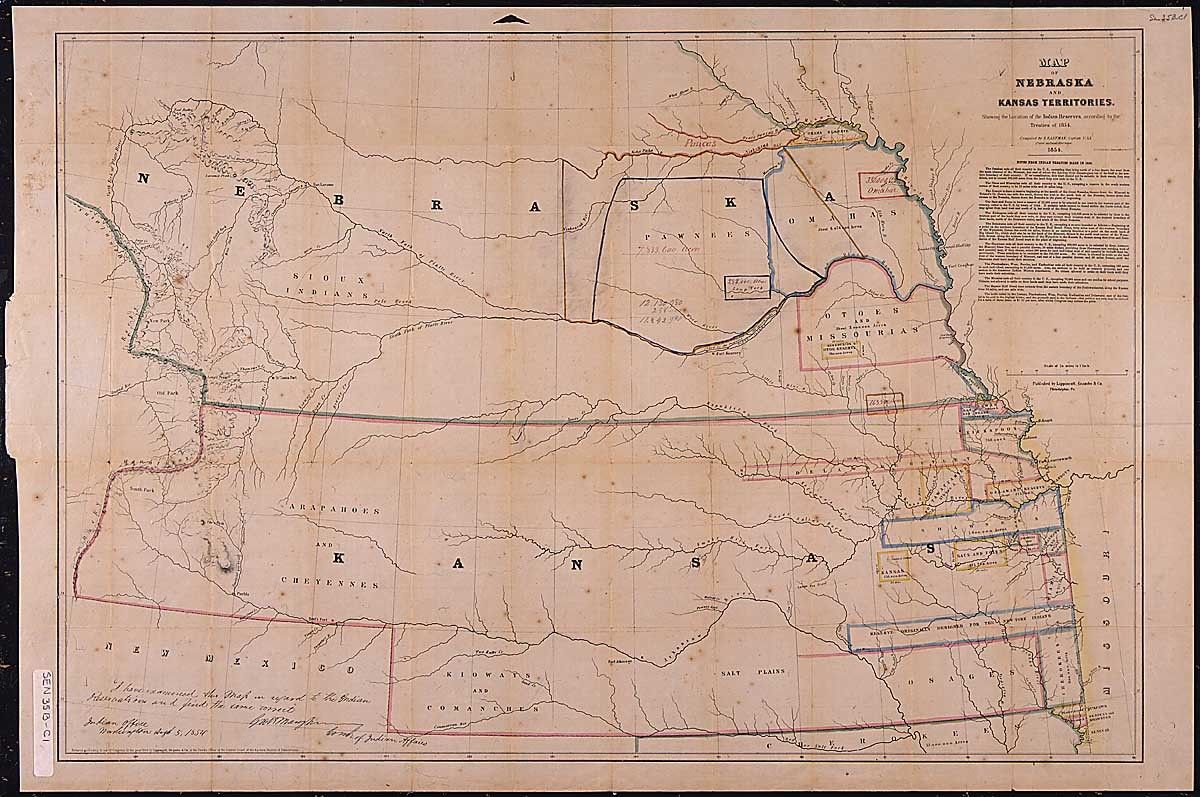
Document
Act of July 1, 1862 (Pacific Railroad Act), 12 STAT 489, which established the construction of a railroad and telegraph line from the Missouri River to the Pacific Ocean.
7/1/1862
In the 1850s, Congress had commissioned several topographical surveys across the West to determine the best route for a railroad, but private corporations were reluctant to undertake the task without federal assistance. This Act designated the 32nd parallel as the initial transcontinental route and provided government bonds to fund the project and large grants of lands for rights-of-way. The Act aided the construction of a railroad and telegraph line from the Missouri River to the Pacific Ocean and secured the use of that line to the government.
The legislation authorized two railroad companies, the Union Pacific and the Central Pacific, to construct the lines. Beginning in 1863, the Union Pacific, employing more than 8,000 Irish, German, and Italian immigrants, built west from Omaha, NE. The Central Pacific, whose workforce included over 10,000 Chinese laborers, built eastward from Sacramento, CA. Each company faced unprecedented construction challenges, severe weather, and conflict with American Indians, whose ancestral lands were transected by the railroads.
On May 10, 1869, the last rails were laid and the last spike was driven in a ceremony at Promontory, UT. The completion of the transcontinental railroad shortened a journey of several months to about one week. Congress eventually authorized four transcontinental railroads and granted 174 million acres of public lands for rights-of-way.
Transcript
Thirty SeventhCongress of the United States
At the Second Session
Begun and Held at the City of Washington
in the District of Columbia
on Monday the second day of December one thousand eight hundred and sixty one
An Act To aid in the construction of a railroad and telegraph line from the Missouri River to the Pacific Ocean, and to secure to the Government the use of the same for postal, military, and other purposes.
Be it enacted by the Senate and House of Representatives of the United States of America in Congress assembled, That Walter S. Burgess, William P. Blodget, Benjamin H. Cheever, Charles Fosdick Fletcher, of Rhode Island; Augustus Brewster, Henry P. Haven, Cornelius S. Bushnell, Henry Hammond, of Connecticut; Isaac Sherman, Dean Richmond, Royal Phelps, William H. Ferry, Henry A. Paddock, Lewis J. Stancliff, Charles A. Secor, Samuel R. Campbell, Alfred E. Tilton, John Anderson, Azariah Boody, John S. Kennedy, H. Carver, Joseph Field, , Benjamin F. Camp,Orville W. Childs, Alexander J. Bergen, Ben. Holliday, D. N. Barney, S. De Witt Bloodgood, William H. Grant, Thomas W. Olcott, Samuel B. Ruggles, James B. Wilson, of New York; Ephraim Marsh, Charles M. Harker, of New Jersey; John Edgar Thompson, Benjamin Haywood, Joseph H. Scranton, Joseph Harrison, George W. Cass, John H. Bryant, Daniel J. Morell, Thomas M. Howe, William F. Johnson, Robert Finney, John A. Green, E. R. Myre, Charles F. Wells, junior, of Pennsylvania; Noah L. Wilson, .Amasa Stone, William H. Clement, S. S. L'Hommedieu, John Brough, William Dennison, Jacob Blickinsderfer, of Ohio; William M. McPherson, R. W. Wells, Willard P. Hall, .Armstrong Beatty, John Corby, of Missouri ; S. J. Hensley, Peter Donahue, C. P. Huntington, T. D. Judah, James Bailey, James T. Ryan, Charles Hosmer, Charles Marsh, D. 0. Mills, Samuel Bell, Louis McLal1e, George W. Mowe, Charles McLaughlin, Timothy Dame, John R. Robinson, of California; John Atchison and John D. Winters, of the Territory of Nevada; John D. Campbell, R. N. Rice, Charles A. Trowbridge, and Ransom Gardner, Charles W. Penny, Charles T. Gorham, William McConnell, of Michigan; William F Coolbaugh, Lucius H. Langworthy, Hugh T. Reid, Hoyt Sherman, Lyman Cook, Samuel R. Curtis, Lewis .A. Thomas, Platt Smith, of Iowa; William B. Ogden, Charles G. Hammond, Henry Farnum, .Amos C. Babcock, W. Seldon Gale, Nehemiah Bushnell and Lorenzo Bull, of Illinois; William H. Swift, Samuel T. Dana, John Bertram, Franklin S. Stevens, Edward R. Tinker, of Massachusetts; Franklin Gorin, Laban J. Bradford, and John T. Levis, of Kentucky; James Dunning, John M. Wood, Edwin Noyes, Joseph Eaton, of Maine; Henry H. Baxter, George W. Collamer, Henry Keyes, Thomas H. Canfield, of Vermont ; William S. Ladd, .A. M. Berry, Benjamin F. Harding, of Oregon ; William Bunn, junior, John Catlin, Levi Sterling, John Thompson, Ellhu L. Phillips, Walter D. McIndoe T. B. Stoddard, E.H. Brodhead, A. H. Virgin, of Wisconsin; Charles Paine, Thomas A. Morris, David C. Branham, Samuel Hanna, Jonas Votaw, Jesse L. Villiams, Isaac C. Elston, of Indiana; Thomas Swan, Chauncey Brooks, Edward Wilkins, of Maryland; Francis R. E. Cornell, David Blakely, A. D. Seward, Henry A. Swift, Dwight Woodbury, John McKusick, John R. Jones, of Minnesota; Joseph A. Gilmore, Charles W. Woodman, of New Hampshire; W. H. Grimes, J. C. Stone, Chester Thomas, John Kerr, Werter R. Davis, Luther C. Challiss, Josiah Miller, of Kansas; Gilbert C. Monell and Augustus Kountz, T. M. Marquette, William H. Taylor, .Alyin Saunders, of Nebraska; John Evans, of Colorado; together with commissioners to be appointed by the Secretary of the Interior, and all persons who shall or may be associated with them, and their successors, are hereby created and erected into a body corporate and politic in deed and in law, by the name, style, and title of “The Union Pacific Railroad Company;" and by that name shall have perpetual succession, and shall be able to sue and to be sued, plead and be impleaded, defend and be defended, in all courts of law and equity within the United States, and may make and have a common seal; and the said corporation is hereby authorized and empowered to layout, locate, construct, furnish, maintain, and enjoy a continuous railroad and telegraph, with the appurtenances, from a point on the one hundredth meridian of longitude west from Greenwich, between the south margin of the valley of the Republican River and the north margin of the valley of the Platte River, in the Territory of Nebraska, to the western boundary of Nevada Territory, upon the route and terms hereinafter provided, and is hereby vested with all the powers, privileges, and immunities necessary to carry into effect the purposes of this act as herein set forth. The capital stock of said company shall consist of one hundred thousand shares of one thousand dollars each, which shall be subscribed for and held in not more than two hundred shares by anyone person, and shall be transferable in such manner as the by-laws of said corporation shall provide. The persons hereinbefore named, together with those to be appointed by the Secretary of the Interior, are hereby constituted and appointed commissioners, and such body shall be called the Board of Commissioners of the Union Pacific Railroad and Telegraph Company, and twenty-five shall constitute a quorum for the transaction of business. The first meeting of said board shall be held at Chicago at such time as the commissioners from Illinois herein named shall appoint, not more than three nor less than one month after the passage of this act, notice of which shall be given by them to the other commissioners by depositing a call thereof in the post office at Chicago, post paid, to their address at least forty days before said meeting, and also by publishing said notice in one daily newspaper in each of the cities of Chicago and Saint Louis. Said board shall organize by the choice from its number of a president, secretary, and treasurer, and they shall require from said treasurer such bonds as may be deemed proper, and may from time to time increase the amount thereof as they may deem proper. It shall be the duty of said board of commissioners to open books, or cause books to be opened, at such times and in such principal cities in the United States as they or a quorum of them shall determine, to receive subscriptions to the capital stock of said corporation, and a cash payment of ten per centum on all subscriptions, and to receipt therefor. So soon as two thousand shares shall be in good faith subscribed for, and ten dollars per share actually paid into the treasury of the company, the said president and secretary of said board of commissioners shall appoint a time and place for the first meeting of the subscribers to the stock of said company, and shall give notice thereof in at least one newspaper in each State in which subscription books have been opened at least thirty days previous to the day of meeting, and such subsribers as shall attend the meeting so called, either in person or by proxy, shall then and there elect by ballot not less than thirteen directors for said corporation; and in such election each share of said capital shall entitle the owner thereof to one vote. The president and secretary of the board of commissioners shall act as inspectors of said election, and shall certify under their hands the names of the directors elected at said meeting; and the said commissioners, treasurer, and secretary shall then deliver over to said directors all the properties, subscription books and other books in their possession, and thereupon the duties of said commissioners, and the officers previously appointed by them shall cease and determine forever, and thereafter the stockholders shall constitute said body politic and corporate. At the time of the first and each triennial election of directors by the stockholders two additional directors shall be appointed by the President of the United States, who shall act with the body of directors, and to be denominated directors on the part of the government; any vacancy happening in the government directors at any time may be filled by thc President of the United States. The directors to be appointed by the President shall not be stockholders in the Union Pacific Railroad Company. The directors so chosen shall, as soon as may be after their election, elect from their own number a president and vice-president, and shall also elect a treasurer and secretary. No person shall be a director in said company unless he shall be a bona fide owner of at least five shares of stock in the said company, except the two directors to be appointed by the President as aforesaid. Said company, at any regular meeting of the stockholders called for that purpose, shall have power to make by-laws, rules, and regulations as they shall deem needful and proper, touching the disposition of the stock, property, estate, and effects of the company, not inconsistent herewith, the transfer of shares, the term of office, duties, and conduct of their officers and servants, and all matters whatsoever which may appertain to the concerns of said company; and the said board of directors shall have power to appoint such engineers, agents, and subordinates as may from time to time be necessary to carry into effect the object of this act, and to do all acts and things touching the location' and construction of said road and telegraph. Said directors may require payment of subscriptions to the capital stock, after due notice, at such times and in such proportions as they shall deem necessary to complete the railroad and telegraph within the time in this act prescribed. Said president, vice-president, and directors shall hold their office for three years, and until their successors are duly elected and qualified, or for such less time as the by-laws of the corporation may prescribe; and a majority of said directors shall constitute a quorum for the transaction of business. The secretary and treasurer shall give such bonds, with such security, as the said board shall from time to time require, and shall hold their offices at the will and pleasure of the directors. Annual meetings of the stockholders of the said corporation, for the choice of officers (when they are to be chosen) and for the transaction of annual business, shall be holden at such time and place and upon such notice as may be prescribed in the by-laws.
Sec. 2. And he it further enacted, That the right of way through the public lands be, and the same is hereby, granted to said company for the construction of said railroad and telegraph line; and the right, power, and authority is hereby given to said company to take from the public lands adjacent to the line of said road, earth, stone, timber, and other materials for the construction thereof; said right of way is granted to said railroad to the extent of two hundred feet in width on each side of said railroad where it may pass over the public lands, including all necessary grounds for stations, buildings, workshops, and depots, machine shops, switches, side tracks, turntables, and, water stations. The United States shall extinguish as rapidly as may be the Indian titles to all lands falling under the operation of this act and required for the said right of way and; grants hereinafter made.
Sec 3. And be it further enacted, That there be, and is hereby , granted to the said company, for the purpose of aiding in the construction , of said railroad and telegraph line, and to secure the safe and speedy transportation of the mails, troops, munitions of war, and public stores thereon, every alternate section of public land, designated by odd numbers, to the amount of five alternate sections per mile on each side of said railroad, on the line thereof, and within the limits often miles on each side of said ro1ld, not sold, reserved, or otherwise disposed of by the United States, and to which a preemption or homestead claim may not have attached, at the time the line of said road is definitely fixed : Provided, That all mineral lands shall be excepted from the operation of this act; but where the same shall contain timber, the timber thereon is hereby granted to said company. And all such lands, so granted by this section, which shall not be sold or disposed of by said company within three years after the entire road shall have been completed, shall be subject to settlement and preemption, like other lands, at a price not exceeding one dollar and twenty-five cents per acre, to be paid to said company.
Sec. 4. And be it further enacted, That whenever said company shall have completed forty consecutive miles of any portion of said railroad and telegraph line, ready for the service contemplated by this act, and supplied with all necessary drains, culverts, viaducts, crossings, sidings, bridges, turnouts, watering places, depots, equipments, furniture, and all other appurtenances of a first class railroad, the rails and all the other iron used in the construction and equipment of said road to be American manufacture of the best quality, the President of the United States shall appoint three commissioners to examine the same and report to him in relation thereto; and if it shall appear to him that forty consecutive miles of said railroad and telegraph line have been completed and equipped in all respects as required by this act, then, upon certificate of said commissioners to that effect, patents shall issue conveying the right and title to said lands to said company, on each side of the road as far as the same is completed, to the amount aforesaid; and patents shall in like manner issue as each forty miles of said railroad and telegraph line are completed, upon certificate of said commissioners. Any vacancies occurring in said board of commissioners by death, resignation, or otherwise, shall be filled by the President of the United States: Provided, however, That Do such commissioners shall be appointed by the President of the United States unless there shall be presented to him a statement, verified on oath by the president of said company, that such forty miles have been completed, in the manner required by this act, and setting forth with certainty the points where such forty miles begin and where the same end;; which oath shall be taken before a judge of a court of record.
Sec. 5. And be it further enacted, That for the purposes herein mentioned the Secretary of the Treasury shall, upon the certificate in writing of said commissioners of the completion and equipment of forty consecutive miles of said railroad and telegraph, in accordance with the provisions of this act, issue to said company bonds of the United States of one thousand dollars each, payable in thirty years after date, bearing six per centum per annum interest (said interest payable semi-annually,) which interest may be paid in United States treasury notes or any other money or currency which the United States have or shall declare lawful money and a legal tender, to the amount of sixteen of said bonds per mile for such section of forty miles; and to secure the repayment to the United States, as hereinafter provided, of the amount of said bonds so issued and delivered to said company, together with all interest thereon which .shall have been paid by the United States, the issue of said bonds and delivery to the company shall ipso facto constitute a first mortgage on the whole line of the railroad and telegraph, together with the rolling stock, fixtures and property of every kind and description, and in consideration of which said bonds may be issued ; and on the refusal or failure of said company to redeem said bonds, or any part of them, when required so to do by the Secretary of the Treasury, in accordance with the provisions of this act the said road, with all the rights, functions, immunities, and appurtences thereunto belonging, and also all lands granted to the said company by the United States, which, at the time of said default, shall remain in the ownership of the said company, may be taken possession of by the Secretary of the Treasury, for the use and benefit of the United States: Provided, this section shall not apply to that part of any road now constructed.
Sec. 6. And be it further enacted, That the grants aforesaid are made upon condition that said company shall pay said bonds at maturity, and shall keep said railroad and telegraph line in repair and use, and shall at all times transmit despatches over said telegraph line, and transport mails, troops, and munitions of war, supplies, and public storage upon said railroad for the government, whenever required to do so by any department , thereof, and that the government shall at all times have the preference in the use of the same for all the purposes aforesaid, (at fair and reasonable rates of compensation, not to exceed the amounts paid by private parties for the same kind of service ;) and all compensation for services rendered for the government shall be applied to the payment of said bonds and interest until the whole amount is fully paid. Said company may also pay the United States, wholly or in part, in the same or other bonds, treasury notes, or other evidences of debt against the United States, to be allowed at par; and after said road is completed, until said bonds and interest are paid, at least five per centum of the net earnings of said road "hall also be annually applied to the payment thereof.
Sec. 7. And be it further enacted, That said company shall file their assent to this act, under the seal of said company, in the Department of the Interior, within one year after the passage of this act, and shall com-plete said railroad and telegraph from the point of beginning ,as herein provided, to the western boundary of Nevada Territory before the first day of July, one thousand eight hundred and seventy-four: Provided, That within two years after the passage of this act said company shall designate the general route of said road, as near as may be, and shall file a map of the same in the Department of the Interior, whereupon the Secretary of the Interior shall cause the lands within fifteen miles of said designated route or routes to be withdrawn from preemption, private entry, and sale; and when any portion of said route shall be finally located, the Secretary of the Interior shall cause the said lands hereinbefore granted to be surveyed and set off as fast as may be necessary for the purposes herein named: Provided, That in fixing the point of con-nection of the main trunk with the eastern connections, it shall be fixed at the most practicable point for the construction of the Iowa and Missouri branches, as hereinafter provided.
Sec. 8. And be it further enacted, That the line of said railroad and telegraph shall commence at a point on the one hundredth meridian of a longitude west from Greenwich, between the south margin of the valley of the Republican River and the north margin of the valley of the Platte River, in the Territory of Nebraska, at a point to be fixed by the President of the United States, after actual surveys ; thence running westerly upon the most direct, central, and practicable route, through the territories of the United States, the western boundary of the Territory of Nevada, there to meet and connect with the line of the Central Pacific Railroad Company of California.
Sec. 9. And be it further enacted, That the Leavenworth, Pawnee, and Western Railroad Company of Kansas are hereby authorized to construct a railroad and telegraph line, from the Missouri River, at the mouth of the Kansas River, on the south side thereof, so as to connect with the Pacific railroad of Missouri, to the aforesaid point, on the one hundredth meridian of longitude west from Greenwich, as herein provided, upon the same terms and conditions in all respects as are provided in this act for the construction of the railroad and telegraph line first mentioned, and to meet and connect with the same at the meridian of longitude aforesaid ; and in case the general route or line of road from the Missouri River to the Rocky Mountains should be so located as to require a departure northwardly from the proposed line of said Kansas railroad before it reaches the meridian of longitude aforesaid, the location of said Kansas road shall be made so as to conform thereto; and said railroad through Kansas shall be so located between the mouth of the Kansas River, as aforesaid, and the aforesaid point, on the one hundredth meridian of longitude, that the several railroads from Missouri and Iowa, herein authorized to connect with the same, can make connection within the limits prescribed in this act, provided the same can be done without deviating from the general direction of the whole line to the Pacific coast. The route in Kansas, west of the meridian of Fort Riley, to the aforesaid point, on the one hundredth meridian of longitude, to be subject to the approval of the President of the United States, and to be determined by him on actual survey. And said Kansas company may proceed to build said railroad to the aforesaid point, on the one hundredth meridian of longitude west from Greenwich, in the territory of Nebraska. The Central Pacific Railroad Company of California, a corporation existing under the laws of the State of California, are hereby authorized to construct a railroad and telegraph line from the Pacific coast, at or near San Francisco, or the navigable waters of the Sacramento River, to the eastern boundary of California, upon the same terms and conditions, in all respects, as are contained in this act for the construction of said railroad and telegraph line first mentioned, and to meet and connect with the first mentioned railroad and telegraph line on the eastern boundary of California. Each of said companies shall file their acceptance of the conditions of this act in the Department of the Interior within six months after the passage of this act.
Sec. 10. And be it further enacted, That the said company chartered, by the State of Kansas shall complete one hundred miles of their said road, commencing at the mouth of the Kansas River as aforesaid, within two years after filing their assent to the conditions of this act, as herein provided, and one hundred miles per year thereafter until the whole is completed; and the said Central Pacific Railroad Company of California shall complete fifty miles of their said road within two years after filing their assent to the provisions of this act, as herein provided, and fifty miles per year thereafter until the whole is completed; and after completing their roads, respectively, said companies, or either of them, may unite upon equal terms with the first-named company in constructing so much of said railroad and telegraph line and branch railroads and telegraph lines in Luis act hereinafter mentioned, through the Territories from the State of California to the Missouri River, as shall then remain to be constructed, on the same terms and conditions as provided in this act in relation to the said Union Pacific Railroad Company. And the Hannibal and St. Joseph Railroad, the Pacific Railroad Company of Missouri, and the first-named company, or either of them, on filing their assent to this act, as aforesaid, may unite upon equal terms, under this act, with the said Kansas company, in constructing said railroad and telegraph, to said meridian of longitude, with the consent of the said State of Kansas ; and in case said first-named company shall complete their line to the eastern boundary of California before it is completed across said State by the Central Pacific Railroad Company of California, said first-named company is hereby authorized to continue in constructing the same through California, with the consent of said State, upon the terms mentioned in this act, until said roads shall meet and connect, and the whole line of said railroad and telegraph is completed; and the Central Pacific Railroad Company of California, after completing its road across said State, is authorized to continue the construction of said railroad and telegraph through the Territories of the United States to the Missouri River, including the branch roads specified in this act, upon the routes hereinbefore and hereinafter indicated, on the terms and conditions provided in this act in relation to the said Union Pacific Railroad Company, until said roads shall meet and connect, and the whole line of said railroad and branches and telegraph is completed.
Sec. 11. And be it further enacted, That for three hundred miles of said road most mountainous and difficult of construction, to wit: one hundred and fifty miles westwardly from the eastern base of the Rocky Mountains, and one hundred and fifty miles eastwardly from the western, base of the Sierra Nevada mountains, said points to be fixed by the President of the United States, the bonds to be issued to aid in the construction thereof shall be treble the number per mile hereinbefore provided, and the same shall be issued, and the lands herein granted be .set apart, upon the construction of every twenty miles thereof, upon the certificate of the commissioners as aforesaid that twenty consecutive miles of the same are completed and between the sections last named of one hundred and fifty miles each, the bonds to be issued to aid in the construction thereof shall be double the number per mile first mentioned, and the same shall be issued, and the lands herein granted be set apart, upon the construction of every twenty miles thereof, upon the certificate of the commissioners as aforesaid that twenty consecutive miles of the same are completed: Provided, That no more than fifty thousand of said bonds shall be issued under this act to aid in constructing the main line of said railroad and telegraph.
Sec. 12. And be it further enacted, That whenever the route of said railroad shall cross the boundary of any State or Territory, or said meridian of longitude, the two companies meeting or uniting there shall agree upon its location at that point, with reference to the most direct and practicable through route, and in case of difference between them as to said location the President of the United States shall determine the said location; the companies named in each State and Territory to locate the road across the same between the points so agreed upon, except as herein provided. The track upon the entire line of railroad and branches shall be of uniform width, to be determined by the President of the United States, so that, when completed, cars can be run from the Missouri River to the Pacific coast; the grades and curves shall not exceed the maximum grades and curves of the Baltimore and Ohio railroad; the whole line of said railroad and branches and telegraph shall be operated and used for all purposes of communication, travel, and transportation, so far as the public and government are concerned, as one connected, continuous line; and the companies herein named in Missouri, Kansas, and California, filing their assent to the provisions of this act, shall receive and transport all iron rails, chairs, spikes, ties, timber, and all materials required for constructing and furnishing said first-mentioned line between the aforesaid point, on the one hundredth meridian of longitude and western boundary of Nevada Territory, whenever the same is required by said first-named company, at cost, over that portion of the roads of said companies constructed under the provisions of this act.
Sec. 13. And be it further enacted, That the Hannibal and Saint Joseph Railroad Company of Missouri may extend its roads from Saint Joseph, via Atchison, to connect and unite with the road through Kansas, upon filing its assent to the provisions of this act, upon the same terms and conditions, inall respects for one hundred miles in length next to the Missouri River, as are provided in this act for the construction of the railroad and telegraph line first mentioned, and may for this purpose use any railroad charter which has been or may be granted by the legislature of Kansas ; Provided, That if actual survey shall render it desirable, the said company may construct their road, with the consent of the Kansas legislature, on the most direct and practicable route west from St. Joseph, Missouri, so as to connect and unite with the road leading from the western boundary of Iowa at any point east of the one hundredth meridian of west longitude, or with the main trunk road at said point ; but in no event shall lands or bonds be given to said company, as herein directed, to aid in the construction of their said road for a greater distance than one hundred miles. And the Leavenworth, Pawnee, and Western Railroad Company of Kansas may construct their road from Leavenworth to unite with the road through Kansas.
Sec. 14. And be it further enacted, That the said Union Pacific Railroad Company is hereby authorized and required to construct a single line of railroad and telegraph from a point on the western boundary of the State of Iowa, to be fixed by the President of the United States, upon the most direct and practicable route, to be subject to his approval, so as to form a connection with the lines of said company at some point on the one hundredth meridian of longitude aforesaid, from the point of commencement on the western boundary of the State of Iowa, upon the same terms and conditions, in all respects, as are contained in this act for the construction of the said railroad and telegraph first mentioned; and the said Union Pacific Railroad Company shall complete one hundred miles of the road and telegraph in this section provided for, in two years after filing their assent to the conditions of this act, as by the terms of this act required, and at the rate of one hundred miles per year thereafter, until the whole is completed: Provided, That a failure upon the part of said company to make said connection in the time aforesaid, and to perform the obligations imposed on said company by this section and to operate said road in the same manner as the main line shall be operated, shall forfeit to the government of the United States all the rights, privileges, and franchises granted to and conferred upon said company by this act. And whenever there shall be a line of railroad completed through Minnesota or Iowa to Sioux City, then the said Pacific Railroad Company is hereby authorized and required to construct a railroad and telegraph from Said Sioux City upon the most direct and practicable route to a point on, and so as to connect with, the branch railroad and telegraph in this section hereinbefore mentioned, or with the said Union Pacific Railroad, said point of junction to be fixed by the President of the United States, not further west than the one hundredth meridian of longitude aforesaid, and on the same terms and conditions as provided in this act for the construction of the Union Pacific Railroad as aforesaid, and to complete the same at the rate of one hundred miles per year; and should said company fail to comply with the requirements of this act in relation to the said Sioux City railroad and telegraph, the said company shall suffer the same forfeitures prescribed in relation to the Iowa branch railroad and telegraph hereinbefore mentioned.
Sec. 15. And be it further enacted, That any other railroad company now incorporated, or hereafter to be incorporated, shall have the right to connect their road with the road and branches provided for by this act, at such places and upon such just and equitable terms as the President of the United States may prescribe. Wherever the word company is used in this act it shall be construed to embrace the words their associates, successors, and assigns, the same as if the words had been properly added thereto.
Sec. 16. And be it further enacted, That at any time after the passage of this act all of the railroad companies named herein, and assenting hereto, or any two or more of them, are authorized to form themselves into one consolidated company; notice of such consolidation, in writing, shall be filed in the Department of the Interior, and such consolidated company shall thereafter proceed to construct said railroad and branches and telegraph line upon the terms and conditions provided in this act.
Sec. 17. And be it further enacted, That in case said company or companies shall fail to comply with the terms and conditions of this act, by not completing said road and telegraph and branches within a reasonable time, or by not keeping the same in repair and use, but shall permit the same, for an unreasonable time, to remain unfinished, or out of repair, and unfit for use, Congress may pass any act to insure the speedy completion of said road and branches, or put the same in repair and use, and may direct the income of said railroad and telegraph line to be thereafter devoted to the use of the United States, to repay all such expenditures caused by the default and neglect of such company or companies : Provided, That if said roads are not completed, so as to form a continuous line of railroad, ready for use, from the Missouri River to the navigable waters of the Sacramento River, in California, by the first day of July, eighteen hundred and seventy-six, the whole of all of said railroads before mentioned and to be constructed under the provisions of this act, together with all their furniture, fixtures, rolling stock, machine shops, lands, tenements, and hereditaments, and property of every kind and character, shall be forfeited to and be taken possession of by the United States : Provided, That of the bonds of the United States in this act provided to be delivered for any and all parts of the roads to be constructed east of the one hundredth meridian of west longitude from , Greenwich, and for any part of the road west of the west foot of the Sierra Nevada mountain, there shall be reserved of each part and installment twenty-five per centum, to be and remain in the United States treasury, undelivered, until said road and all parts thereof provided for in this act are entirely completed; and of all the bonds provided to be delivered for the said road, between the two points aforesaid, there shall be reserved out of each installment fifteen per centum, to be and remain in the treasury until the whole of the road provided for in this act is fully completed; and if the said road or any part thereof shall fail of completion at the time limited therefor in this act, then and in that case the said part of said bonds so reserved shall be forfeited to the United States.
Sec. 18. And be it further enacted, That whenever it appears that the , net earnings of the entire road and telegraph, including the amount allowed for services rendered for the United States, after deducting all, expenditures, including repairs, and the furnishing, running, and managing of said road, shall exceed ten per centum upon its cost, exclusive of the five per centum to be paid to the United States, Congress may reduce the rates of fare thereon, if unreasonable in amount, and may fix and establish the same by law. And the better to accomplish the object of this act, namely, to promote the public interest and welfare by the construction of said railroad and telegraph line, and keeping the same in working order, and to secure to the government at all times (but particularly in time of war) the use and benefits of the same for postal, military and other purposes, Congress may, at any time, having due regard for the rights of said companies named herein, add to, alter, amend, or repeal this act.
Sec. 19. And be it further enacted, That the several railroad companies herein named are authorized to enter into an arrangement with the Pacific Telegraph Company, the Overland Telegraph Company, and the California State Telegraph Company, so that the present line of telegraph between the Missouri River and San Francisco may be moved upon or along the line of said railroad and branches as fast as said roads and branches are built; and if said arrangement be entered into and the transfer of said telegraph line be made in accordance therewith to the line of said railroad and branches, such transfer shall, for all purposes of this act, be held and considered a fulfillment on the part of said railroad companies of the provisions of this act in regard to the construction of said line of telegraph. And, in case of disagreement, said telegraph companies are authorized to remove their line of telegraph along and upon the line of railroad herein contemplated without prejudice to the rights of said railroad companies named herein.
Sec. 20. And he it further enacted, That the corporation hereby created and the roads connected therewith, under the provisions of this act, shall make to the Secretary of the Treasury an annual report wherein shall be set forth-
First. The names of the stockholders and their places of residence, so far as the same can be ascertained;
Second. The names and residences of the directors, and all other officers of the company;
Third. The amount of stock subscribed, and the amount thereof actually paid in;
Fourth. A description of the lines of road surveyed, of the lines thereof fixed upon for the construction of the road, and the cost of such surveys;
Fifth. The amount received from passengers on the road;
Sixth. The amount received for freight thereon;
Seventh. A statement of the expense of said road and its fixtures;
Eighth. A statement of the indebtedness of said company, setting forth the various kinds thereof. Which report shall be sworn to by the president of the said company, and shall be presented to the Secretary of the Treasury on or before the first day of July in each year.
[signature] Galusha A. Grow
Speaker of the House of Representatives
[signature] Solomon Foot
President of the Senate pro tempore
[signature] Abraham Lincoln
Approved, July 1, 1862.
Act of July 1, 1862 (Pacific Railroad Act), 12 STAT 489, which established the construction of a railroad and telegraph line from the Missouri River to the Pacific Ocean.
Page 1

Act of July 1, 1862 (Pacific Railroad Act), 12 STAT 489, which established the construction of a railroad and telegraph line from the Missouri River to the Pacific Ocean.
Page 2
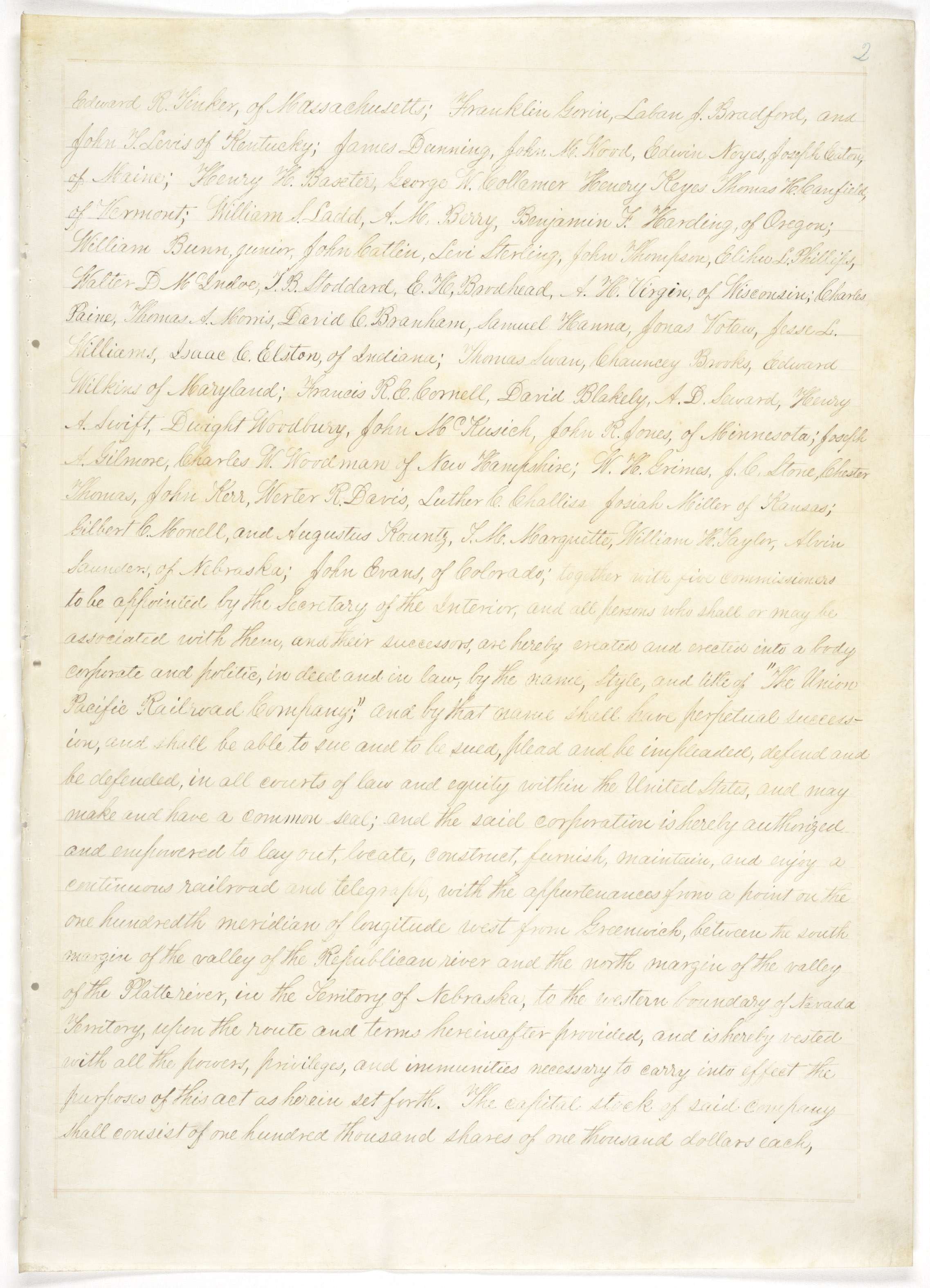
Act of July 1, 1862 (Pacific Railroad Act), 12 STAT 489, which established the construction of a railroad and telegraph line from the Missouri River to the Pacific Ocean.
Page 3
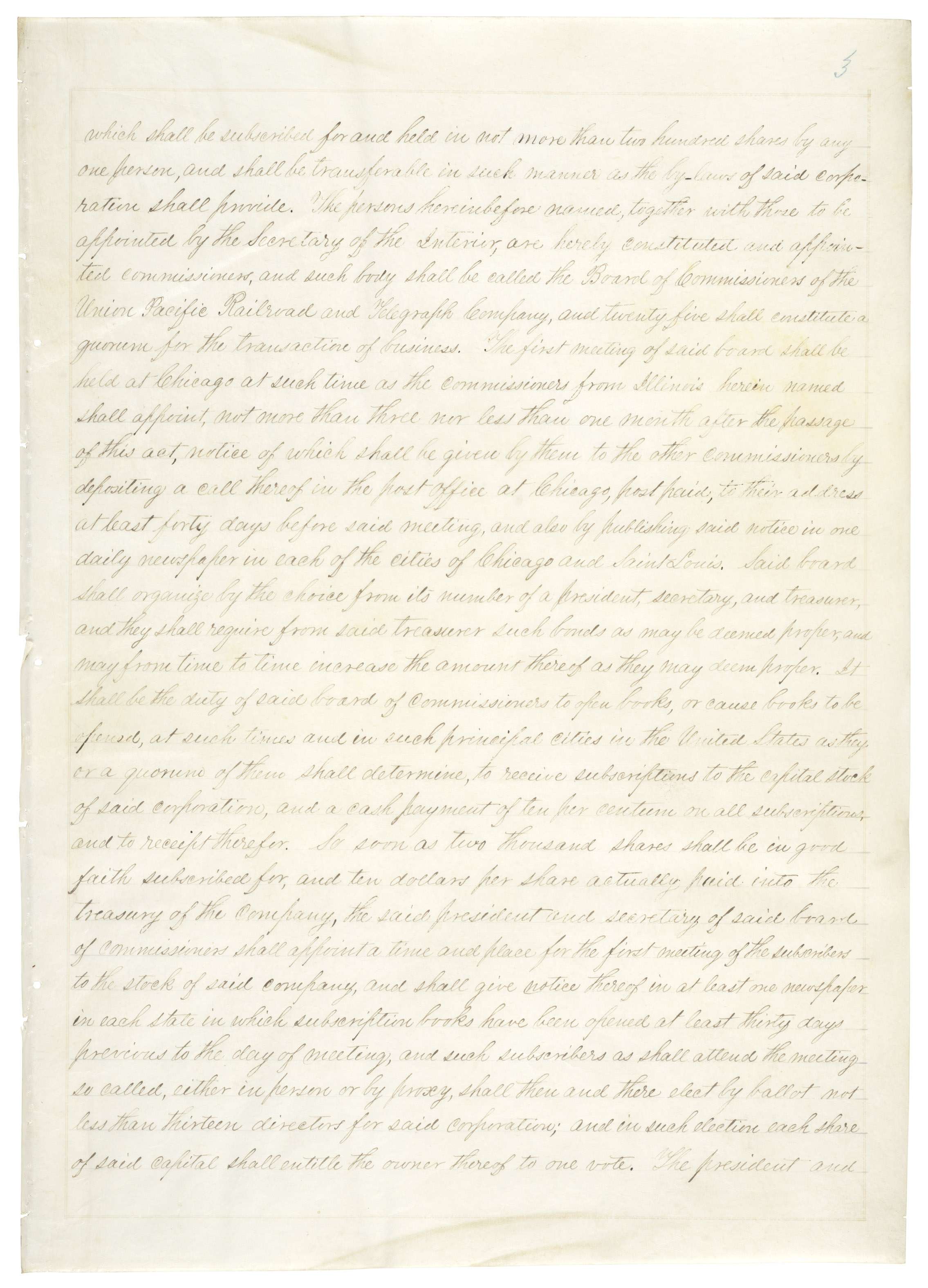
Act of July 1, 1862 (Pacific Railroad Act), 12 STAT 489, which established the construction of a railroad and telegraph line from the Missouri River to the Pacific Ocean.
Page 4
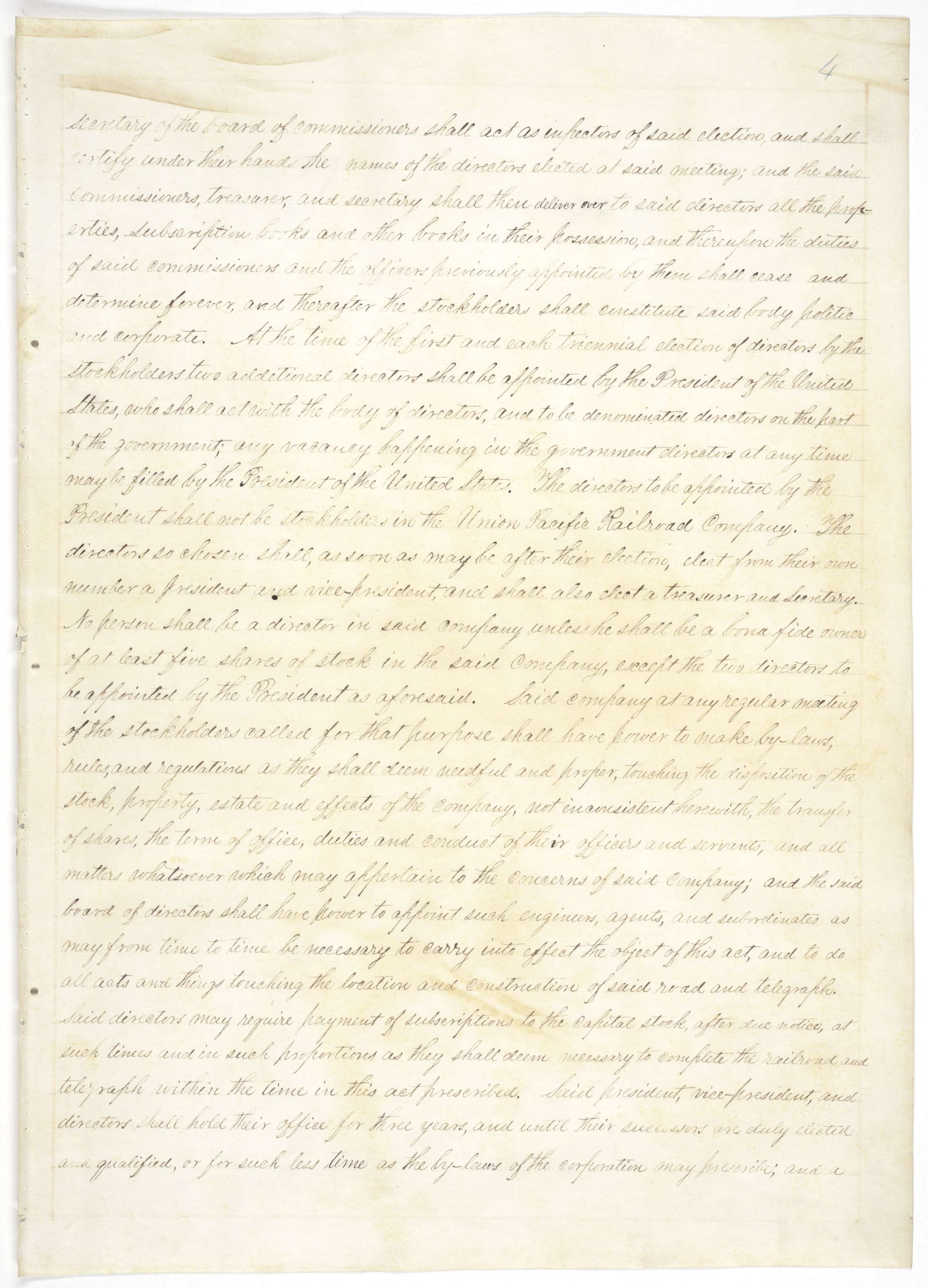
Act of July 1, 1862 (Pacific Railroad Act), 12 STAT 489, which established the construction of a railroad and telegraph line from the Missouri River to the Pacific Ocean.
Page 5
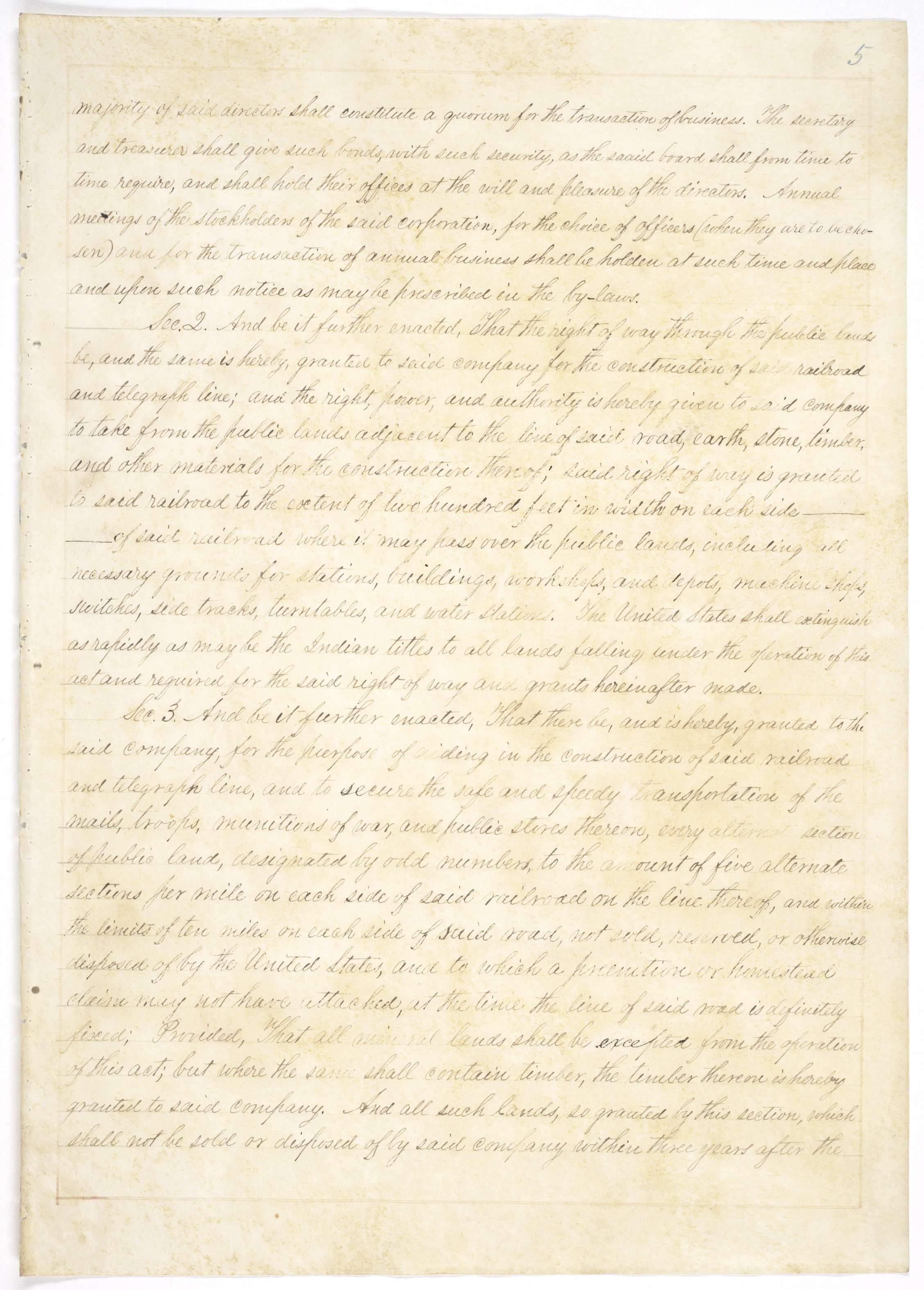
Act of July 1, 1862 (Pacific Railroad Act), 12 STAT 489, which established the construction of a railroad and telegraph line from the Missouri River to the Pacific Ocean.
Page 6
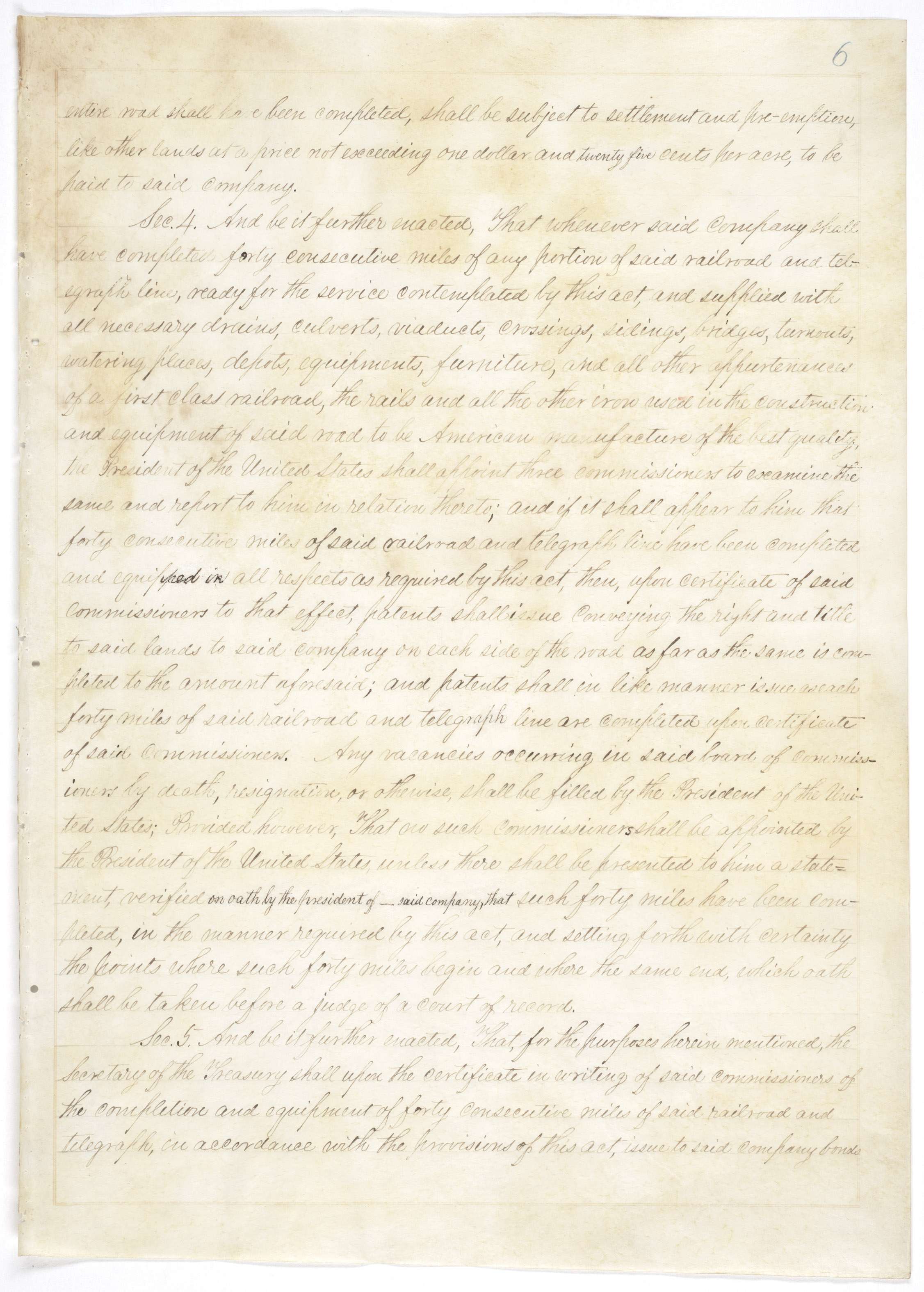
Act of July 1, 1862 (Pacific Railroad Act), 12 STAT 489, which established the construction of a railroad and telegraph line from the Missouri River to the Pacific Ocean.
Page 7
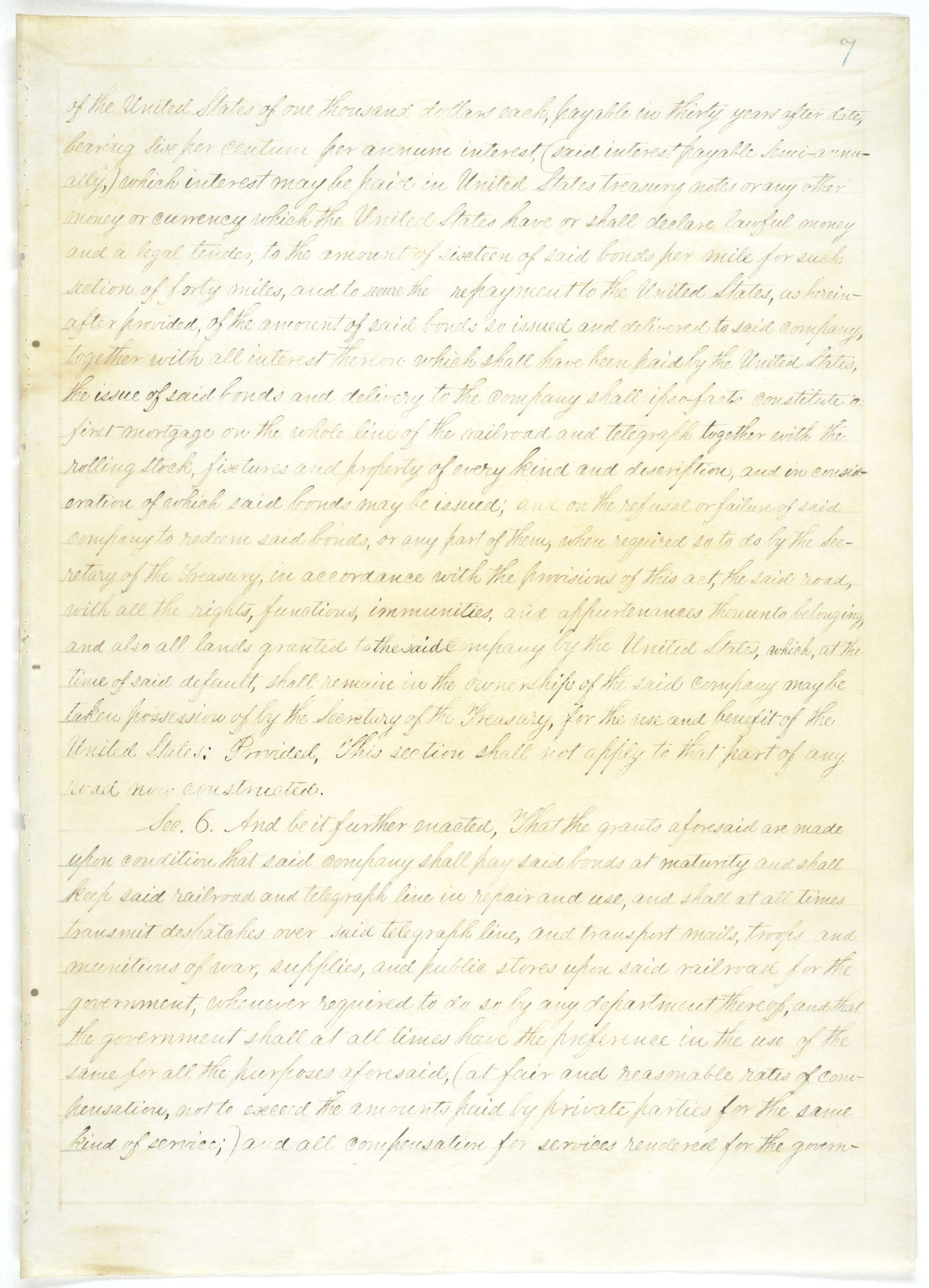
Act of July 1, 1862 (Pacific Railroad Act), 12 STAT 489, which established the construction of a railroad and telegraph line from the Missouri River to the Pacific Ocean.
Page 8

Act of July 1, 1862 (Pacific Railroad Act), 12 STAT 489, which established the construction of a railroad and telegraph line from the Missouri River to the Pacific Ocean.
Page 9
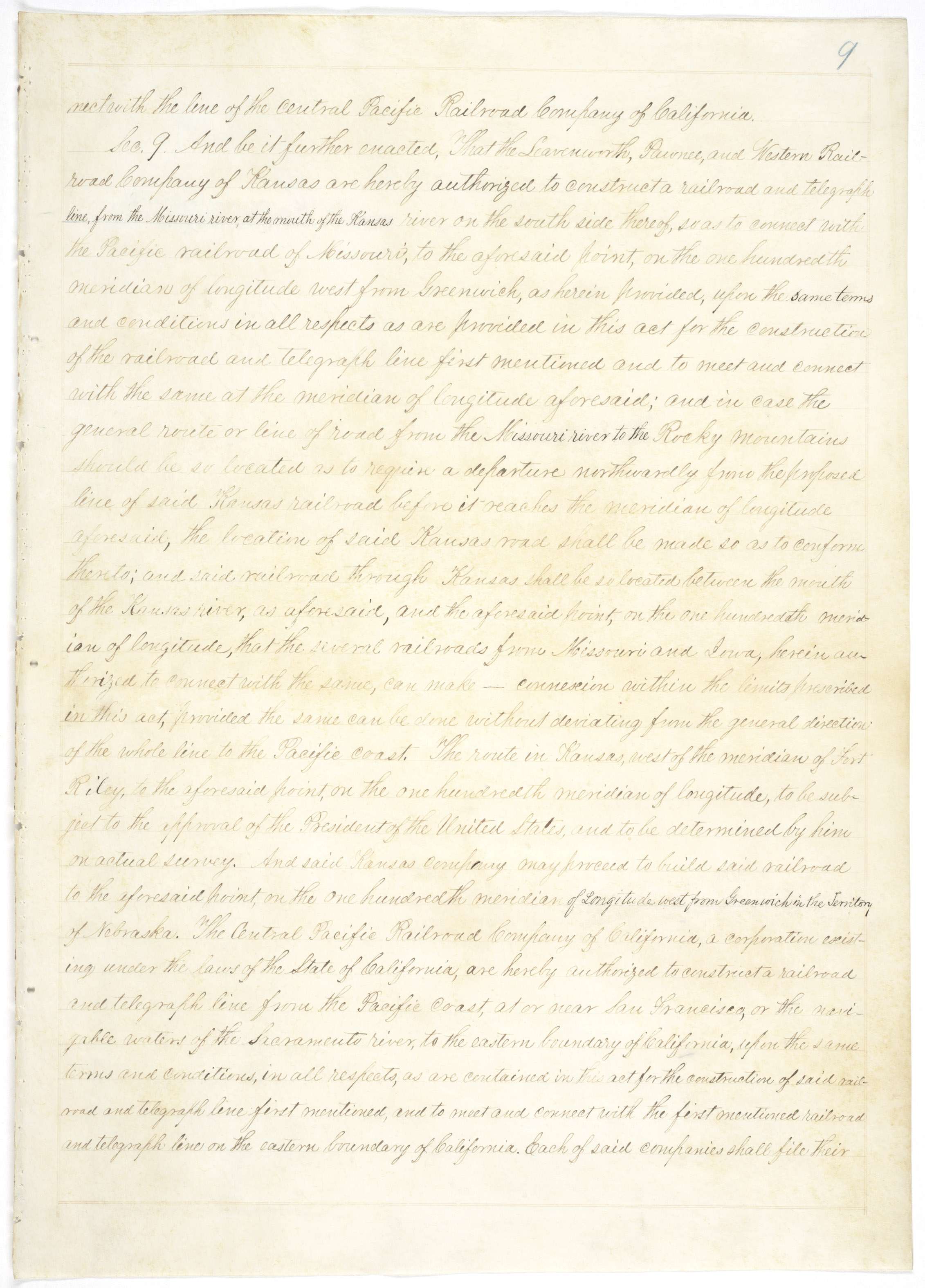
Act of July 1, 1862 (Pacific Railroad Act), 12 STAT 489, which established the construction of a railroad and telegraph line from the Missouri River to the Pacific Ocean.
Page 10
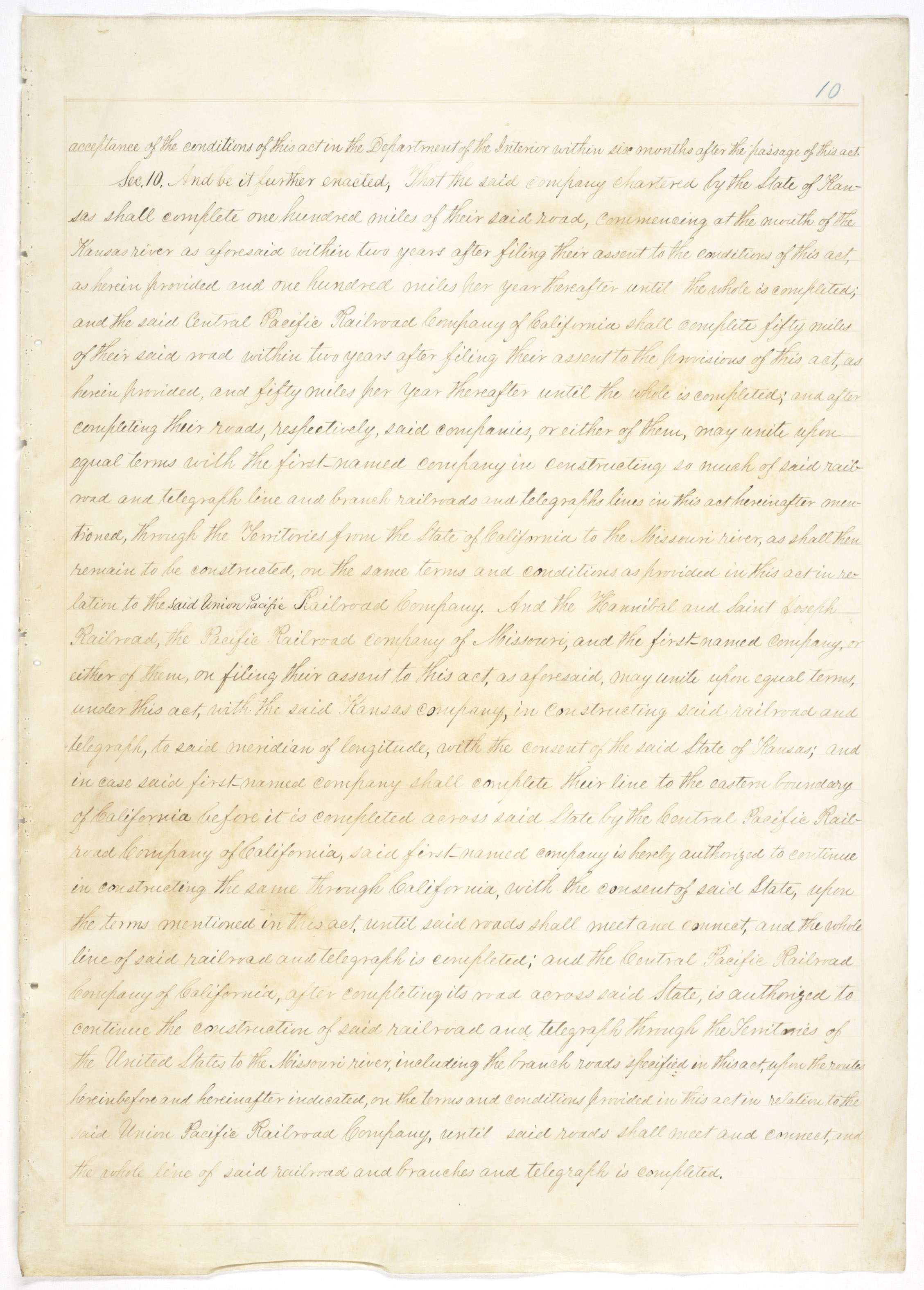
Act of July 1, 1862 (Pacific Railroad Act), 12 STAT 489, which established the construction of a railroad and telegraph line from the Missouri River to the Pacific Ocean.
Page 11
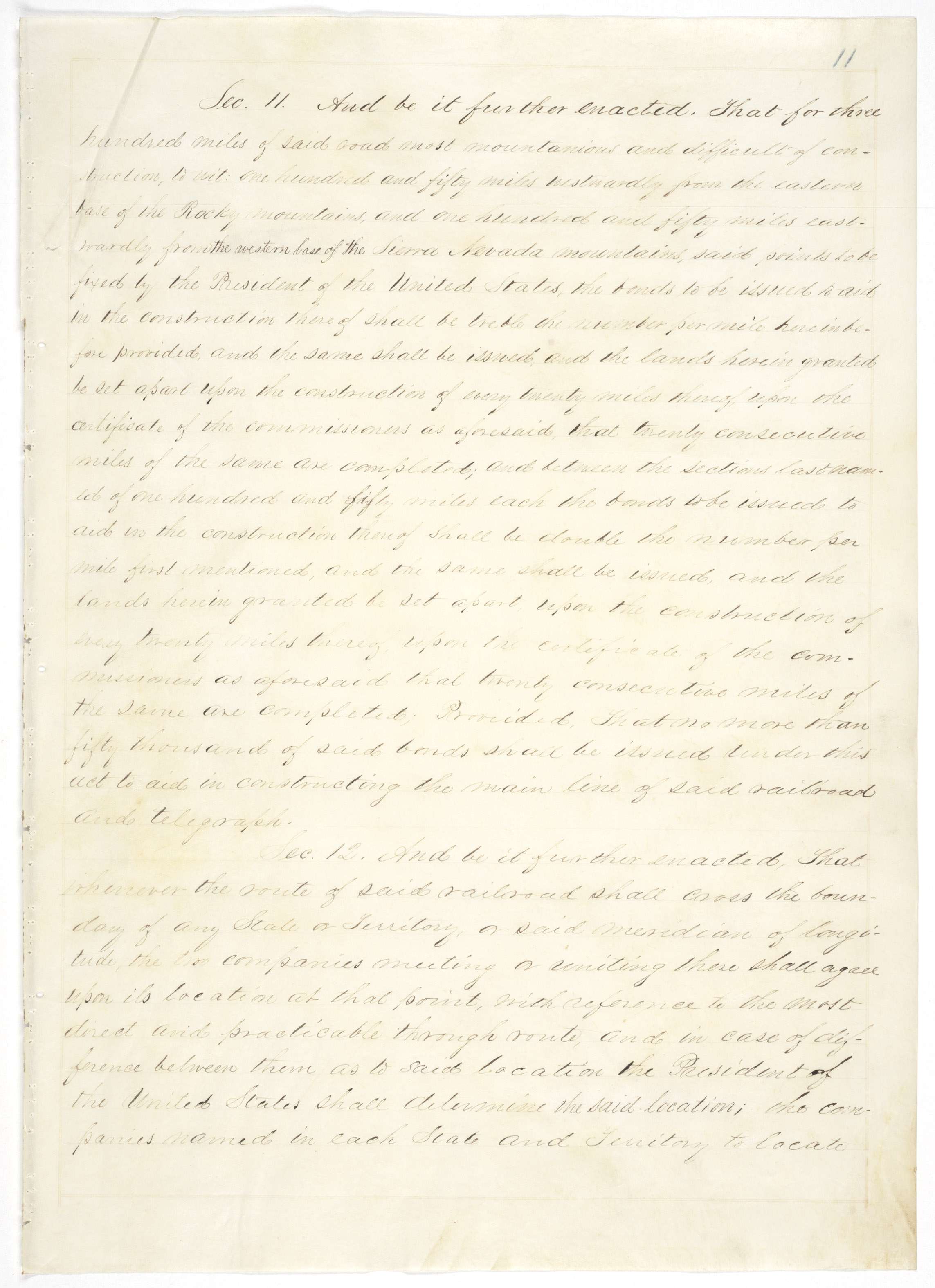
Act of July 1, 1862 (Pacific Railroad Act), 12 STAT 489, which established the construction of a railroad and telegraph line from the Missouri River to the Pacific Ocean.
Page 12
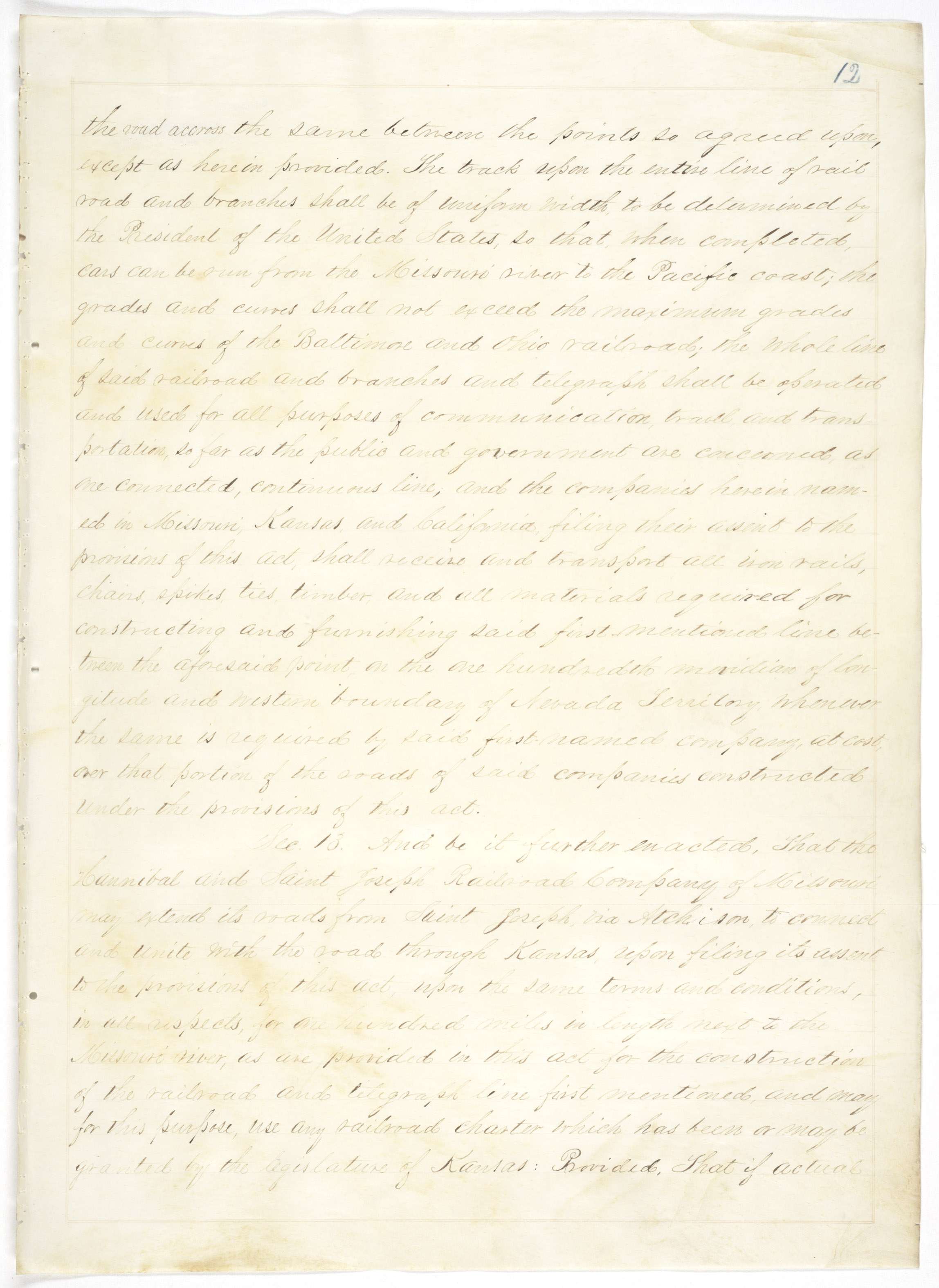
Act of July 1, 1862 (Pacific Railroad Act), 12 STAT 489, which established the construction of a railroad and telegraph line from the Missouri River to the Pacific Ocean.
Page 13
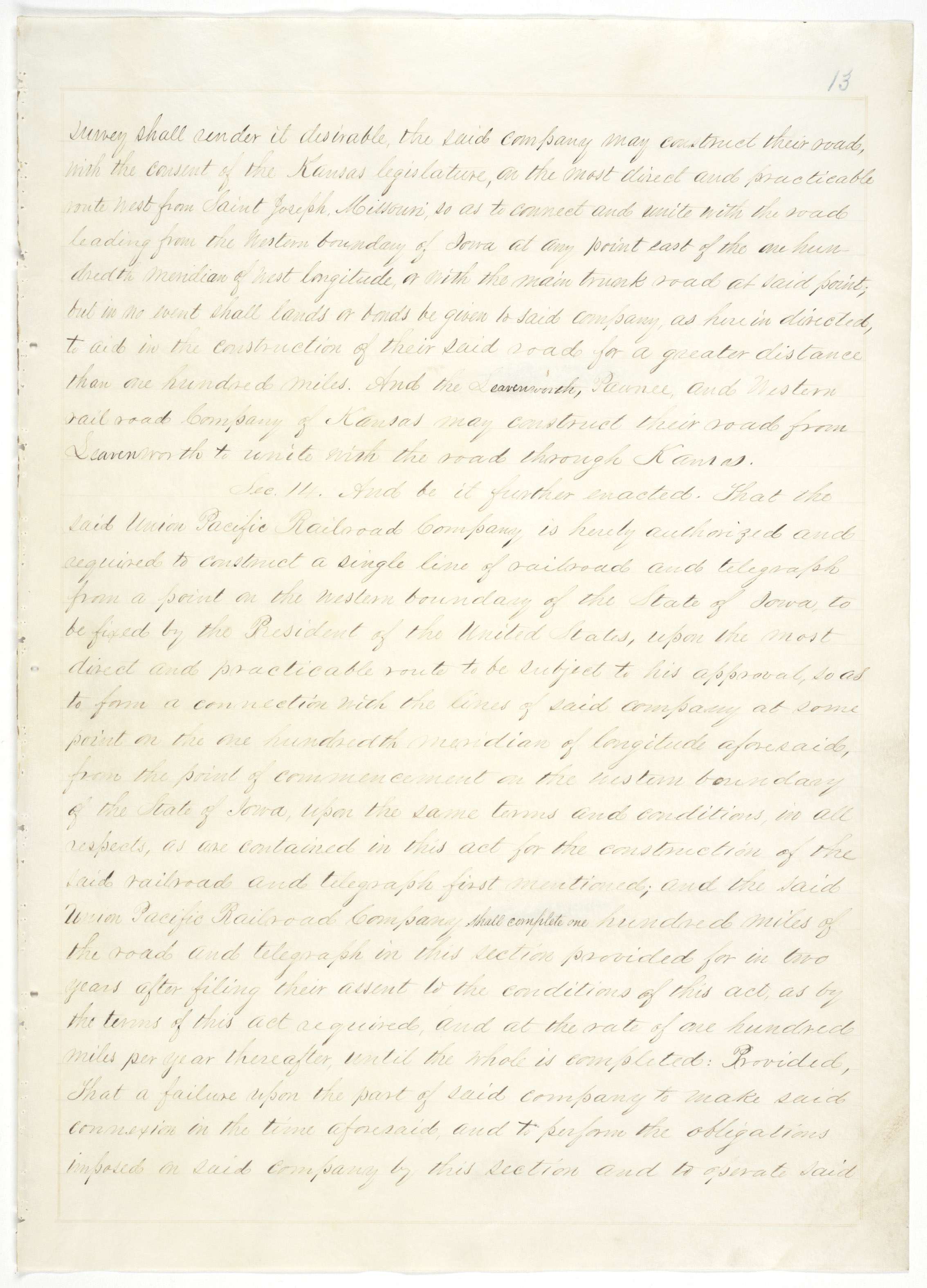
Act of July 1, 1862 (Pacific Railroad Act), 12 STAT 489, which established the construction of a railroad and telegraph line from the Missouri River to the Pacific Ocean.
Page 14

Act of July 1, 1862 (Pacific Railroad Act), 12 STAT 489, which established the construction of a railroad and telegraph line from the Missouri River to the Pacific Ocean.
Page 15
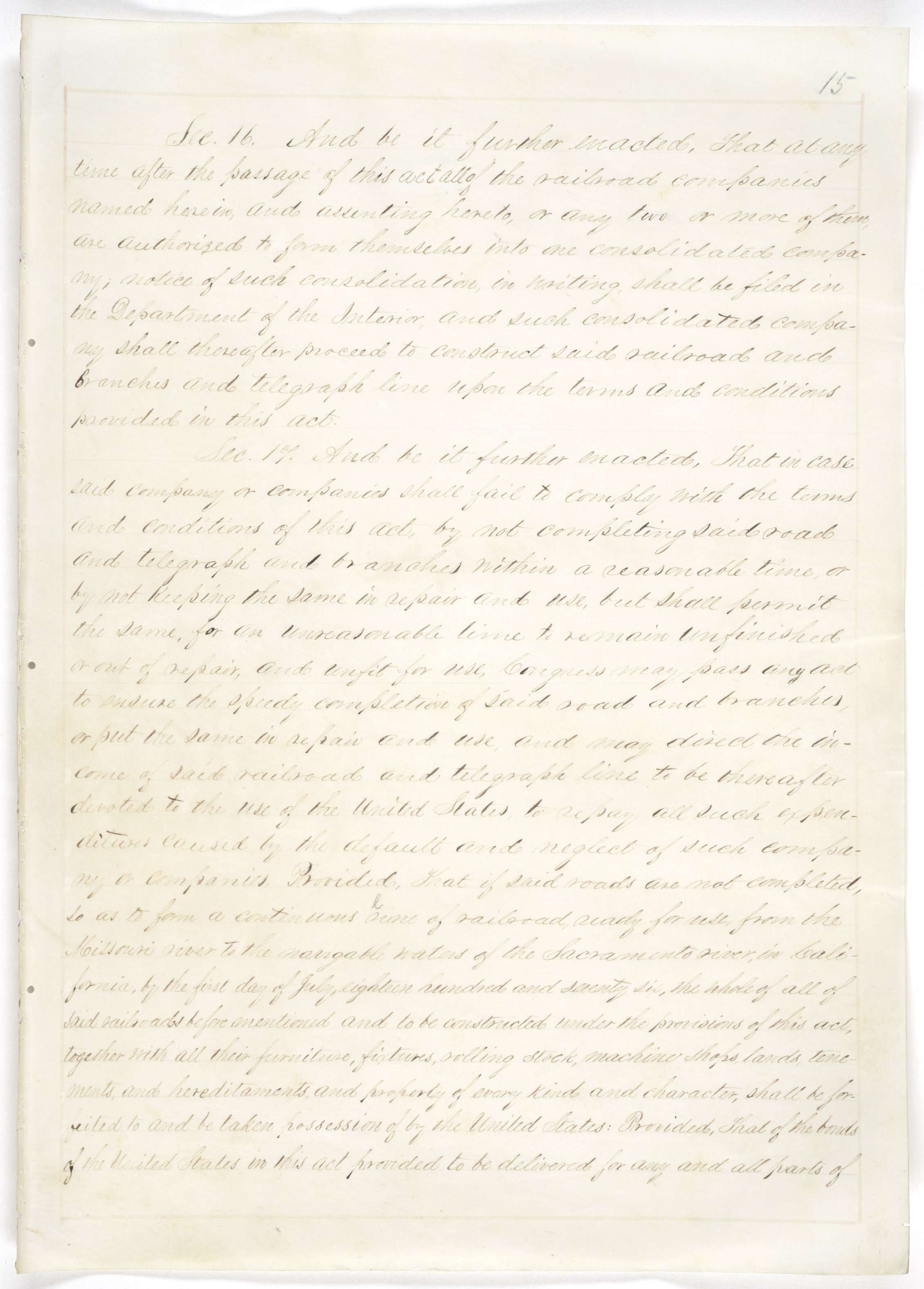
Act of July 1, 1862 (Pacific Railroad Act), 12 STAT 489, which established the construction of a railroad and telegraph line from the Missouri River to the Pacific Ocean.
Page 16
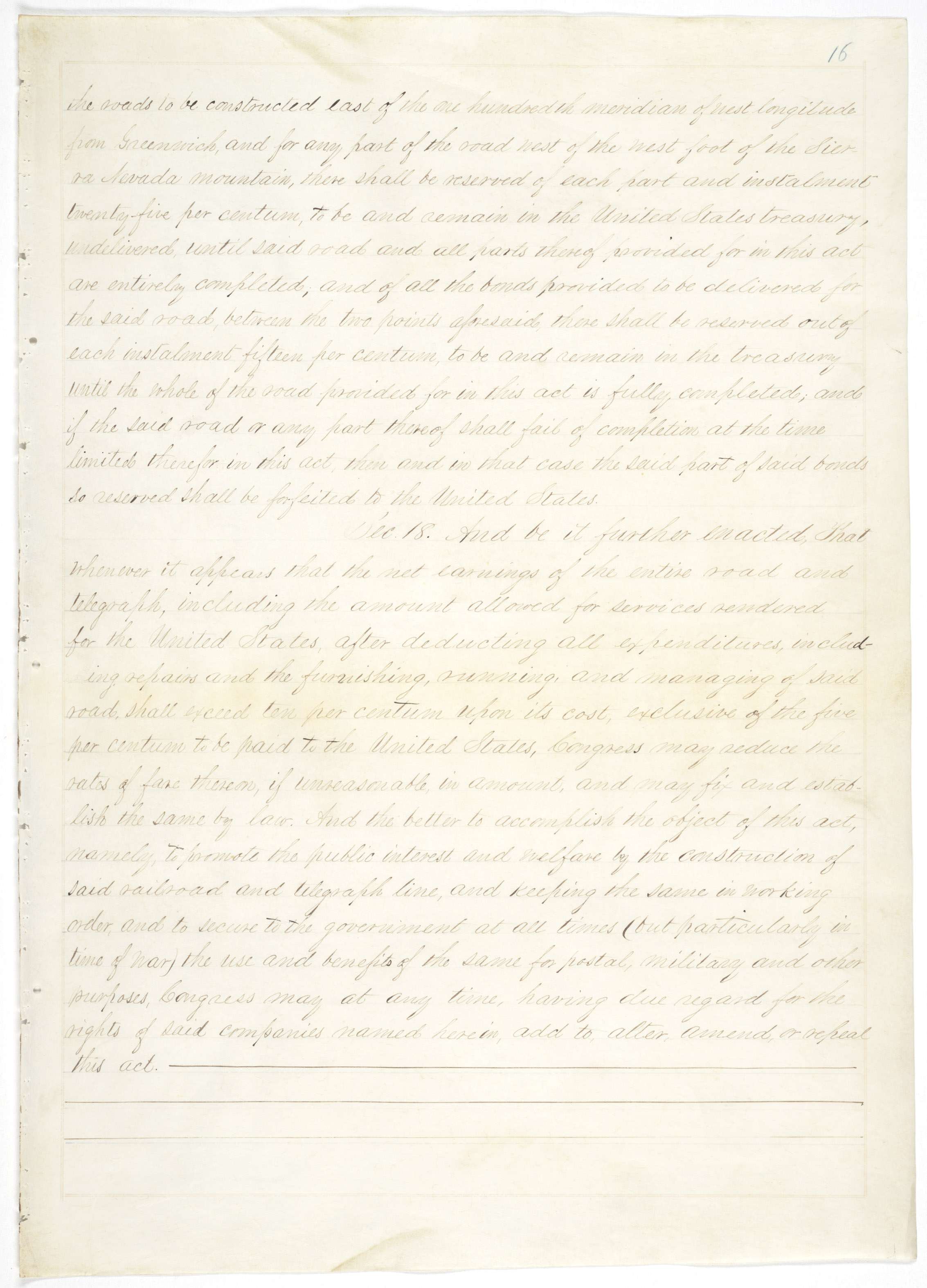
Act of July 1, 1862 (Pacific Railroad Act), 12 STAT 489, which established the construction of a railroad and telegraph line from the Missouri River to the Pacific Ocean.
Page 17
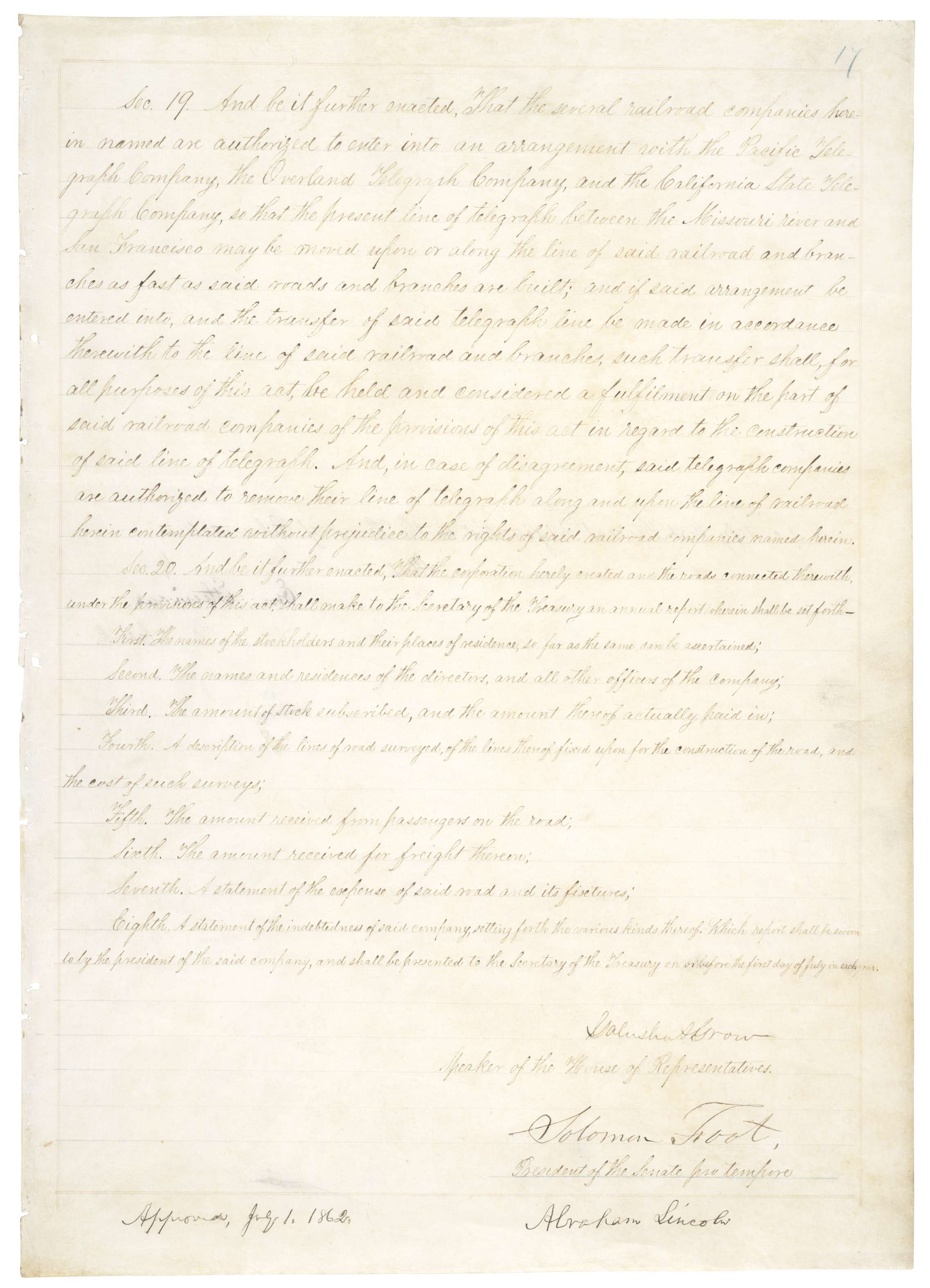
Document
Directors of the Union Pacific Railroad
1866
Directors of the Union Pacific Railroad
Page 2
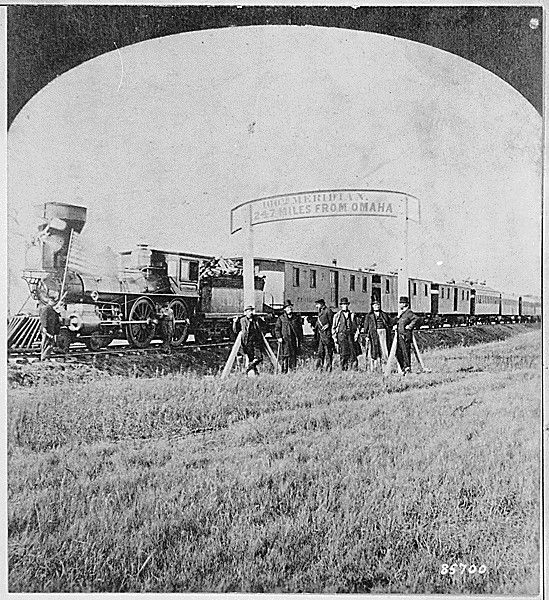
Document
Joining the Tracks for the First Transcontinental Railroad, Promontory, Utah, Terr., 1869
1869
Joining the Tracks for the First Transcontinental Railroad, Promontory, Utah, Terr., 1869
Page 1
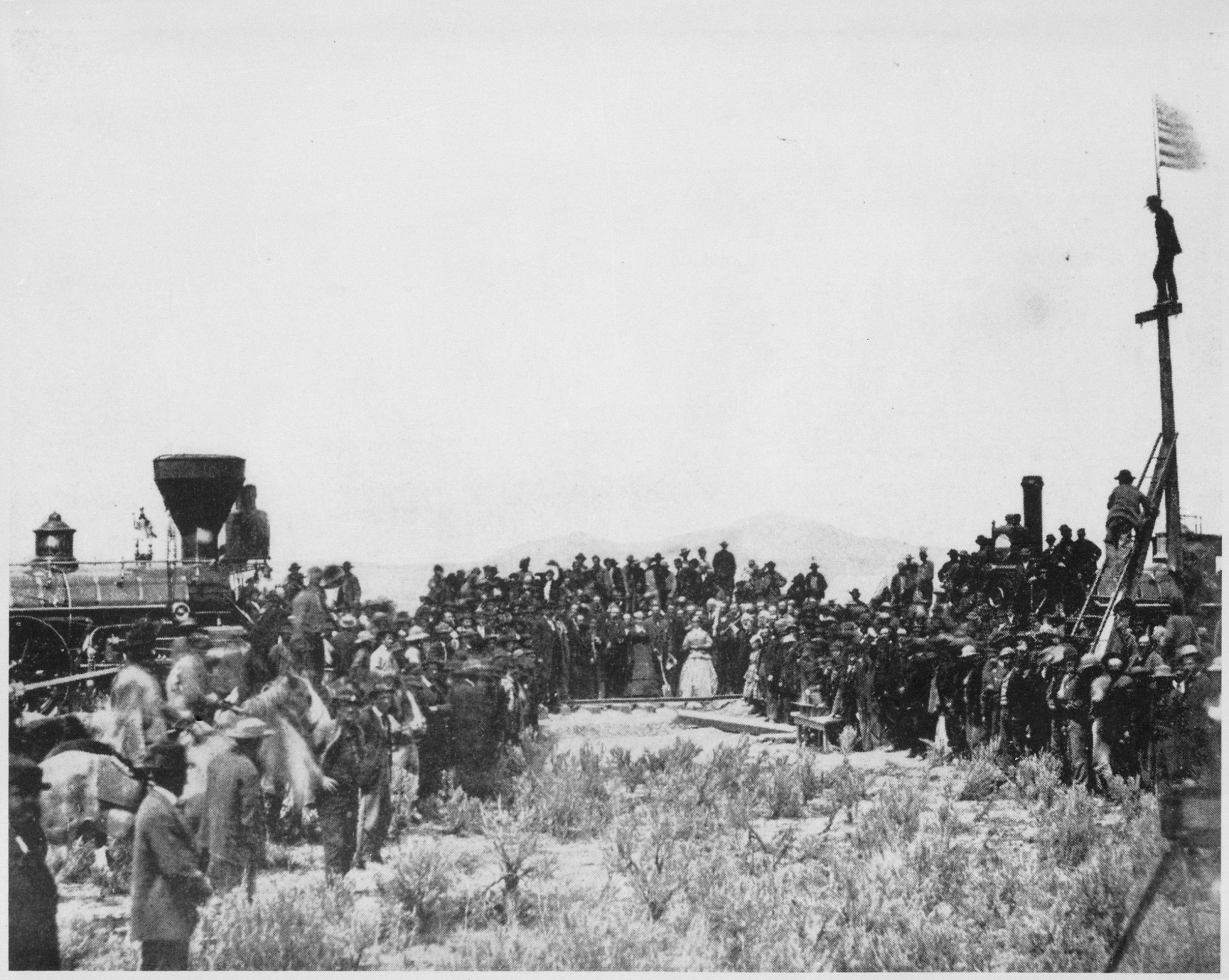
Document
Fort Laramie Treaty
4/29/1868
In the 19th century, the U.S. Government's drive for expansion clashed violently with Native Americans' resolve to preserve their lands, sovereignty, and ways of life. This struggle over land has defined the relationship between the U.S. Government and Native tribes.
From the 1860s through the 1870s, warfare and skirmishes broke out frequently on the American frontier. In 1865, a congressional committee studied the uprisings and wars in the American West. They produced a "Report on the Condition of the Indian Tribes" in 1867. This led to an act to establish an Indian Peace Commission to end the wars and prevent future conflicts.
The U.S. Government set out to establish a series of treaties with Native tribes that would force American Indians to give up their lands and move further west onto reservations. In the spring of 1868, a conference was held at Fort Laramie, in present-day Wyoming. Under the Indian Peace Commission, General William T. Sherman and his staff negotiated a peace treaty with the Sioux (Brule, Oglala, Miniconjou, Yanktonai, Hunkpapa, Blackfeet, Cuthead, Two Kettle, Sans Arcs, and Santee) and the Arapaho. At least one representative of each individual tribe signed the treaty at Fort Laramie, Wyoming.
The goal of the treaty was to bring peace between White settlers and the tribes, who agreed to relocate to the Black Hills in the Dakota Territory. All the tribes involved gave up many thousands of acres of land that had been promised in earlier treaties, but retained hunting and fishing rights in their older territory. They also agreed not to attack railroads or settlers.
In exchange, the U.S. Government established the Great Sioux Reservation, consisting of a large portion of the western half of what is now the state of South Dakota, including the Black Hills, which are sacred to the Sioux people.
Though the reservation land was set aside for exclusive use by the Sioux people, in 1874, General George A. Custer led an expedition into the Black Hills accompanied by miners who were seeking gold. Once gold was found in the Black Hills, miners were soon moving onto the Sioux hunting grounds and demanding protection from the U.S. Army. Soon, the Army was ordered to move against wandering bands of Sioux hunting on the range in accordance with their treaty rights.
In 1876, Custer, leading an Army detachment, encountered an encampment of Sioux and Cheyenne at the Little Bighorn River. Custer's detachment was annihilated, but the United States would continue its battle against the Sioux Tribe in the Black Hills until the government confiscated the land in 1877. To this day, ownership of the Black Hills remains the subject of a legal dispute between the U.S. Government and the Sioux Nation.
Treaties between the United States and American Indian tribes date back to the country's beginning. After the Revolutionary War, the United States had continued the European practice of negotiating treaties with the Native Peoples similarly to how they negotiated with foreign governments. This practice changed gradually over time.
In 1831, the Supreme Court case Cherokee Nation v. Georgia changed the status of Native tribes from "independent, sovereign nations" to "domestic dependent nations." Treaties, however, still followed the pattern of requiring negotiations between the U.S. government and tribal governments and ratification by Congress. Not all negotiated treaties were ratified.
In 1871, Congress passed the Indian Appropriations Act, which suspended all further treaties with Native governments. After that time, all changes or additions to Native lands or status were conducted by Executive Order, Acts of Congress, and decisions of the Federal Courts. To this day federally recognized American Indian tribes and Alaska Natives retain the right of self-government and usually hold a legal position directly under the federal government.
Transcript
ARTICLES OF A TREATY MADE AND CONCLUDED BY AND BETWEENLieutenant General William T. Sherman, General William S. Harney, General Alfred H. Terry, General O. O. Augur, J. B. Henderson, Nathaniel G. Taylor, John G. Sanborn, and Samuel F. Tappan, duly appointed commissioners on the part of the United States, and the different bands of the Sioux Nation of Indians, by their chiefs and headmen, whose names are hereto subscribed, they being duly authorized to act in the premises.
ARTICLE I.
From this day forward all war between the parties to this agreement shall for ever cease. The government of the United States desires peace, and its honor is hereby pledged to keep it. The Indians desire peace, and they now pledge their honor to maintain it.
If bad men among the whites, or among other people subject to the authority of the United States, shall commit any wrong upon the person or property of the Indians, the United States will, upon proof made to the agent, and forwarded to the Commissioner of Indian Affairs at Washington city, proceed at once to cause the offender to be arrested and punished according to the laws of the United States, and also reimburse the injured person for the loss sustained.
If bad men among the Indians shall commit a wrong or depredation upon the person or property of nay one, white, black, or Indian, subject to the authority of the United States, and at peace therewith, the Indians herein named solemnly agree that they
will, upon proof made to their agent, and notice by him, deliver up the wrongdoer to the United States, to be tried and punished according to its laws, and, in case they willfully refuse so to do, the person injured shall be reimbursed for his loss from the annuities, or other moneys due or to become due to them under this or other treaties made with the United States; and the President, on advising with the Commissioner of Indian Affairs, shall prescribe such rules and regulations for ascertaining damages under the provisions of this article as in his judgment may be proper, but no one sustaining loss while violating the provisions of this treaty, or the laws of the United States, shall be reimbursed therefor.
ARTICLE II.
The United States agrees that the following district of country, to wit, viz: commencing on the east bank of the Missouri river where the 46th parallel of north latitude crosses the same, thence along low-water mark down said east bank to a point opposite where the northern line of the State of Nebraska strikes the river, thence west across said river, and along the northern line of Nebraska to the 104th degree of longitude west from Greenwich, thence north on said meridian to a point where the 46th parallel of north latitude intercepts the same, thence due east along said parallel to the place of beginning; and in addition thereto, all existing reservations of the east back of said river, shall be and the same is, set apart for the absolute and undisturbed use and occupation of the Indians herein named,
and for such other friendly tribes or individual Indians as from time to time they may be willing, with the consent of the United States, to admit amongst them; and the United States now solemnly agrees that no persons, except those herein designated and authorized so to do, and except such officers, agents, and employees of the government as may be authorized to enter upon Indian reservations in discharge of duties enjoined by law, shall ever be permitted to pass over, settle upon, or reside in the territory described in this article, or in such territory as may be added to this reservation for the use of said Indians, and henceforth they will and do hereby relinquish all claims or right in and to any portion of the United States or Territories, except such as is embraced within the limits aforesaid, and except as hereinafter provided.
ARTICLE III.
If it should appear from actual survey or other satisfactory examination of said tract of land, that it contains less than 160 acres of tillable land, for each person, who at the time may be authorized to reside on it, under the provisions of this treaty, and a very considerable number of such persons shall be disposed to comence cultivating the soil as farmers, the United States agrees to set apart, for the use of said Indians, as herein provided, such additional quantity of arable land, adjoining to said reservation, or as
near to the same as it can be obtained, as may be required to provide the necessary amount.
ARTICLE IV.
The United States agrees, at its own proper expense, to construct, at some place on the Missouri river, near the centre of said reservation where timber and water may be convenient, the following buildings, to wit, a warehouse, a store-room for the use of the agent in storing goods belonging to the Indians, to cost not less than $2,500; an agency building, for the residence of the agent, to cost not exceeding $3,000; a residence for the physician, to cost not more than $3,000; and five other buildings, for a carpenter, farmer, blacksmith, miller, and engineer-each to cost not exceeding $2,000; also, a school-house, or mission building, so soon as a sufficient number of children can be induced by the agent to attend school, which shall not cost exceeding $5,000.
The United States agrees further to cause to be erected on said reservation, near the other buildings herein authorized, a good steam circular saw-mill, with a grist-mill and shingle machine attached to the same, to cost not exceeding $8,000.
ARTICLE V.
The United States agrees
that the agent for said Indians shall in the future make his home at the agency building; that he shall reside among them, and keep an office open at all times for the purpose of prompt and diligent inquiry into such matters of complaint by and against the Indians as may be presented for investigation under the provisions of their treaty stipulations, as also for the faithful discharge of other duties enjoined on him by law. In all cases of depredation on person or property he shall cause the evidence to be taken in writing and forwarded, together with his findings, to the Commissioner of Indian Affairs, whose decision, subject to the revision of the Secretary of the Interior, shall be binding on the parties to this treaty.
ARTICLE VI.
If any individual belonging to said tribes of Indians, or legally incorporated with them, being the head of a family, shall desire to commence farming, he shall have the privilege to select, in the presence and with the assistance of the agent then in charge, a tract of land within said reservation, not exceeding three hundred and twenty acres in extent, which tract, when so selected, certified, and recorded in the "Land Book" as herein directed, shall cease to be held in common, but the same may be occupied and held in the exclusive possession of the person selecting it, and of his family, so long as he or they may
continue to cultivate it.
Any person over eighteen years of age, not being the head of a family, may in like manner select and cause to be certified to him or her, for purposes of cultivation, a quantity of land, not exceeding eighty acres in extent, and thereupon be entitled to the exclusive possession of the same as above directed.
For each tract of land so selected a certificate, containing a description thereof and the name of the person selecting it, with a certificate endorsed thereon that the same has been recorded, shall be delivered to the party entitled to it, by the agent, after the same shall have been recorded by him in a book to be kept in his office, subject to inspection, which said book shall be known as the "Sioux Land Book."
The President may, at any time, order a survey of the reservation, and, when so surveyed, Congress shall provide for protecting the rights of said settlers in their improvements, and may fix the character of the title held by each. The United States may pass such laws on the subject of alienation and descent of property between the Indians and their descendants as may be thought proper. And it is further stipulated that any
male Indians over eighteen years of age, of any band or tribe that is or shall hereafter become a party to this treaty, who now is or who shall hereafter become a resident or occupant of any reservation or territory not included in the tract of country designated and described in this treaty for the permanent home of the Indians, which is not mineral land, nor reserved by the United States for special purposes other than Indian occupation, and who shall have made improvements thereon of the value of two hundred dollars or more, and continuously occupied the same as a homestead for the term of three years, shall be entitled to receive from the United States a patent for one hundred and sixty acres of land including his said improvements, the same to be in the form of the legal subdivisions of the surveys of the public lands. Upon application in writing, sustained by the proof of two disinterested witnesses, made to the register of the local land office when the land sought to be entered is within a land district, and when the tract sought to be entered is not in any land district, then
upon said application and proof being made to the Commissioner of the General Land Office, and the right of such Indian or Indians to enter such tract or tracts of land shall accrue and be perfect from the date of his first improvements thereon, and shall continue as long as be continues his residence and improvements and no longer. And any Indian or Indians receiving a patent for land under the foregoing provisions shall thereby and from thenceforth become and be a citizen of the United States and be entitled to all the privileges and immunities of such citizens, and shall, at the same time, retain all his rights to benefits accruing to Indians under this treaty.
ARTICLE VII.
In order to insure the
civilization of the Indians entering into this treaty, the necessity of education is admitted, especially of such of them as are or may be settled on said agricultural reservations, and they, therefore, pledge themselves to compel their children, male and female, between the ages of six and sixteen years, to attend school, and it is hereby made the duty of the agent for said Indians to see that this stipulation is strictly complied with; and the United States agrees that for every thirty children between said ages, who can be induced or compelled to attend school, a house shall be provided, and a teacher competent to teach the elementary branches of an English education shall be furnished, who will reside among said Indians and faithfully discharge his or her duties as a teacher. The provisions of this article to continue for not less than twenty years.
ARTICLE VIII.
When the head of a family or lodge shall have selected lands and received his certificate as above directed, and the agent shall be satisfied that he intends in good faith to commence cultivating the soil for a living, he shall be entitled to receive seeds and agricultural implements for the first year, not exceeding in value one hundred dollars, and for each succeeding year he shall continue to farm,
for a period of three years more, he shall be entitled to receive seeds and implements as aforesaid, not exceeding in value twenty-five dollars. And it is further stipulated that such persons as commence farming shall receive instruction from the farmer herein provided for, and whenever more than one hundred persons shall enter upon the cultivation of the soil, a second blacksmith shall be provided, with such iron, steel, and other material as may be needed.
ARTICLE IX.
At any time after ten years fro the making of this treaty, the United States shall have the privilege of withdrawing the physician, farmer, blacksmith, carpenter, engineer, and miller herein provided for, but in case of such withdrawal, an additional sum thereafter of ten thousand dollars per annum shall be devoted to the education of said Indians, and the Commissioner of Indian Affairs shall, upon careful inquiry into their condition, make such rules and regulations for the expenditure of said sums as will best promote the education and moral improvement of said tribes.
ARTICLE X.
In lieu of all sums of money or other annuities provided to be paid
to the Indians herein named under any treaty or treaties heretofore made, the United States agrees to deliver at the agency house on the reservation herein named, on or before the first day of August of each year, for thirty years, the following articles, to wit:
For each male person over 14 years of age, a suit of good substantial woollen clothing, consisting of coat, pantaloons, flannel shirt, hat, and a pair of home-made socks.
For each female over 12 years of age, a flannel shirt, or the goods necessary to make it, a pair of woollen hose, 12 yards of calico, and 12 yards of cotton domestics.
For the boys and girls under the ages named, such flannel and cotton goods as may be needed to make each a suit as aforesaid, together with a pair of woollen hose for each.
And in order that the Commissioner of Indian Affairs may be able to estimate properly for the articles herein named, it shall be the duty of the agent each year to forward to him a full and exact census of the Indians, on which the estimate from year to year can be based.
And in addition to the clothing herein named, the sum of $10 for each person entitled to the beneficial effects of this treaty shall be annually appropriated for a
period of 30 years, while such persons roam and hunt, and $20 for each person who engages in farming, to be used by the Secretary of the Interior in the purchase of such articles as from time to time the condition and necessities of the Indians may indicate to be proper. And if within the 30 years, at any time, it shall appear that the amount of money needed for clothing, under this article, can be appropriated to better uses for the Indians named herein, Congress may, by law, change the appropriation to other purposes, but in no event shall the amount of the appropriation be withdrawn or discontinued for the period named. And the President shall annually detail an officer of the army to be present and attest the delivery of all the goods herein named, to the Indians, and he shall inspect and report on the quantity and quality of the goods and the manner of their delivery. And it is hereby expressly stipulated that each Indian over the age of four years, who shall have removed to and settled permanently upon said reservation, one pound of meat and one pound of flour per day, provided the Indians cannot furnish their own subsistence at an earlier date. And it is further stipulated that the United States will furnish and deliver to each lodge of Indians or family of persons legally incorporated with the, who shall remove to the reservation herein described and commence farming, one good American cow, and one good well-broken pair of American oxen within 60 days after such lodge or family shall have so settled upon said reservation.
ARTICLE XI.
In consideration of the advantages and benefits conferred by this treaty and the many pledges of friendship by the United States, the tribes who are parties to this agreement hereby stipulate that they will relinquish all right to occupy permanently the territory outside
their reservations as herein defined, but yet reserve the right to hunt on any lands north of North Platte, and on the Republican Fork of the Smoky Hill river, so long as the buffalo may range thereon in such numbers as to justify the chase. And they, the said Indians, further expressly agree:
1st. That they will withdraw all opposition to the construction of the railroads now being built on the plains.
2d. That they will permit the peaceful construction of any railroad not passing over their reservation as herein defined.
3d. That they will not attack any persons at home, or travelling, nor molest or disturb any wagon trains, coaches, mules, or cattle belonging to the people of the United S
tates, or to persons friendly therewith.
4th. They will never capture, or carry off from the settlements, white women or children.
5th. They will never kill or scalp white men, nor attempt to do them harm.
6th. They withdraw all pretence of opposition to the construction of the railroad now being built along the Platte river and westward to the Pacific ocean, and they will not in future object to the construction of railroads, wagon roads, mail stations, or other works of utility or necessity, which may be ordered or permitted by the laws of the United States. But should such roads or other works be constructed on the lands of their reservation, the government will pay the tribe whatever amount of damage may be assessed by three disinterested commissioners to be appointed by the President for that purpose, one of the said commissioners to be a chief or headman of the tribe.
7th. They agree to withdraw all opposition to the military posts or roads now established south of the North Platte river, or that may be established, not in violation of treaties heretofore made or hereafter to be made with any of the Indian tribes.
ARTICLE XII.
No treaty for the cession of any portion or part of the reservation herein described which may be held in common, shall be of any validity or force as against the said Indians unless executed and signed by at least three-fourths of all the adult male Indians occupying or interested in the same, and no cession by the tribe shall be understood or construed in such manner as to deprive, without his consent, any individual member of the tribe of his rights to any tract of land selected by him as provided in Article VI of this treaty.
ARTICLE XIII.
The United States hereby agrees to furnish annually to the Indians the physician, teachers, carpenter, miller, engineer, farmer, and blacksmiths, as herein contemplated, and that such appropriations shall be made from time to time, on the estimate of the Secretary of the Interior, as will be sufficient to employ such persons.
ARTICLE XIV.
It is agreed that the sum of five hundred dollars annually for three years from date shall be expended in presents to the ten persons of said tribe who in the judgment of the agent may grow the most valuable crops for the respective year.
ARTICLE XV.
The Indians herein named agree that when the agency house and other buildings shall be constructed on the reservation named, they will regard said reservation their permanent home, and they will make no permanent settlement elsewhere; but they shall have the right, subject to the conditions and modifications of this treaty, to hunt, as stipulated in Article XI hereof.
ARTICLE XVI.
The United States hereby agrees and stipulates that the country north of the North Platte river and east of the summits of the Big Horn mountains shall be held and considered to be unceded. Indian territory, and also stipulates and agrees that no white person or persons shall be permitted to settle upon or occupy any portion of the same; or without the consent of the Indians, first had and obtained, to pass through the same; and it is further agreed by the United States, that within ninety days after the conclusion of peace with all the bands of the Sioux nation, the military posts now established in the territory in this article named shall be abandoned, and that the road leading to them and by them to the settlements in the Territory of Montana shall be closed.
ARTICLE XVII.
It is hereby expressly understood and agreed by and between the respective parties to this treaty that the execution of this treaty and its ratification by the United States Senate shall have the effect, and shall be construed as abrogating and annulling all treaties and agreements heretofore entered into between the respective parties hereto, so far as such treaties and agreements obligate the United States to furnish and provide money, clothing, or other articles of property to such Indians and bands of Indians as become parties to this treaty, but no further.
In testimony of all which, we, the said commissioners, and we, the chiefs and headmen of the Brule band of the Sioux nation, have hereunto set our hands and seals at Fort Laramie, Dakota Territory, this twenty-ninth day of April, in the year one thousand eight hundred and sixty-eight.
N. G. TAYLOR,
W. T. SHERMAN,
Lieutenant General
WM. S. HARNEY,
Brevet Major General U.S.A.
JOHN B. SANBORN,
S. F. TAPPAN,
C. C. AUGUR,
Brevet Major General
ALFRED H. TERRY,
Brevet Major General U.S.A.
Attest:
A. S. H. WHITE, Secretary.
Executed on the part of the Brule band of Sioux by the chiefs and headman whose names are hereto annexed, they being thereunto duly authorized, at Fort Laramie, D. T., the twenty-ninth day of April, in the year A. D. 1868.
MA-ZA-PON-KASKA, his X mark, Iron Shell.
WAH-PAT-SHAH, his X mark, Red Leaf.
HAH-SAH-PAH, his X mark, Black Horn.
ZIN-TAH-GAH-LAT-WAH, his X mark, Spotted Tail.
ZIN-TAH-GKAH, his X mark, White Tail.
ME-WAH-TAH-NE-HO-SKAH, his X mark, Tall Man.
SHE-CHA-CHAT-KAH, his X mark, Bad Left Hand.
NO-MAH-NO-PAH, his X mark, Two and Two.
TAH-TONKA-SKAH, his X mark, White Bull.
CON-RA-WASHTA, his X mark, Pretty Coon.
HA-CAH-CAH-SHE-CHAH, his X mark, Bad Elk.
WA-HA-KA-ZAH-ISH-TAH, his X mark, Eye Lance.
MA-TO-HA-KE-TAH, his X mark, Bear that looks behind.
BELLA-TONKA-TONKA, his X mark, Big Partisan.
MAH-TO-HO-HONKA, his X mark, Swift Bear.
TO-WIS-NE, his X mark, Cold Place.
ISH-TAH-SKAH, his X mark, White Eye.
MA-TA-LOO-ZAH, his X mark, Fast Bear.
AS-HAH-HAH-NAH-SHE, his X mark, Standing Elk.
CAN-TE-TE-KI-YA, his X mark, The Brave Heart.
SHUNKA-SHATON, his X mark, Day Hawk.
TATANKA-WAKON, his X mark, Sacred Bull.
MAPIA SHATON, his X mark, Hawk Cloud.
MA-SHA-A-OW, his X mark, Stands and Comes.
SHON-KA-TON-KA, his X mark, Big Dog.
Attest:
ASHTON S. H. WHITE, Secretary of Commission.
GEORGE B. WITHS, Phonographer to Commission.
GEO. H. HOLTZMAN.
JOHN D. HOWLAND.
JAMES C. O'CONNOR.
CHAR. E. GUERN, Interpreter.
LEON T. PALLARDY, Interpreter.
NICHOLAS JANIS, Interpreter.
Executed on the part of the Ogallalla band of Sioux by the chiefs and headmen whose names are hereto subscribed, they being thereunto duly authorized, at Fort Laramie, the 25th day of May, in the year A. D. 1868.
TAH-SHUN-KA-CO-QUI-PAH, his mark, Man-afraid-of-his-horses.
SHA-TON-SKAH, his X mark, White Hawk.
SHA-TON-SAPAH, his X mark, Black Hawk.
EGA-MON-TON-KA-SAPAH, his X mark, Black Tiger
OH-WAH-SHE-CHA, his X mark, Bad Wound.
PAH-GEE, his X mark, Grass.
WAH-NON SAH-CHE-GEH, his X mark, Ghost Heart.
COMECH, his X mark, Crow.
OH-HE-TE-KAH, his X mark, The Brave.
TAH-TON-KAH-HE-YO-TA-KAH, his X mark, Sitting Bull.
SHON-KA-OH-WAH-MEN-YE, his X mark, Whirlwind Dog.
HA-KAH-KAH-TAH-MIECH, his X mark, Poor Elk.
WAM-BU-LEE-WAH-KON, his X mark, Medicine Eagle.
CHON-GAH-MA-HE-TO-HANS-KA, his X mark, High Wolf.
WAH-SECHUN-TA-SHUN-KAH, his X mark, American Horse.
MAH-KAH-MAH-HA-MAK-NEAR, his X mark, Man that walks under the ground.
MAH-TO-TOW-PAH, his X mark, Four Bears.
MA-TO-WEE-SHA-KTA, his X mark, One that kills the bear.
OH-TAH-KEE-TOKA-WEE-CHAKTA, his X mark, One that kills in a hard place.
TAH-TON-KAH-TA-MIECH, his X mark, The Poor Bull.
OH-HUNS-EE-GA-NON-SKEN, his X mark, Mad Shade.
SHAH-TON-OH-NAH-OM-MINNE-NE-OH-MINNE, his X mark, Whirling hawk.
MAH-TO-CHUN-KA-OH, his X mark, Bear's Back.
CHE-TON-WEE-KOH, his X mark, Fool Hawk.
WAH-HOH-KE-ZA-AH-HAH, his X mark,
EH-TON-KAH, his X mark, Big Mouth.
MA-PAH-CHE-TAH, his X mark, Bad Hand.
WAH-KE-YUN-SHAH, his X mark, Red Thunder.
WAK-SAH, his X mark, One that Cuts Off.
CHAH-NOM-QUI-YAH, his X mark, One that Presents the Pipe.
WAH-KE-KE-YAN-PUH-TAH, his X mark, Fire Thunder.
MAH-TO-NONK-PAH-ZE, his X mark, Bear with Yellow Ears.
CON-REE-TEH-KA, his X mark, The Little Crow.
HE-HUP-PAH-TOH, his X mark, The Blue War Club.
SHON-KEE-TOH, his X mark, The Blue Horse.
WAM-BALLA-OH-CONQUO, his X mark, Quick Eagle.
TA-TONKA-SUPPA, his X mark, Black Bull.
MOH-TOH-HA-SHE-NA, his X mark, The Bear Hide.
Attest:
S. E. WARD.
JAS. C. O'CONNOR.
J. M. SHERWOOD.
W. C. SLICER.
SAM DEON.
H. M. MATHEWS.
JOSEPH BISS
NICHOLAS JANIS, Interpreter.
LEFROY JOTT, Interpreter.
ANTOINE JANIS, Interpreter.
Executed on the part of the Minneconjou band of Sioux by the chiefs and headmen whose names are hereunto subscribed, they being thereunto duly authorized.
HEH-WON-GE-CHAT, his X mark, One Horn.
OH-PON-AH-TAH-E-MANNE, his X mark, The Elk that Bellows Walking.
HEH-HO-LAH-ZEH-CHA-SKAH, his X mark, Young White Bull.
WAH-CHAH-CHUM-KAH-COH-KEEPAH, his X mark, One that is Afraid of Shield.
HE-HON-NE-SHAKTA, his X mark, The Old Owl.
MOC-PE-A-TOH, his X mark, Blue Cloud.
OH-PONG-GE-LE-SKAH, his X mark, Spotted Elk.
TAH-TONK-KA-HON-KE-SCHUE, his X mark, Slow bull.
SHONK-A-NEE-SHAH-SHAH-ATAH-PE, his X mark, The Dog Chief.
MA-TO-TAH-TA-TONK-KA, his X mark, Bull Bear.
WOM-BEH-LE-TON-KAH, his X mark, The Big Eagle.
MATOH, EH-SCHNE-LAH, his X mark, The Lone Bear.
MA-TOH-OH-HE-TO-KEH, his X mark, The Brave Bear.
EH-CHE-MA-KEH, his X mark, The Runner.
TI-KI-YA, his X mark, The Hard.
HE-MA-ZA, his X mark, Iron Horn.
Attest:
JAS. C O'CONNOR,
WM. D. BROWN,
NICHOLAS JANIS,
ANTOINE JANIS,
Interpreters.
Executed on the part of the Yanctonais band of Sioux by the chiefs and headmen whose names are hereto subscribed, they being thereunto duly authorized:
MAH-TO-NON-PAH, his X mark, Two Bears.
MA-TO-HNA-SKIN-YA, his X mark, Mad Bear.
HE-O-PU-ZA, his X mark, Louzy.
AH-KE-CHE-TAH-CHE-KA-DAN, his X mark, Little Soldier.
MAH-TO-E-TAN-CHAN, his X mark, Chief Bear.
CU-WI-TO-WIA, his X mark, Rotten Stomach.
SKUN-KA-WE-TKO, his X mark, Fool Dog.
ISH-TA-SAP-PAH, his X mark, Black Eye.
IH-TAN-CHAN, his X mark, The Chief.
I-A-WI-CA-KA, his X mark, The One who Tells the Truth.
AH-KE-CHE-TAH, his X mark, The Soldier.
TA-SHI-NA-GI, his X mark, Yellow Robe.
NAH-PE-TON-KA, his X mark, Big Hand.
CHAN-TEE-WE-KTO, his X mark, Fool Heart.
HOH-GAN-SAH-PA, his X mark, Black Catfish.
MAH-TO-WAH-KAN, his X mark, Medicine Bear.
SHUN-KA-KAN-SHA, his X mark, Red Horse.
WAN-RODE, his X mark, The Eagle.
CAN-HPI-SA-PA, his X mark, Black Tomahawk.
WAR-HE-LE-RE, his X mark, Yellow Eagle.
CHA-TON-CHE-CA, his X mark, Small Hawk, or Long Fare.
SHU-GER-MON-E-TOO-HA-SKA, his X mark, Fall Wolf.
MA-TO-U-TAH-KAH, his X mark, Sitting Bear.
HI-HA-CAH-GE-NA-SKENE, his X mark, Mad Elk.
Arapahoes.
LITTLE CHIEF, his X mark.
TALL BEAR, his X mark.
TOP MAN, his X mark.
NEVA, his X mark.
THE WOUNDED BEAR, his X mark.
WHIRLWIND, his X mark.
THE FOX, his X mark.
THE DOG BIG MOUTH, his X mark.
SPOTTED WOLF, his X mark.
SORREL HORSE, his X mark.
BLACK COAL, his X mark.
BIG WOLF, his X mark.
KNOCK-KNEE, his X mark.
BLACK CROW, his X mark.
THE LONE OLD MAN, his X mark.
PAUL, his X mark.
BLACK BULL, his X mark.
BIG TRACK, his X mark.
THE FOOT, his X mark.
BLACK WHITE, his X mark.
YELLOW HAIR, his X mark.
LITTLE SHIELD, his X mark.
BLACK BEAR, his X mark.
WOLF MOCASSIN, his X mark.
BIG ROBE, his X mark.
WOLF CHIEF, his X mark.
Witnesses:
ROBERT P. MCKIBBIN,
Captain 4th Infantry, and Bvt. Lieut. Col. U. S. A.,
Commanding Fort Laramie.
WM. H. POWELL,
Brevet Major, Captain 4th Infantry.
HENRY W. PATTERSON,
Captain 4th Infantry.
THEO E. TRUE,
Second Lieutenant 4th Infantry.
W. G. BULLOCK.
FORT LARAMIE, WYOMING TERRITORY
November 6, 1868.
MAH-PI-AH-LU-TAH, his X mark, Red Cloud.
WA-KI-AH-WE-CHA-SHAH, his X mark, Thunder Man.
MA-ZAH-ZAH-GEH, his X mark, Iron Cane.
WA-UMBLE-WHY-WA-KA-TUYAH, his X mark, High Eagle.
KO-KE-PAH, his X mark, Man Afraid.
WA-KI-AH-WA-KOU-AH, his X mark, Thunder Flying Running.
Witnessess:
W. MCE. DYE,
Brevet Colonel U. S. Army,
Commanding.
A. B. CAIN,
Captain 4th Infantry, Brevet Major U. S. Army.
ROBT. P. MCKIBBIN,
Captain 4th Infantry, Bvt. Lieut. Col. U. S. Army.
JNO. MILLER,
Captain 4th Infantry.
G. L. LUHN,
First Lieutenant 4th Infantry, Bvt. Capt. U. S. Army.
H. C. SLOAN,
Second Lieutenant 4th Infantry.
Fort Laramie Treaty
Page 1
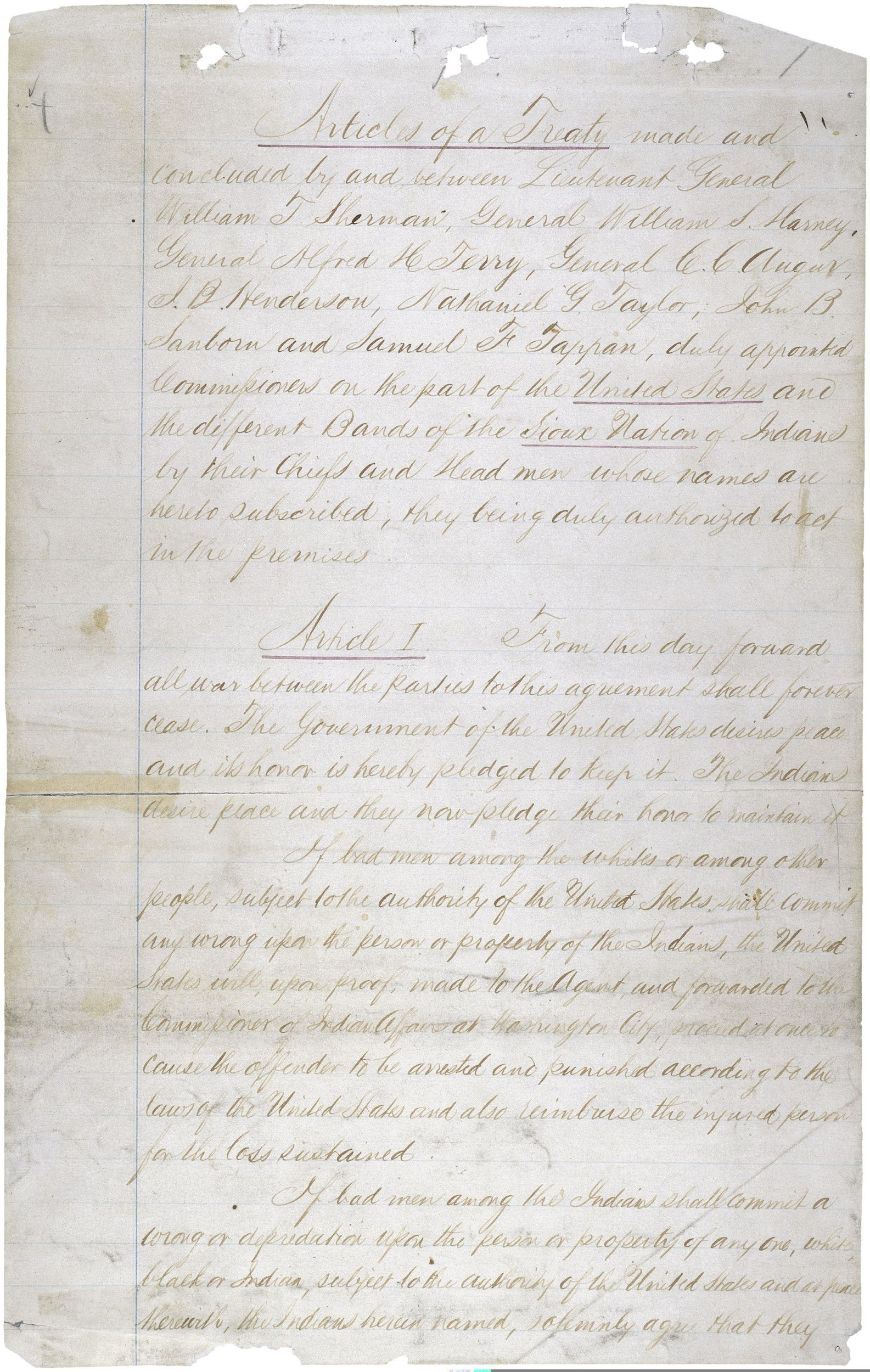
Fort Laramie Treaty
Page 2
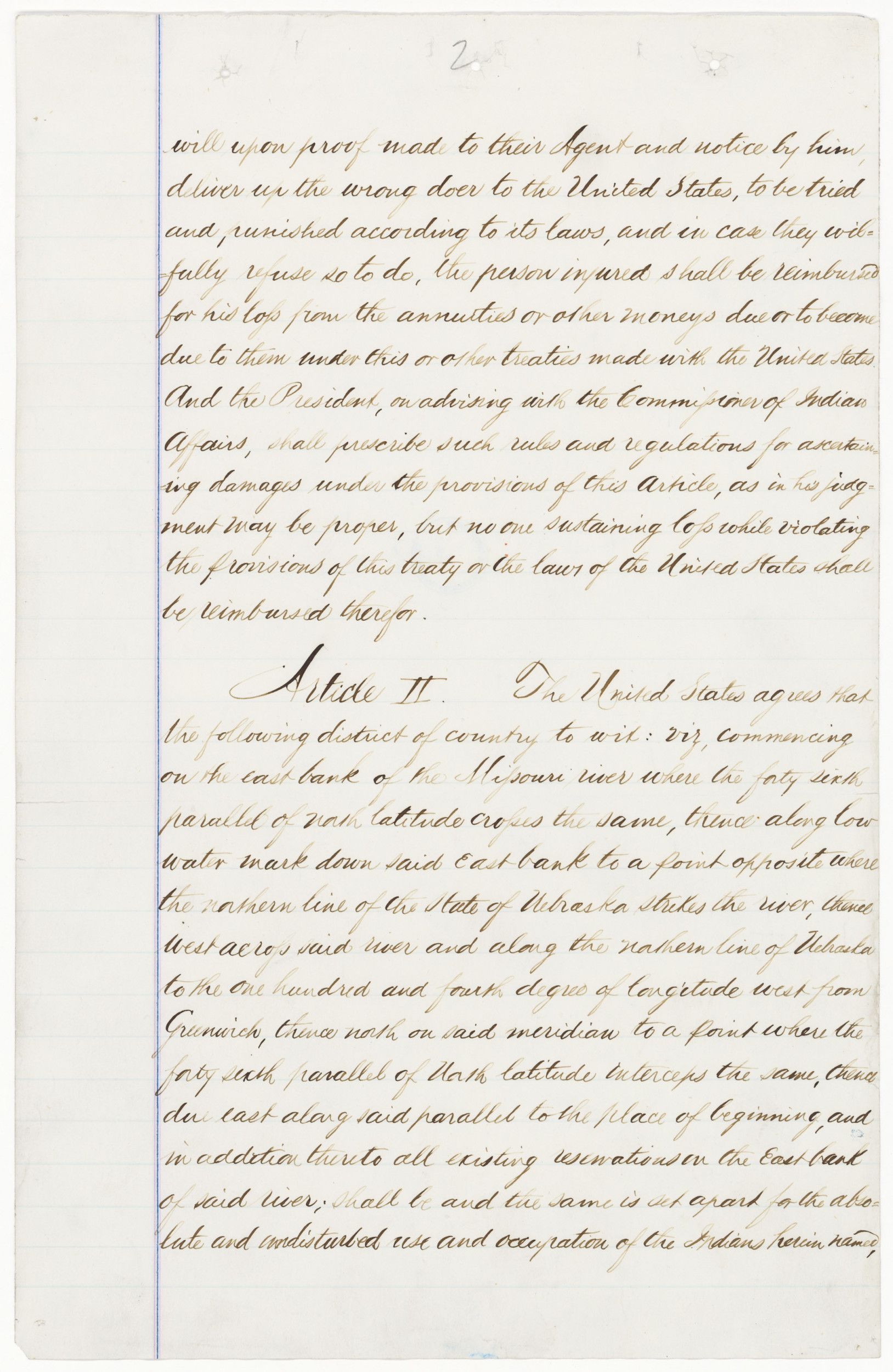
Fort Laramie Treaty
Page 3
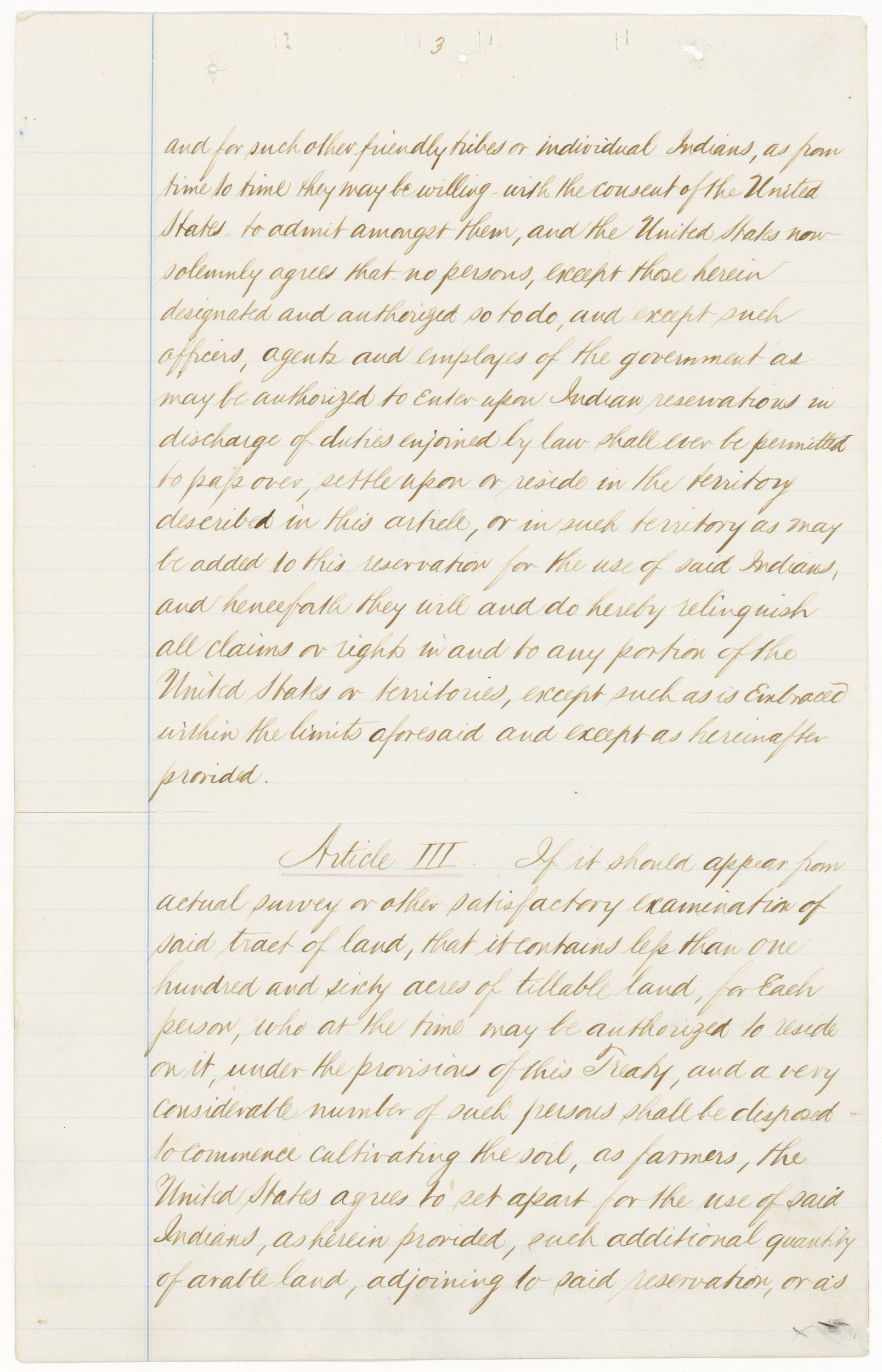
Fort Laramie Treaty
Page 4
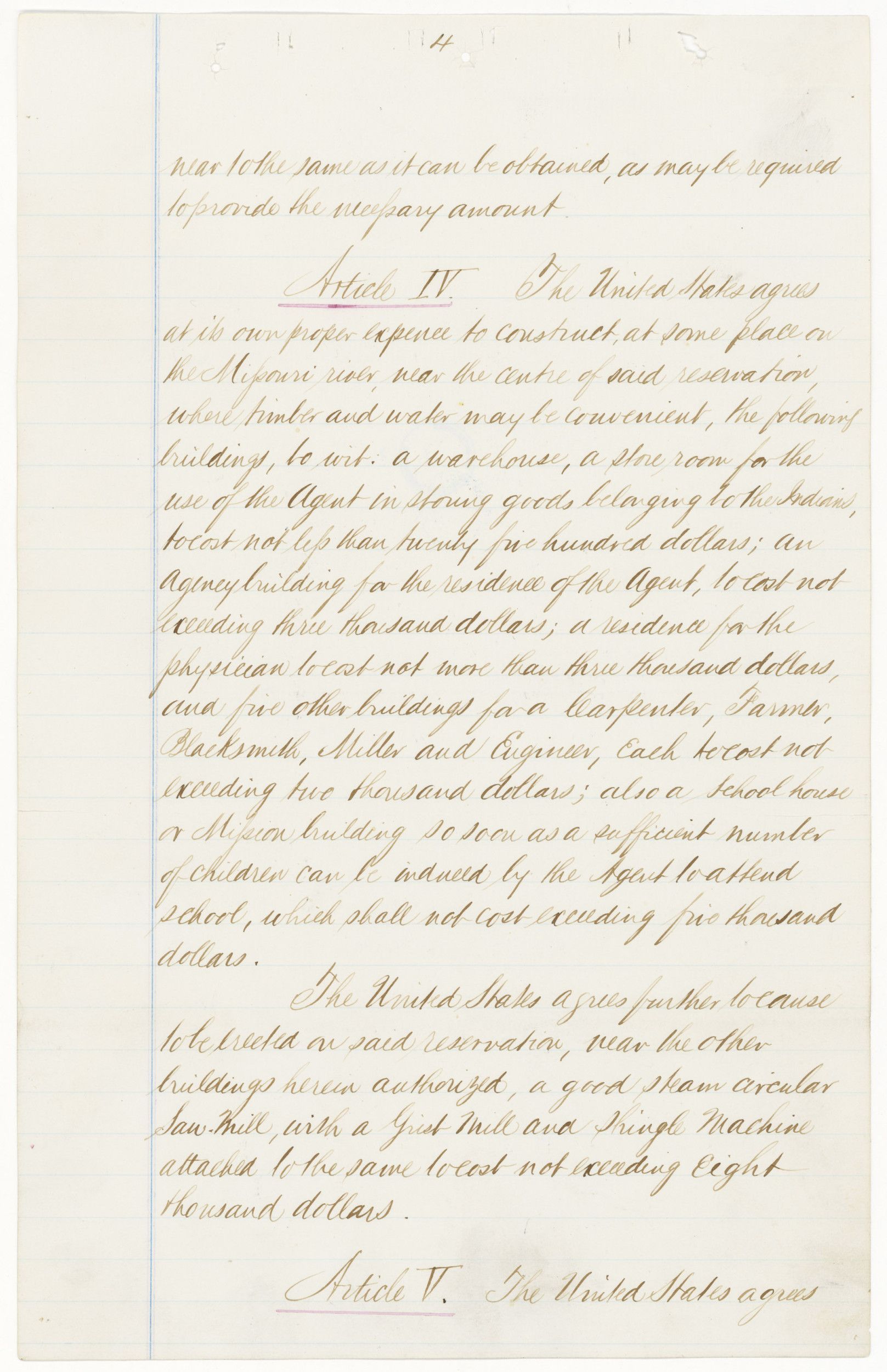
Fort Laramie Treaty
Page 5

Fort Laramie Treaty
Page 6

Fort Laramie Treaty
Page 7
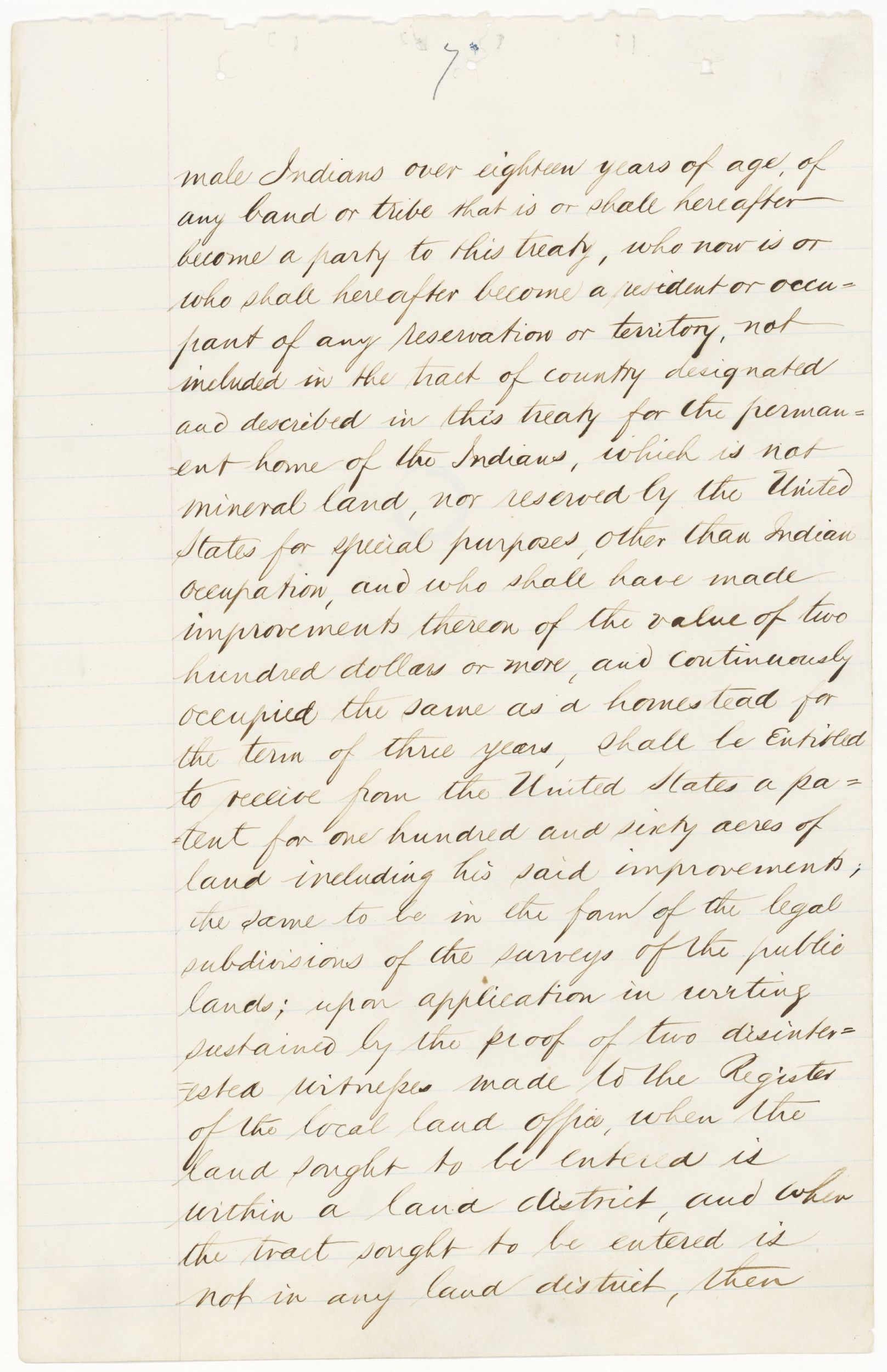
Fort Laramie Treaty
Page 8
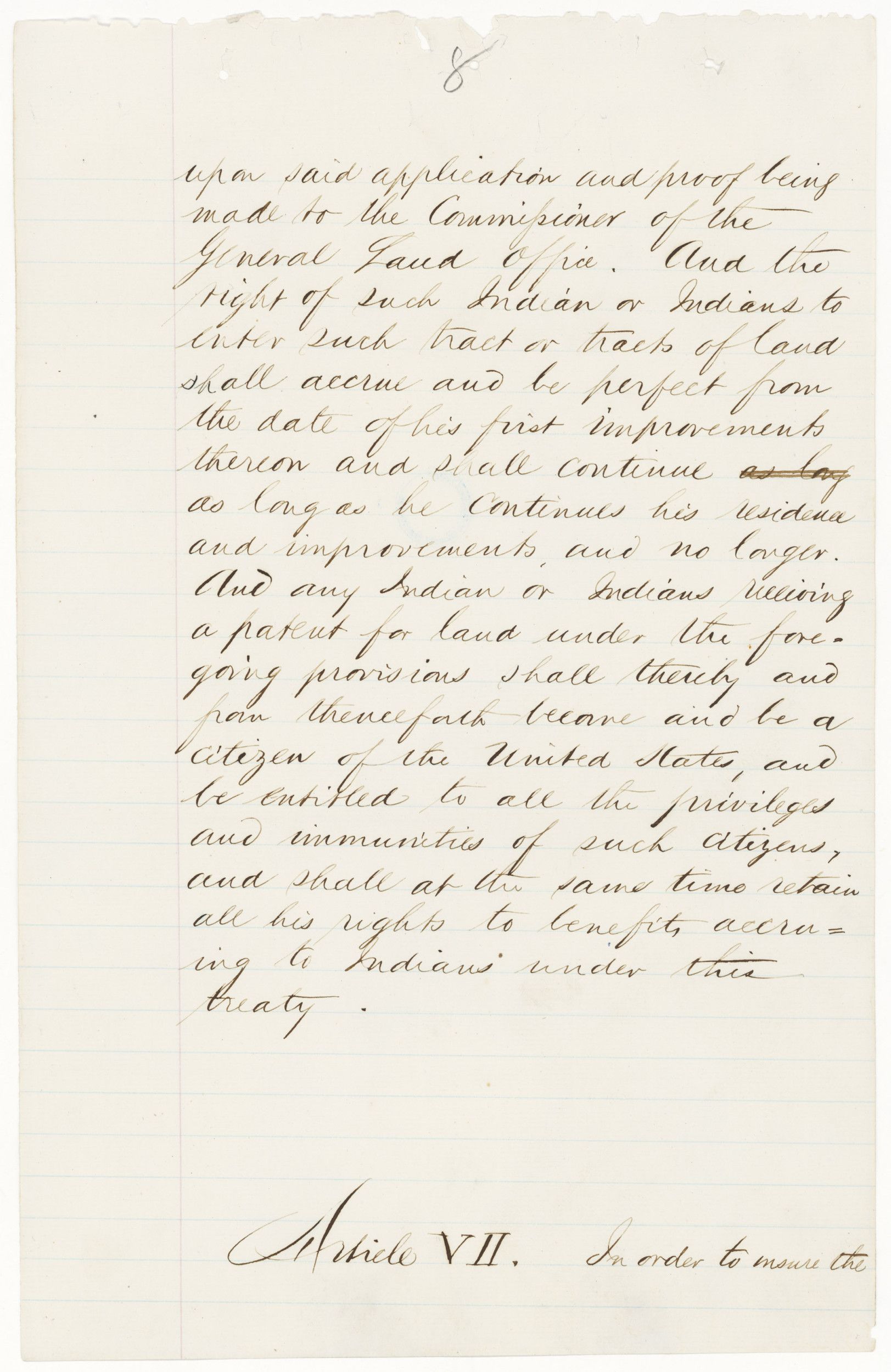
Fort Laramie Treaty
Page 9

Fort Laramie Treaty
Page 10

Fort Laramie Treaty
Page 11

Fort Laramie Treaty
Page 12
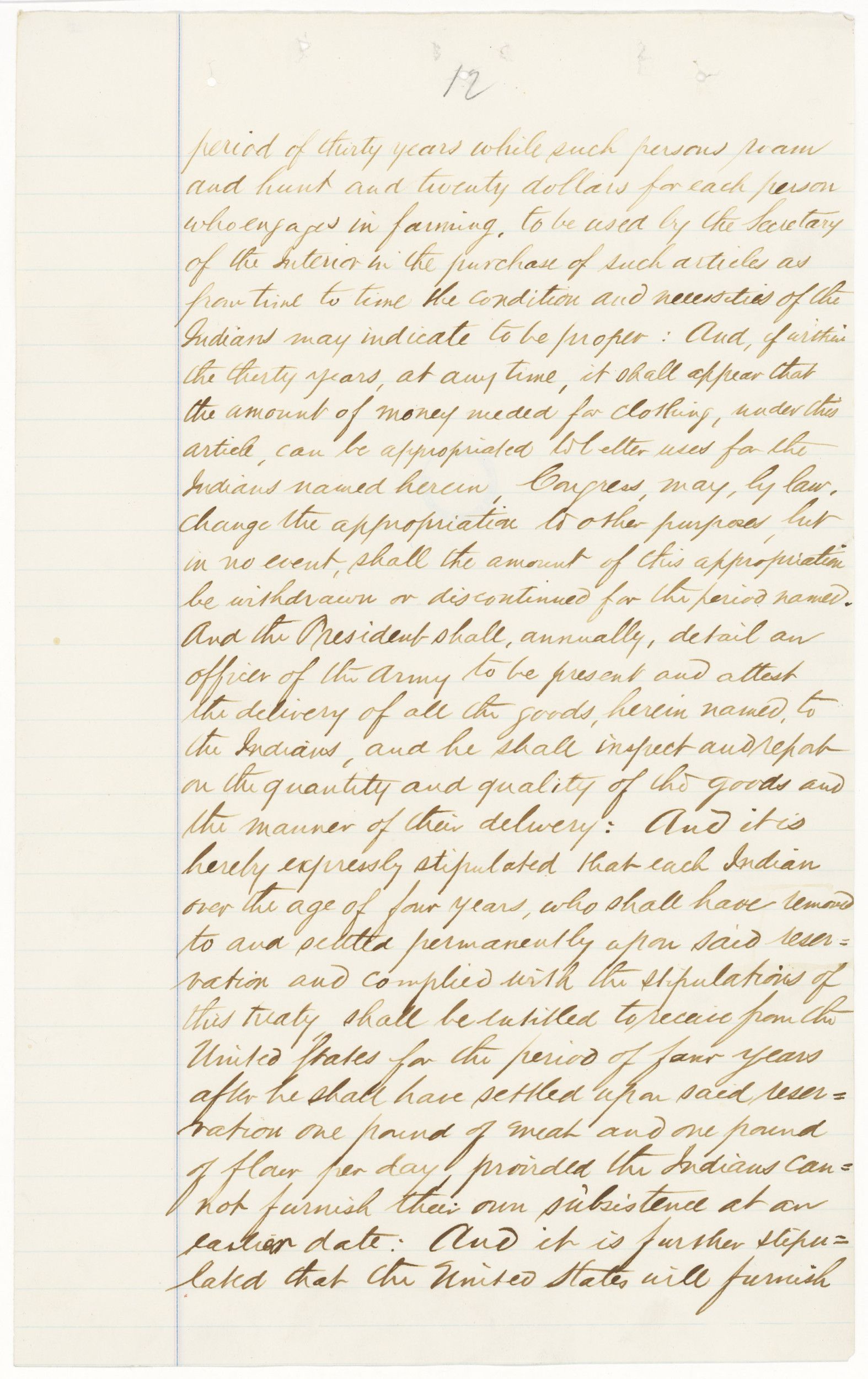
Fort Laramie Treaty
Page 13
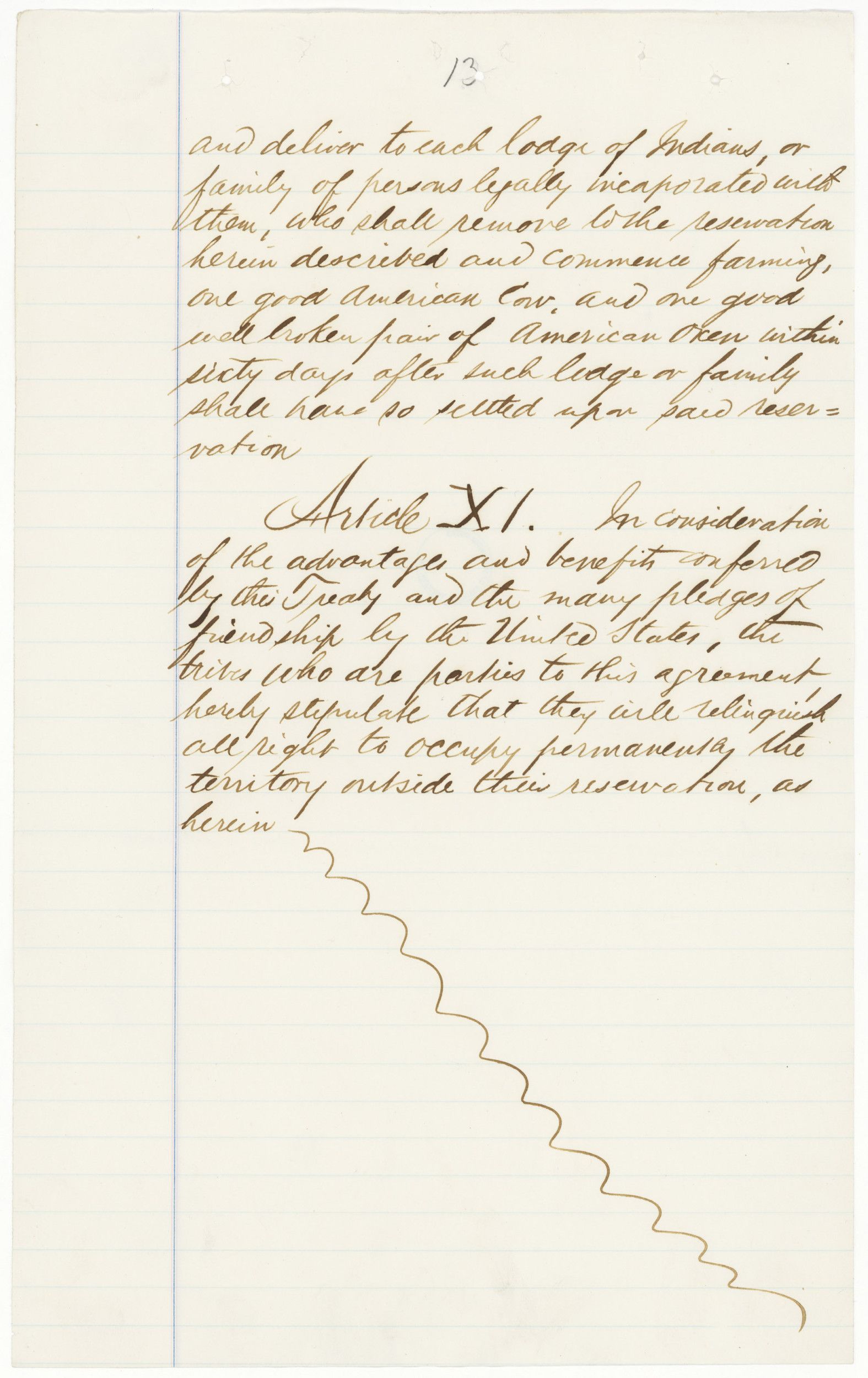
Fort Laramie Treaty
Page 14
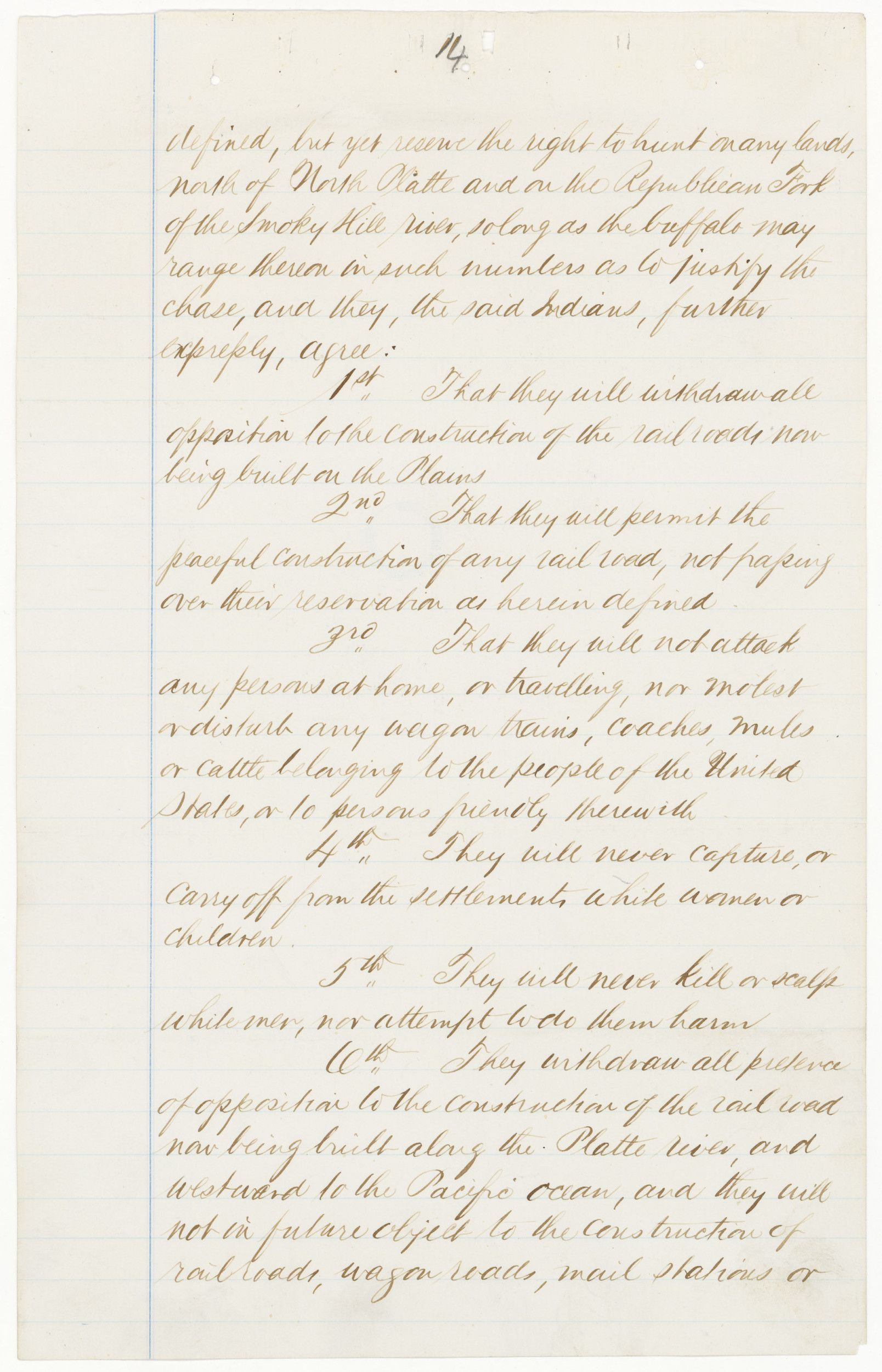
Fort Laramie Treaty
Page 15

Fort Laramie Treaty
Page 16

Fort Laramie Treaty
Page 17
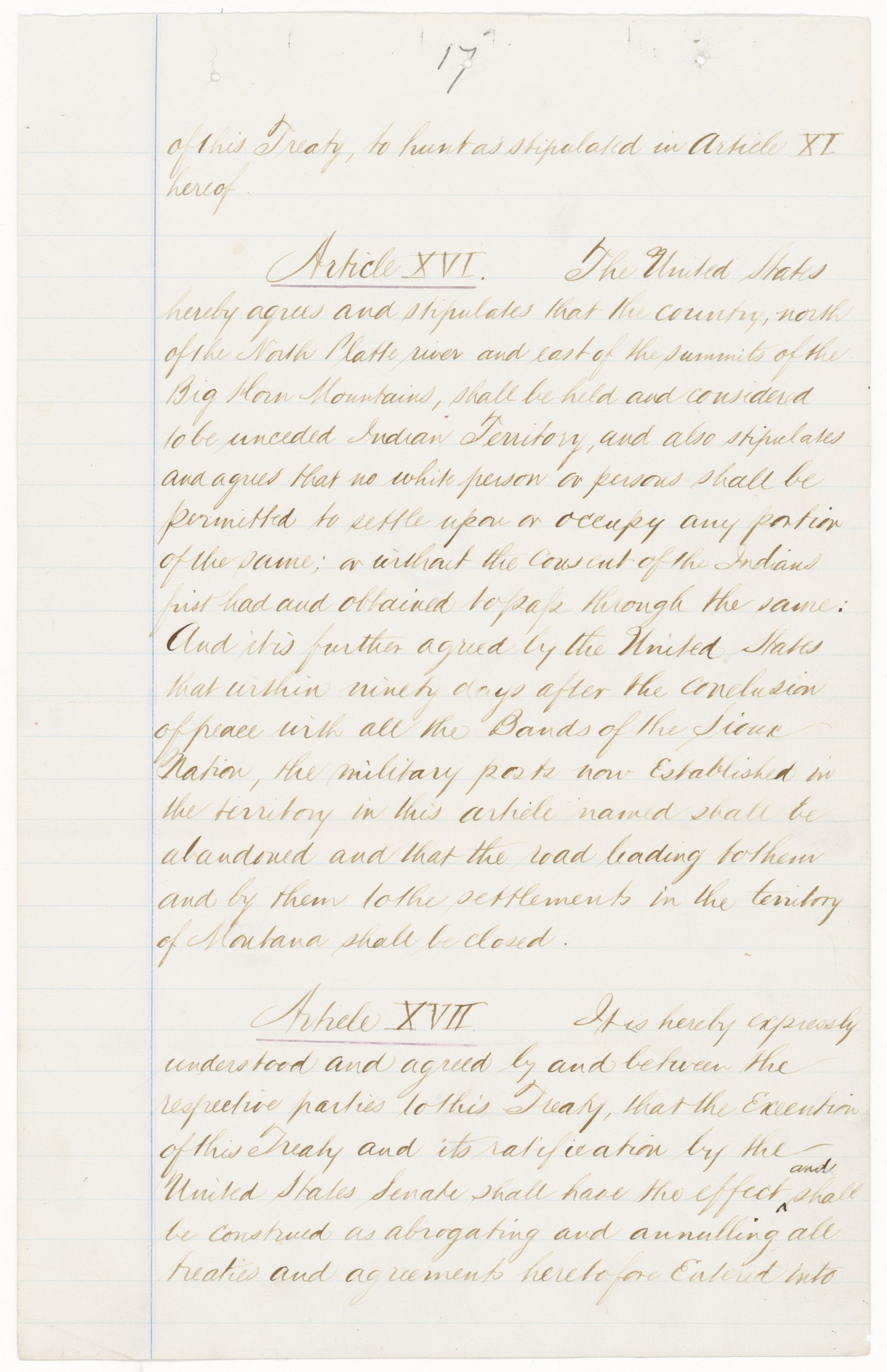
Fort Laramie Treaty
Page 18
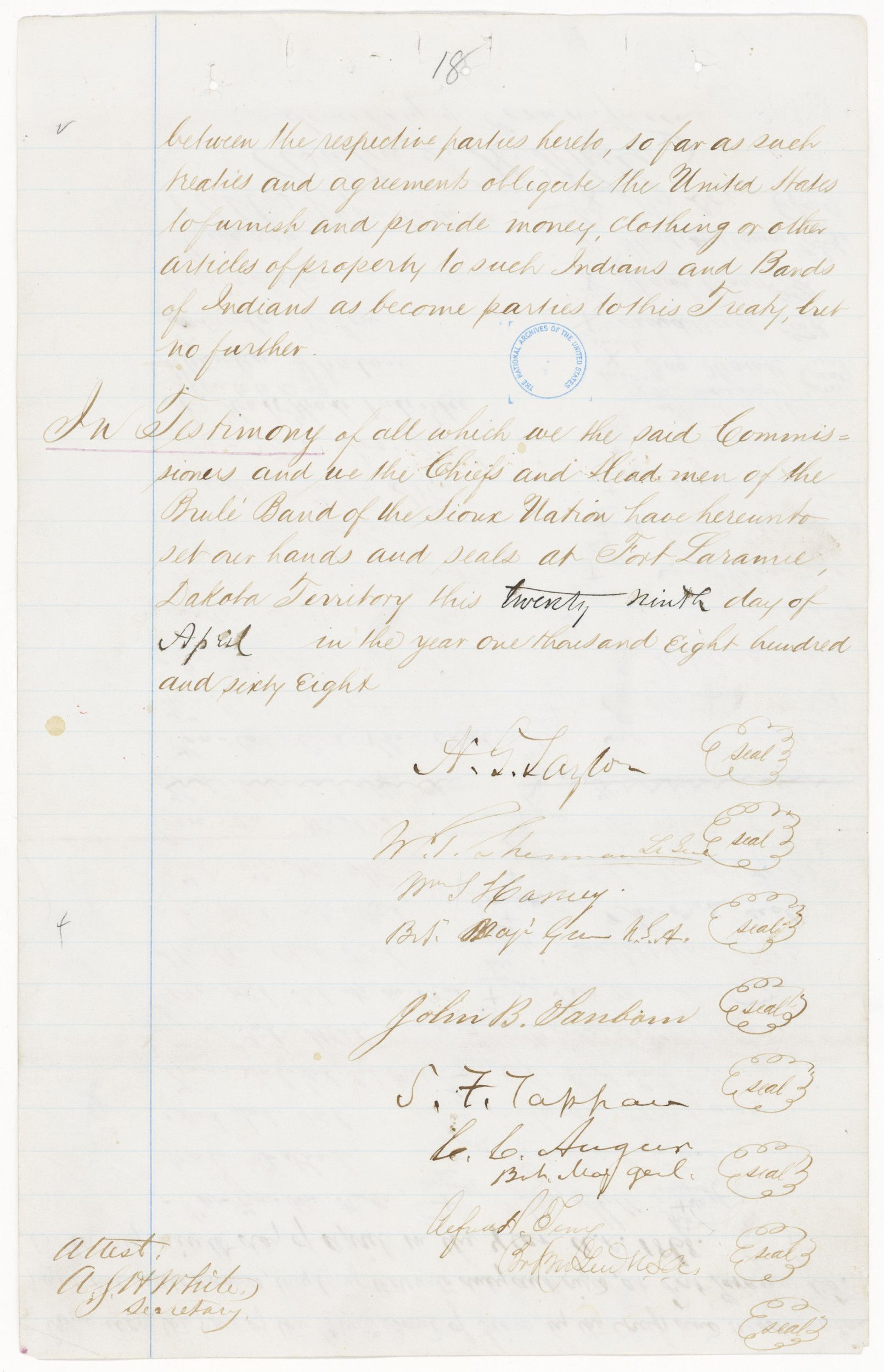
Fort Laramie Treaty
Page 19
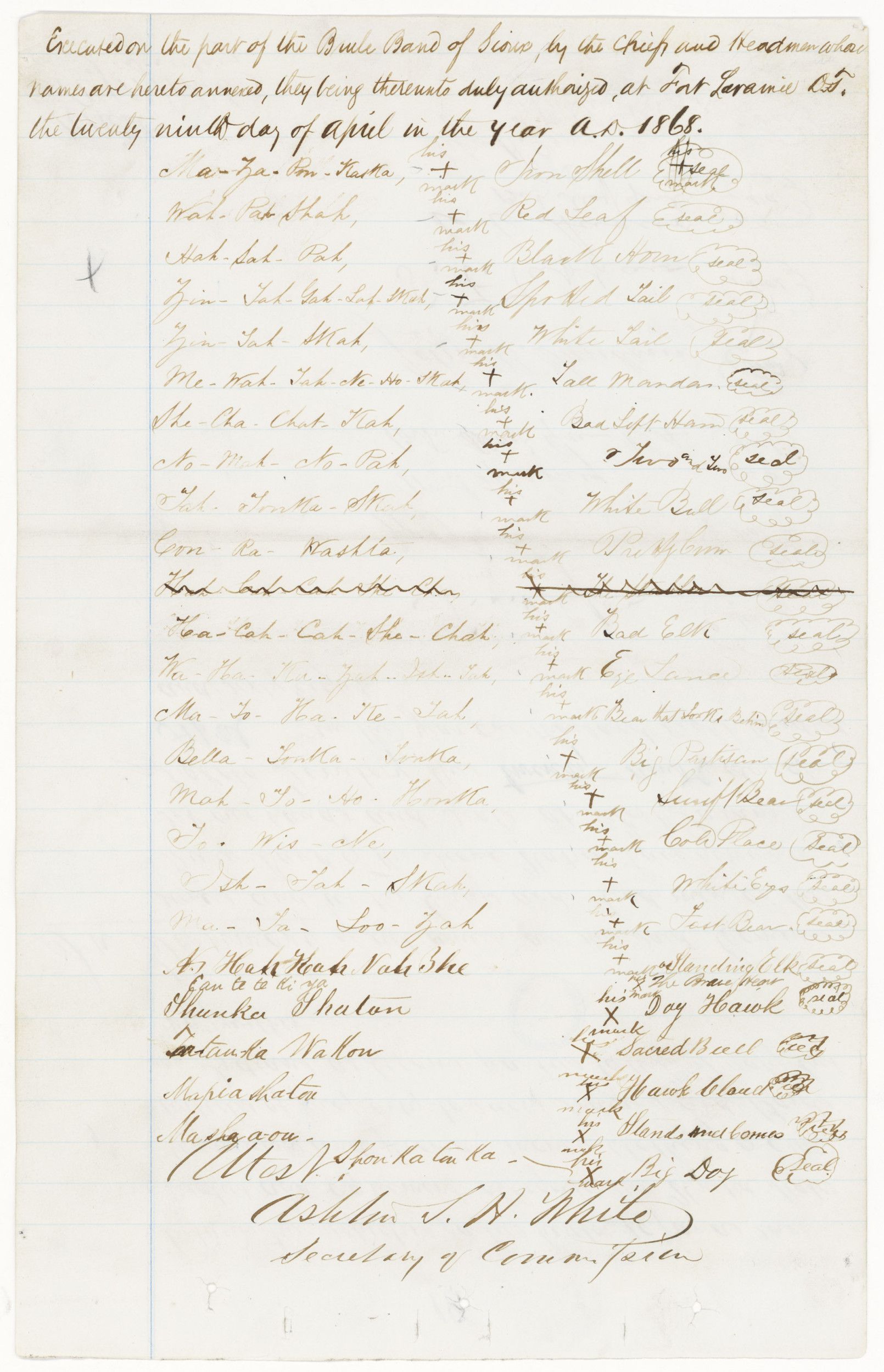
Fort Laramie Treaty
Page 20
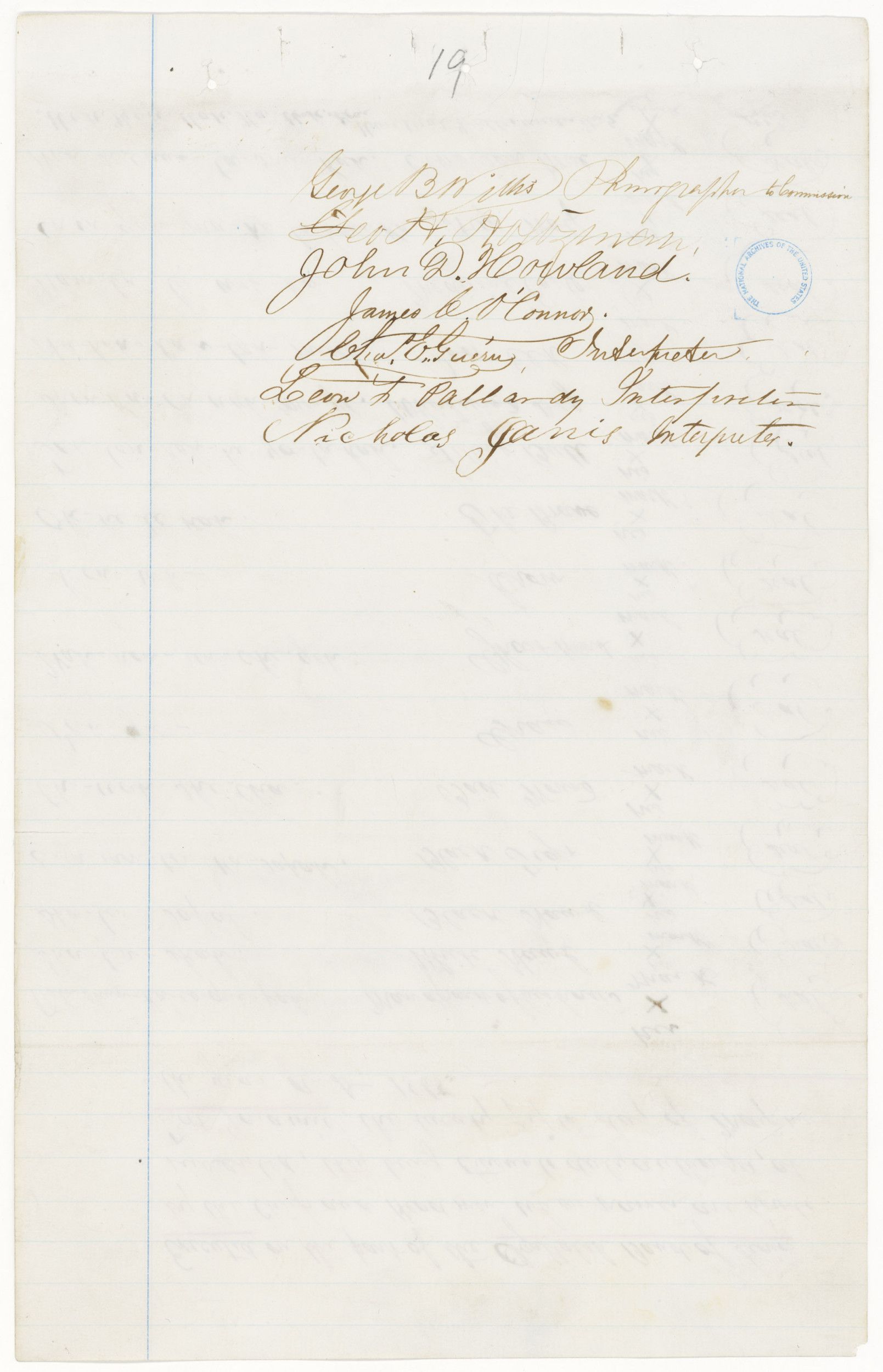
Fort Laramie Treaty
Page 21

Fort Laramie Treaty
Page 22
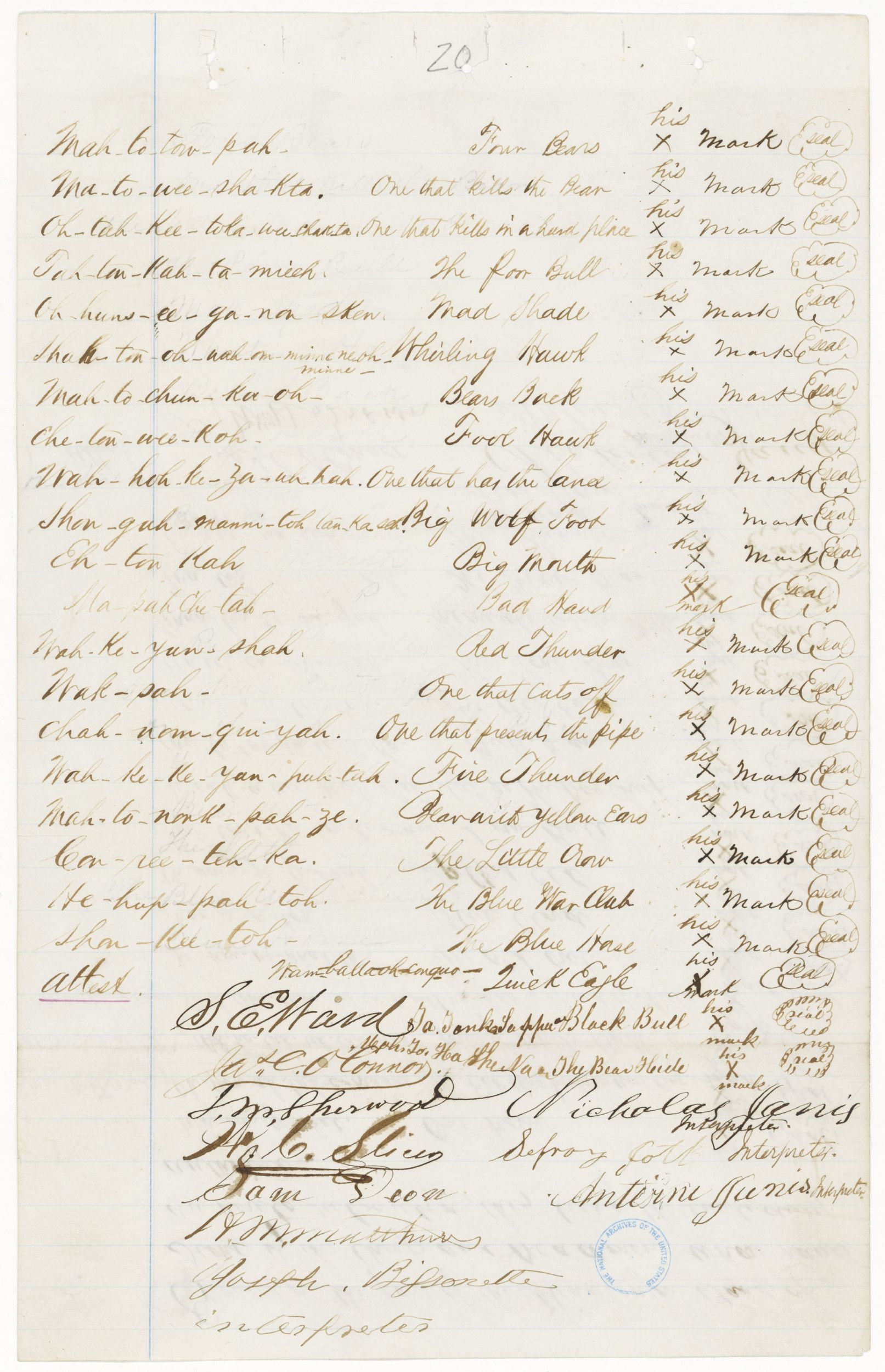
Fort Laramie Treaty
Page 23
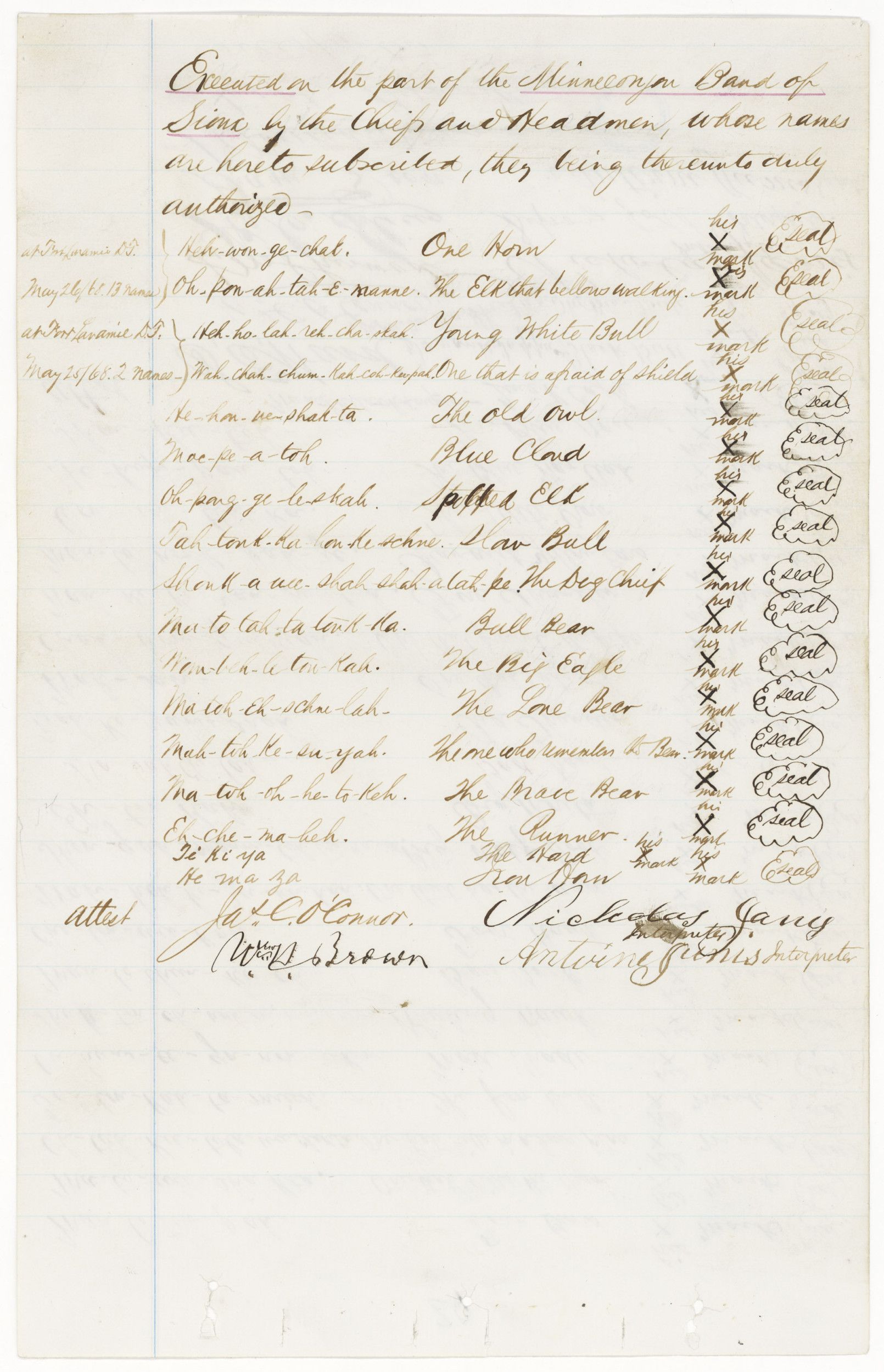
Fort Laramie Treaty
Page 24
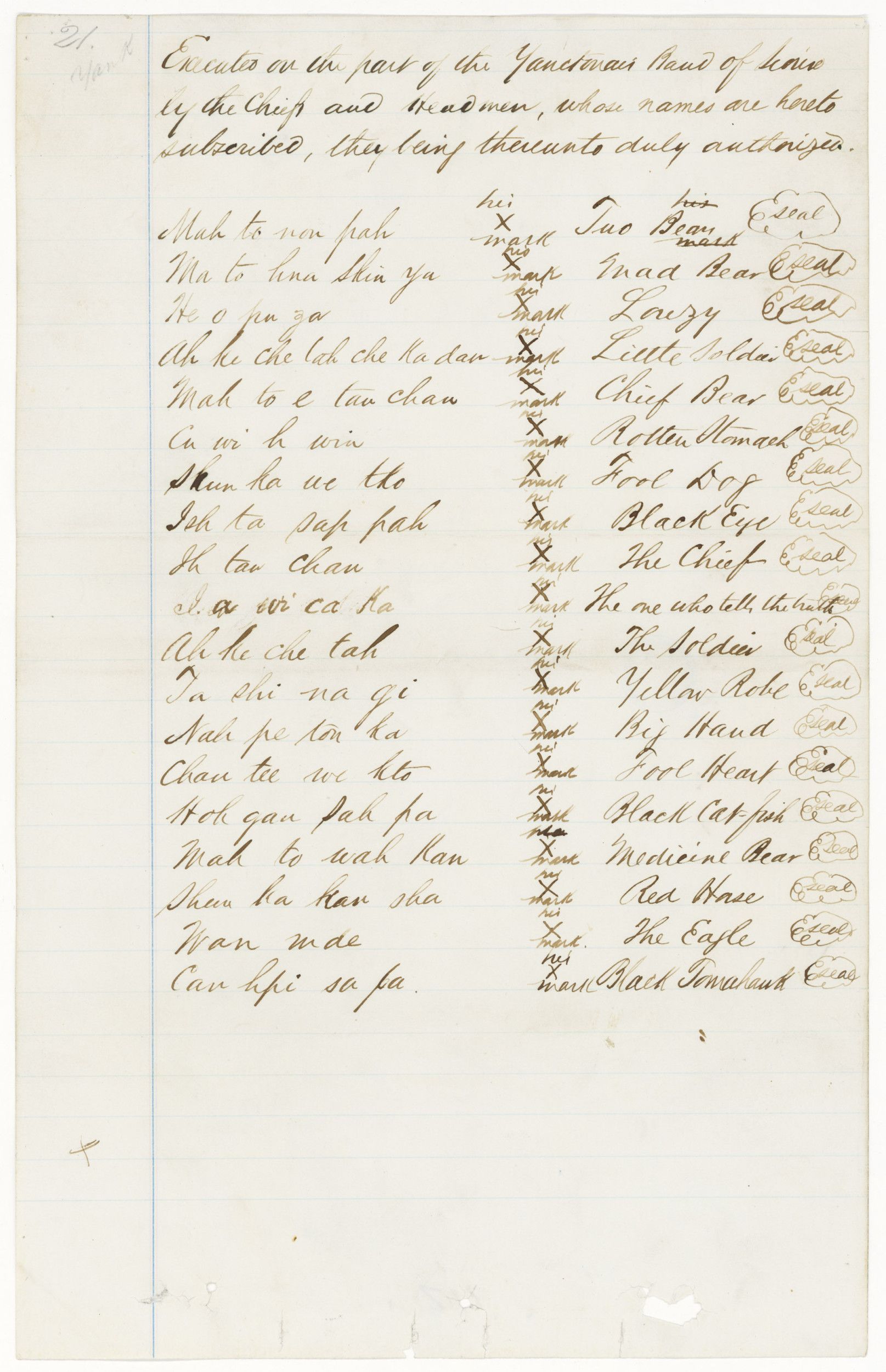
Fort Laramie Treaty
Page 25

Fort Laramie Treaty
Page 26
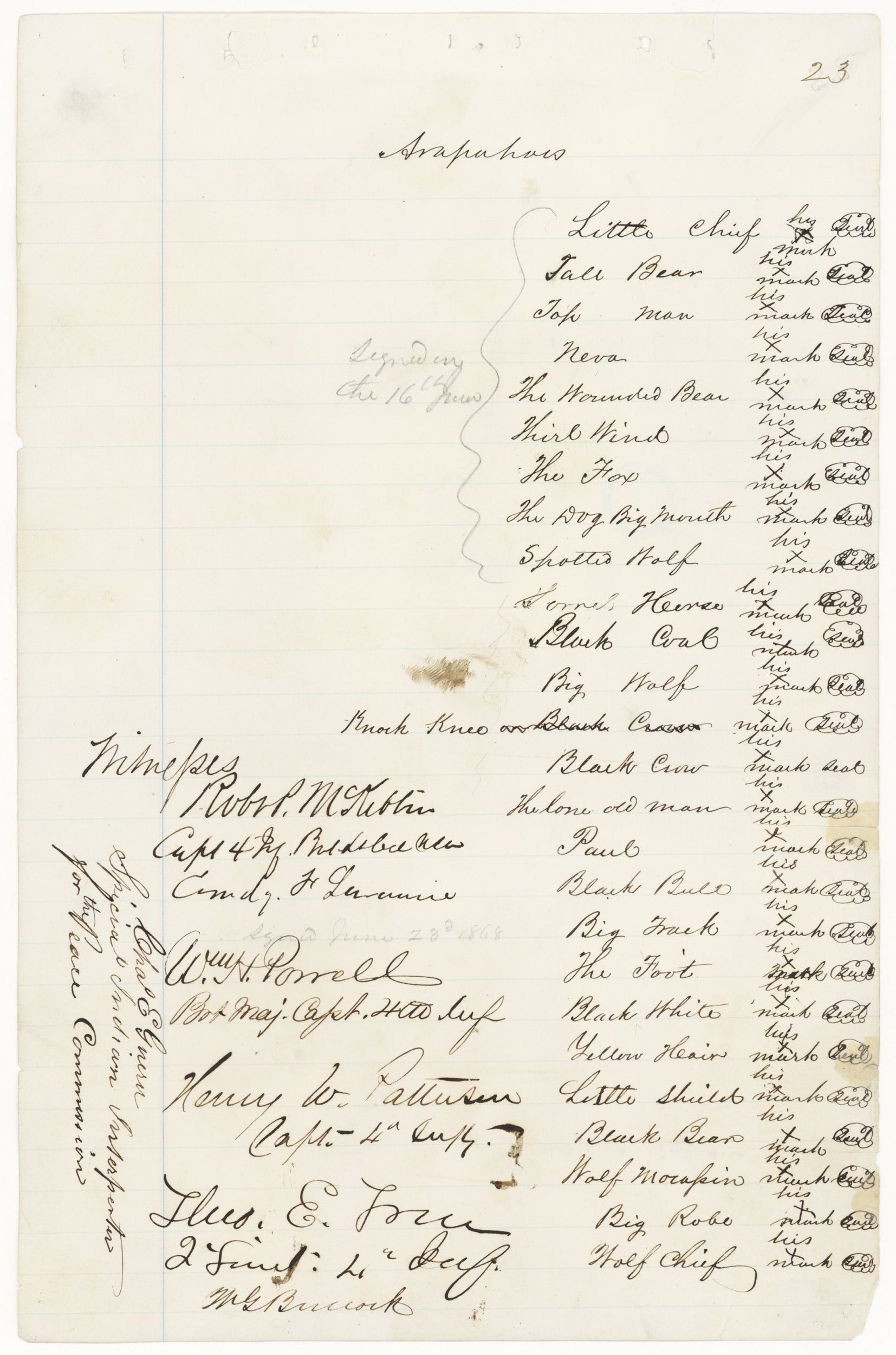
Fort Laramie Treaty
Page 27
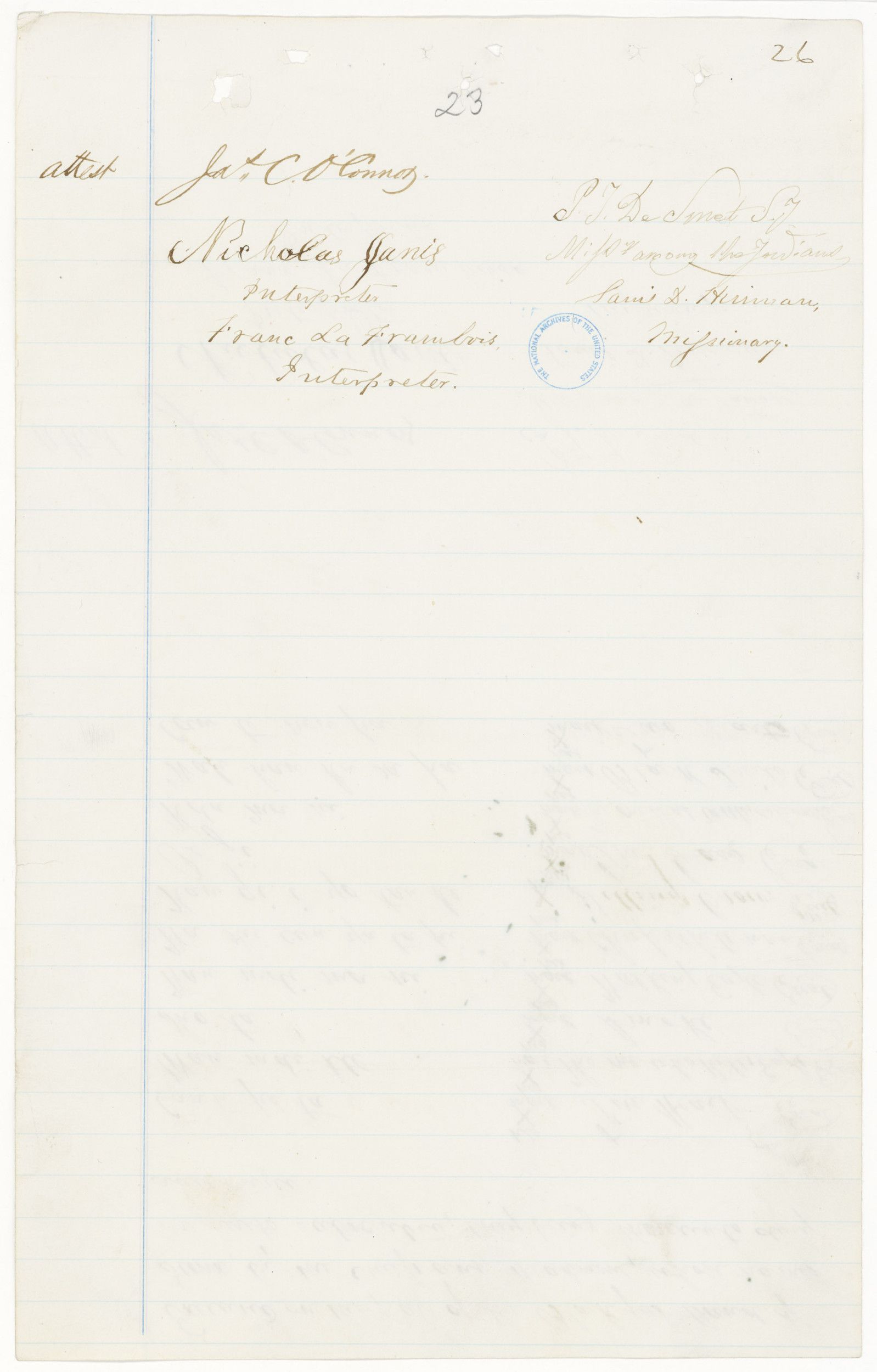
Fort Laramie Treaty
Page 28
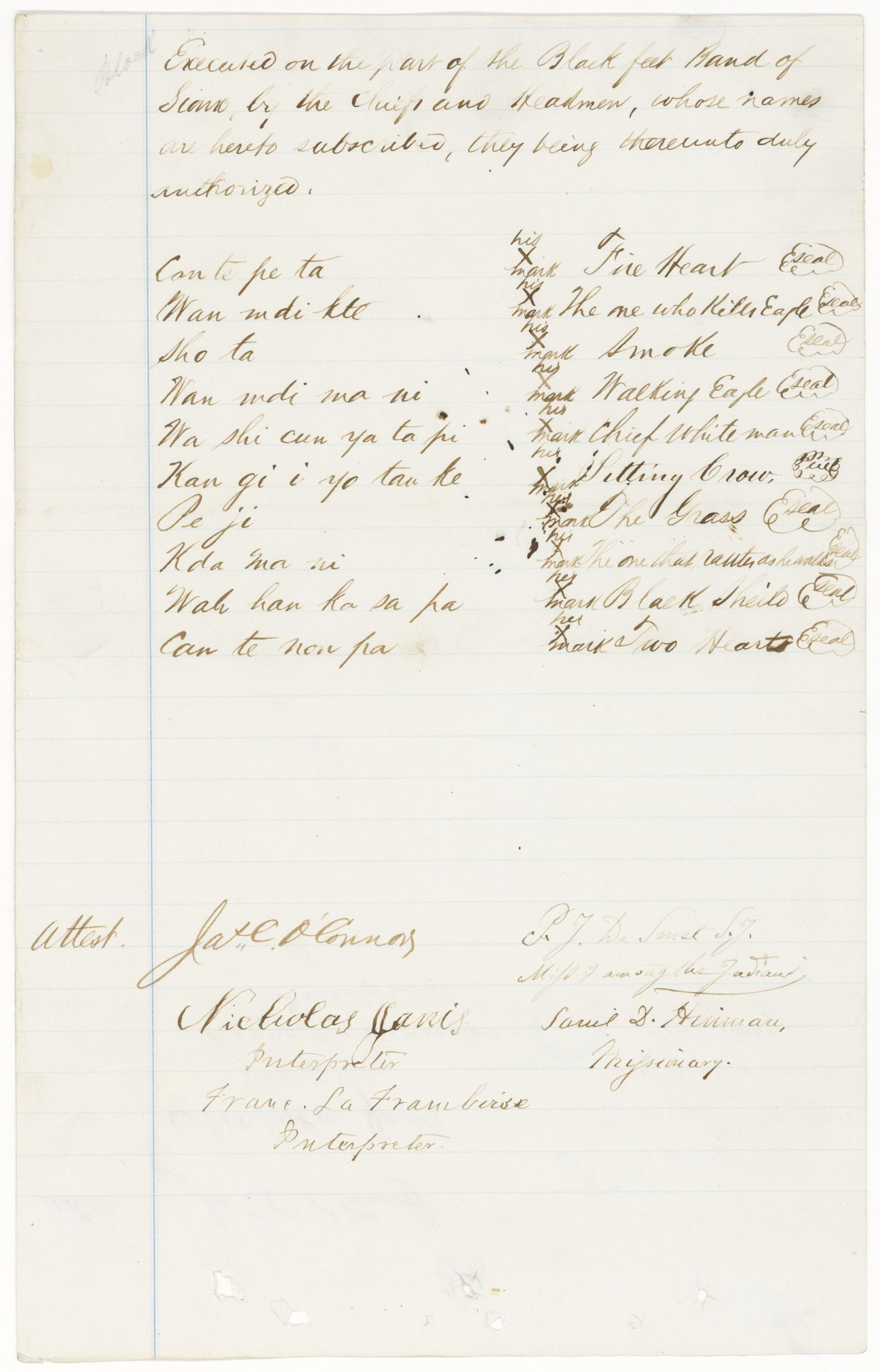
Fort Laramie Treaty
Page 29

Fort Laramie Treaty
Page 30
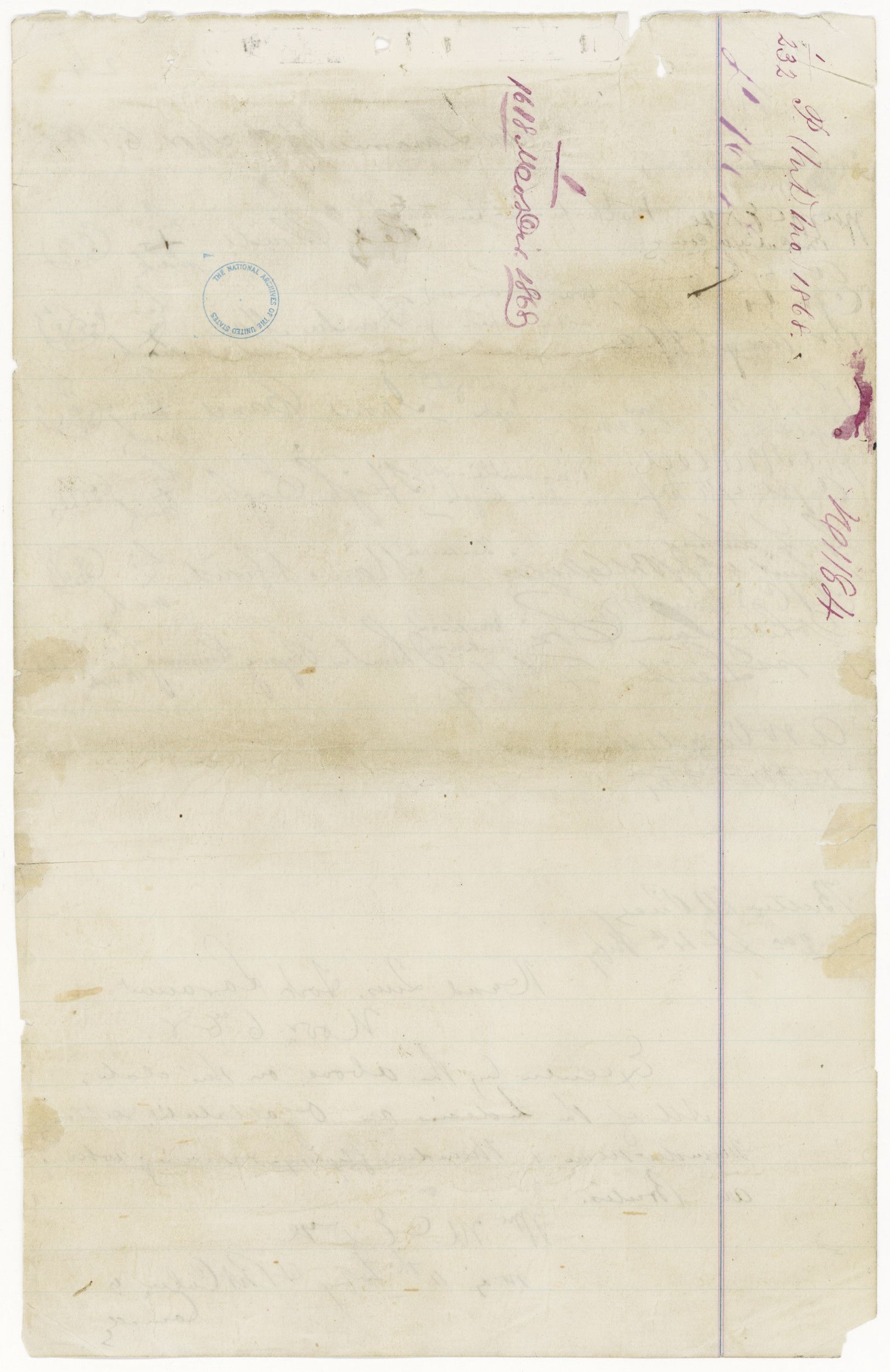
Fort Laramie Treaty
Page 31
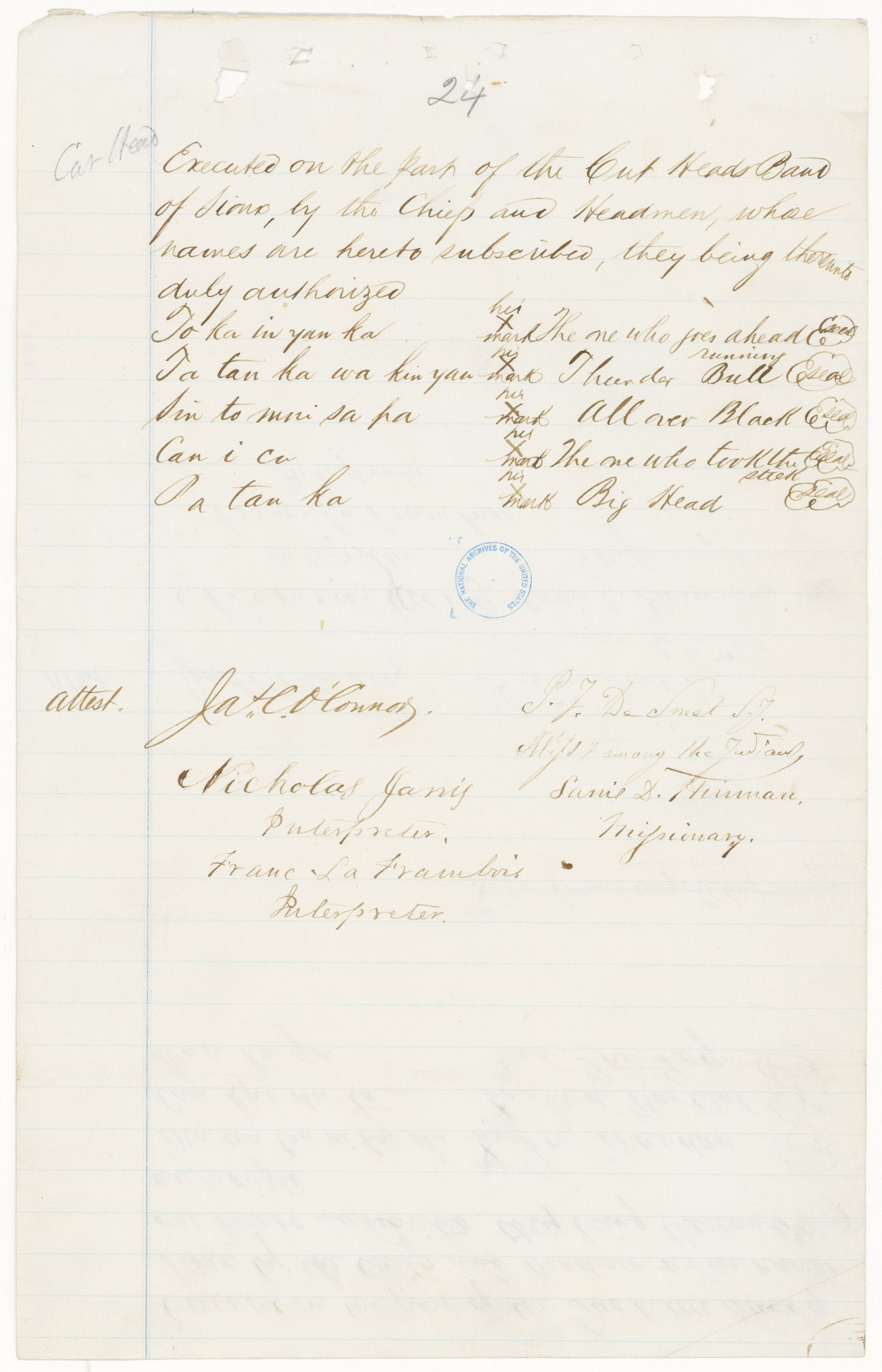
Fort Laramie Treaty
Page 32
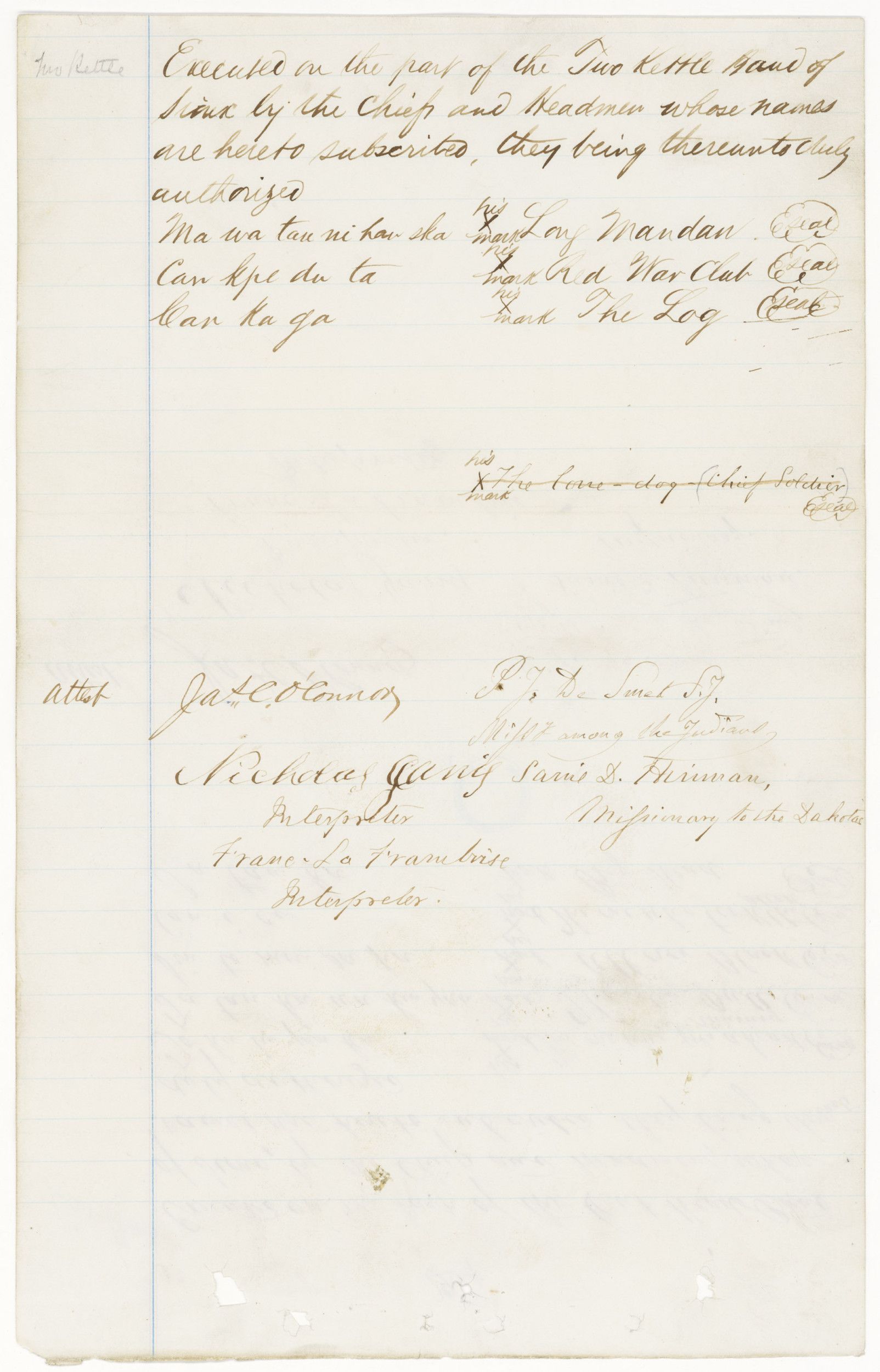
Fort Laramie Treaty
Page 33
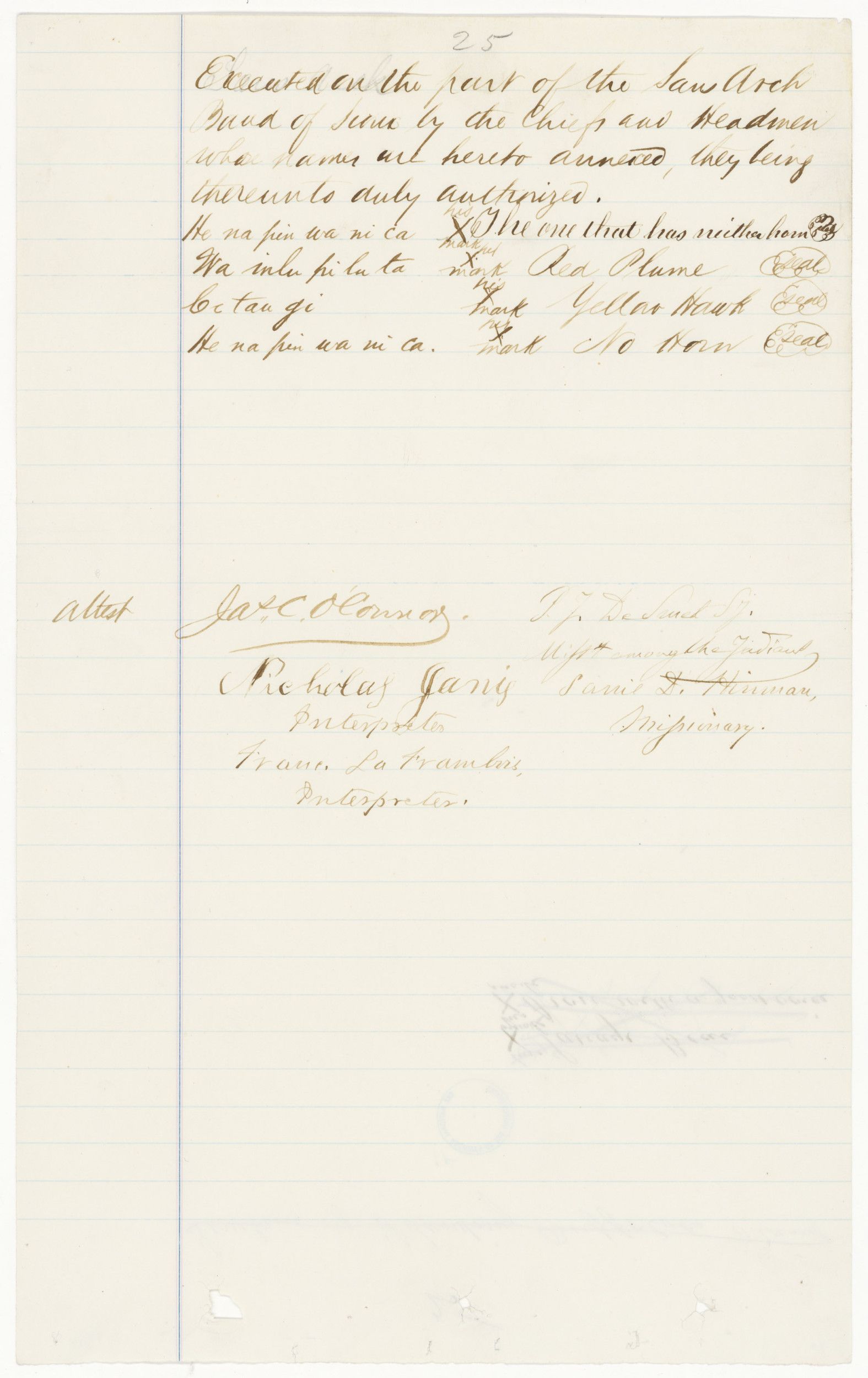
Fort Laramie Treaty
Page 34

Fort Laramie Treaty
Page 35

Fort Laramie Treaty
Page 36

Document
First Report of the Battle of the Little Bighorn, From Gen. Alfred H. Terry, Montana, to Assistant Adjutant General R.C. Drum, Chicago
6/27/1876
He compiled this report. A civilian scout carried it to Fort Ellis, Montana, the nearest telegraph office, where it was relayed first to Assistant Adjutant General R.C. Drum in Chicago, then to Army headquarters in Washington, DC.
There was a break in the telegraph line between Fort Ellis and Chicago causing a delay in service; and so, the highest officials in the U.S. Army in Philadelphia, attending the grand Centennial Exposition, learned about Custer's fate not from this report, but from a July 6th newspaper story.
Transcript
9352THE WESTERN UNION TELEGRAPH COMPANY.
No. 206 [illegible due to tear] Got
The rules of this Company require that all messages received for transmission shall be written on the message blanks of the Company, under and subject to the conditions printed thereon, which conditions have been agreed to by the sender of the following message.
A. R. BREWER, Secretary.
WILLIAM ORTON, Prest.
820 p.m.
Dated, Headquarters Dept of Dakota
To Camp on Little big horn river
Rec'd at cor. Lasalle and Washington Sts.,
CHICAGO, Ills.
July 6 1876
June 27th
To Adjutant Gen of military Division of the Missouri at Chicago Ill=
it is my painfull duty to report that day before yesterday the twenty fifth inst a great disaster overtook Gen Custer & The troops under his Command at twelve oclock of the twenty second he started with his whole regiment & a strong detachment of scouts & guards from the mouth of the Rosebud proceeding up that river about twenty miles he struck a very heavy Indian trail which had previously been discovered
Russell Brothers' Print 17 Ross Street, N.Y.
THE WESTERN UNION TELEGRAPH COMPANY.
No. 206 om
2 [circled]
The rules of this Company require that all messages received for transmission shall be written on the message blanks of the Company, under and subject to the conditions printed thereon, which conditions have been agreed to by the sender of the following message.
A.R. BREWER, Secretary.
WILLIAM ORTON, Prest.
Dated, [blank]
To [blank]
Rec'd at cor. Lsalle and Washington Sts.,
CHICAGO Ills.
[blank] 187
[Note: Preceding text is printed at the top of every page but not filled out. Only those fields filled out will be transcribed on the pages that follow.]
& pursuing it found that it led as it was supposed that it would lead to the Little big horn river here he found a village of almost Enexampled [sic] Extent & at once attacked it with that portion of his force which was immediately at hand major Reno with three Companies a g & m of the regiment was sent into the valley of the stream at the point where the trail struct [sic] it General
Russell Brothers' Print, 17 Ross Street, N.Y. [Note: This text is printed at the bottom of every page. This will not be transcribed on pages that follow.]
3 [circled]
Custer with five Companies C E F I & L [in pencil: attempted] all ample to enter it about three miles lower down [illegible] forded the river Charged Down its left bank dismounted & fought on foot until finally Completely overwhelmed by numbers he he was compelled to mount recross the river & seek a refuge on the high bluffs which overlooked its right bank Just as he recrossed Capt Belton who with three Companies D H &
4 [circled]
K was come two miles to the left of Reno when the action Commenced but who had been ordered by Genl Custer to return came to the river & rightly Concluding that it was useless for his force to attempt to renew the fight in the valley he joined Reno on the bluffs Capt McDougall with his company B was at first at some distance In the rear with a train of pack mules he
5 [circled]
also came up to reno soon this United force was nearly surrounded by Indians many of whom armed with rifles occupied positions which commanded the ground held by the cavalry ground from which there was no escape rifle pits were dug & the fight was maintained though with heavy loss from about half past two oclock of the twenty fifth till Six oclock of the twenty sixth when the Indians withdrew from the valley taking
6
with them their village. Of the movements of Gen Custer & the five Companies under his immediate Command scarcely anything is known from those who witnessed them for no officer or soldier who accompanied him has yet been found alive. His trail from the point where Reno crossed the stream passes along & in the rear of the Crest of the Bluffs on the right bank for nearly or quite three miles then it Comes
7
down to the bank of the river but at once diverges from it as if he had unsuccessfully attempted to cross then turns upon itself almost Completes a circle & closes. It is marked by the remains of this officers & men the bodies of his horses some of them bobbed [inserted in pencil: dropped] along the path others heaped where halts appear to have been made there is abundant Evidence that a gallant resistance was offered by the
8
troops but they were beset on all sides by overpowering numbers. The officers Known to be killed are gen Custer Captains Keogh Gates & Custer Lieuts Cook Smith McIntosh Calhoun porter Hodgeson Sturgis & Reilly of the cavalry Lieut Crittenden of the twentieth infantry & acting asst surgeon Dewolf Lieut Harrington of the Cavalry & asst Surgeon Lord are missing. Capt Benton & Lieut Varnum of the Cavalry are slightly wounded Mr Boston Custer A
9 [circled]
Letter "B"
[in right margin: C 135P]
Brother & Mr Reed a nephew of Genl Custer were with him & were Killed no other officers than those whom I have named are among the Killed wounded & missing. It is Impossible as yet to obtain a nominal [inserted above in pencil: reliable] list of the Enlisted men who were Killed & wounded but the number of killed including officers must reach two hundred & fifty the number of wounded is fifty one
[pencil line across page]
At the mouth of the
10 [circled]
Rosebud I informed Genl Custer that I should take the supply steamer Far-West up the yellow stone to the ferry genl Gibbons Column over the river that I should personally accompany that Column & that it would in all probability reach the mouth of the little big horn on The twenty sixth inst. The steamer reach Genl Gibbons troops near the mouth of the big horn Early in the morning of the twenty fourth
[written in pencil at right margin C1970]
11
[written in pencil at right margin] C140PW]
& at four oclock in the afternoon all his men & animals were across the yellow stone at five oclock The column consisting of five Companies of the seventh Infantry four companies of the second Cavalry & a battery of three gatling guns marched out to & across Tullochs Creek starting soon after five oclock In the morning of the twenty fifth the Infantry made a march of twenty two miles over the most difficult
12
[at right margin C145P]
Country which I have ever seen in order that scouts might be sent into the valley of the Little big horn the Cavalry with the battery was then pushed on thirteen of fourteen miles further reaching camp at midnight the scouts were set out at half past four on the morning of the twenty sixth the scout discovered three Indians who were at first supposed to be sioux but when over taken they proved to
13
[at right margin C 150 PW]
be crows who had been with Gen Custer they brought the first intelligence of the battle their story was not credited it was supposed that some fighting perhaps severe fighting had taken place but it was not believed that disaster Could have overtaken so large a force as twelve Companies of Cavalry, the infantry which had broken camp very Early soon came up & the whole Column Entered & moved up the valley of the
14 [circled]
[at right margin C 154P]
Little Big Horn during the afternoon Efforts were made to send scouts through to what was supposed to be Gen Custers position & to obtain Information of the Condition of affairs but those who were sent out were driven back by parties of Indians who In increasing numbers were seen hovering in Gen Gibbons front at twenty minutes before nine oclock in the Evening the Infantry had marched between twenty nine & thirty miles the
15 [circled]
[at right margin C156 [illegible]]
men were very weary & day light was faling [sic] the Column was therefore halted for the night at a point about Eleven miles in a straight line above the mouth of the stream this morning the movement was resumed & after a march of nine miles Major Renos Entrenchment position was reached the withdrawal of the Indians from around Renos Command & from the valley was undoubtedly caused by the appearance of Gen Gibbons troops
16
[right margin C-2 PW]
Major Reno & Capt Benton both of whom are officers of great Experience accustomed to see large masses of mounted men Estimated the number of Indians engaged at not less than twenty five hundred other officers think that the numbers was greater than this the village in the valley was about three miles in length & about a mile in width besides the lodges proper a great number of temporary brush wood shelter was found
17 [circled]
[at right margin C205P]
In it Indicating that many men besides its proper Inhabitants had gathered together there Major Reno is very confident that there were a number of white men fighting with the Indians it is believed that the loss of the Indians was large I have as yet recieved [sic] no official reports in regard to the battle but what is stated in as gathered from the officers who were on the ground then & from those who
18
have been over it since
Alfred H Terry
Brig Genl
1295 Collect 10365 & 12780 Collect
Govt rate by messenger to Boseman Mont via Helena Mont
July 5th "no extra words counted"
[handwritten C206 PW]
[circular stamp] RECEIVED
JUL
8 ["7" handwritten over the 8]
1876
MIL. [illegible] V. MO.
First Report of the Battle of the Little Bighorn, From Gen. Alfred H. Terry, Montana, to Assistant Adjutant General R.C. Drum, Chicago
Page 1
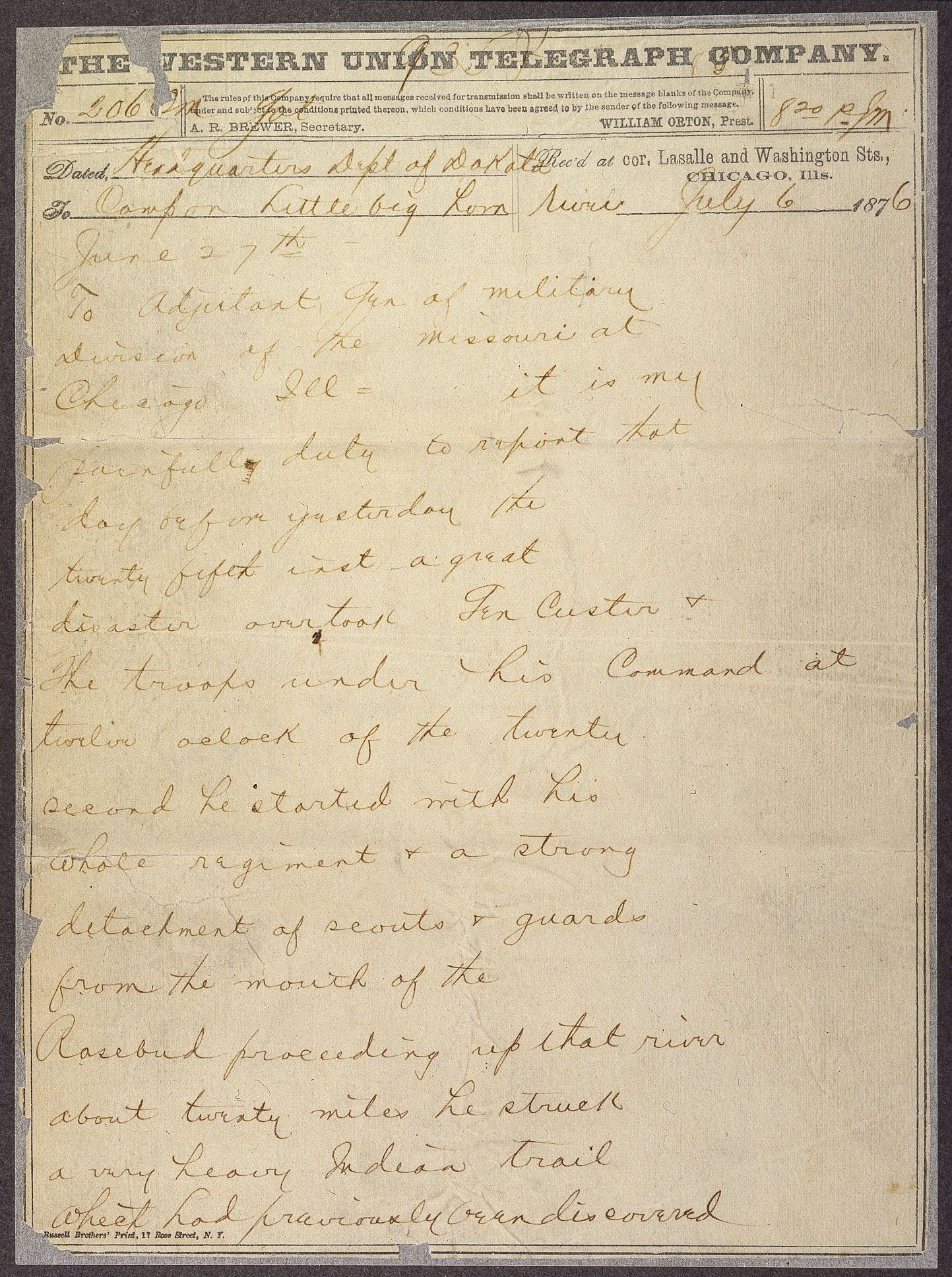
First Report of the Battle of the Little Bighorn, From Gen. Alfred H. Terry, Montana, to Assistant Adjutant General R.C. Drum, Chicago
Page 2
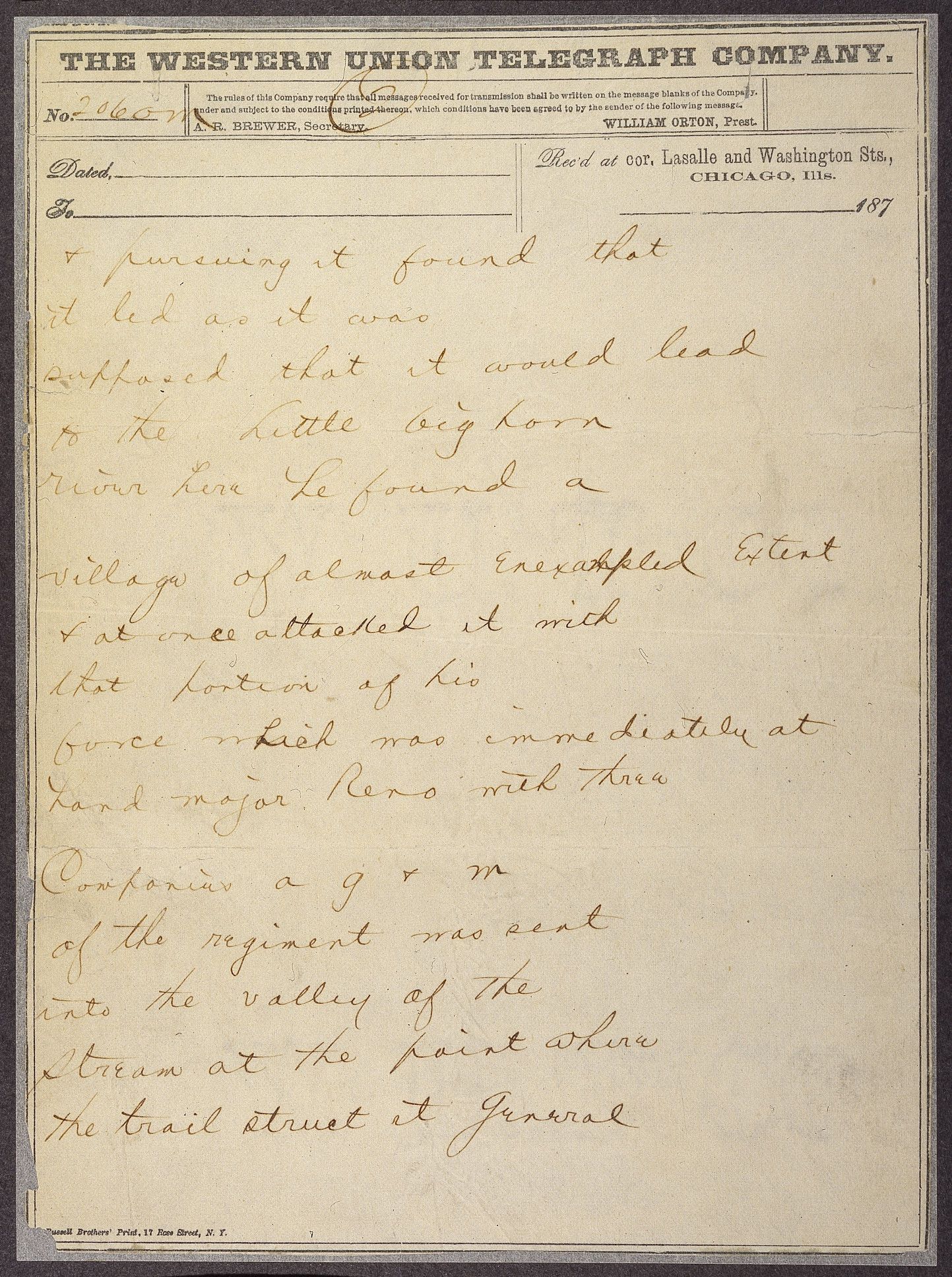
First Report of the Battle of the Little Bighorn, From Gen. Alfred H. Terry, Montana, to Assistant Adjutant General R.C. Drum, Chicago
Page 3
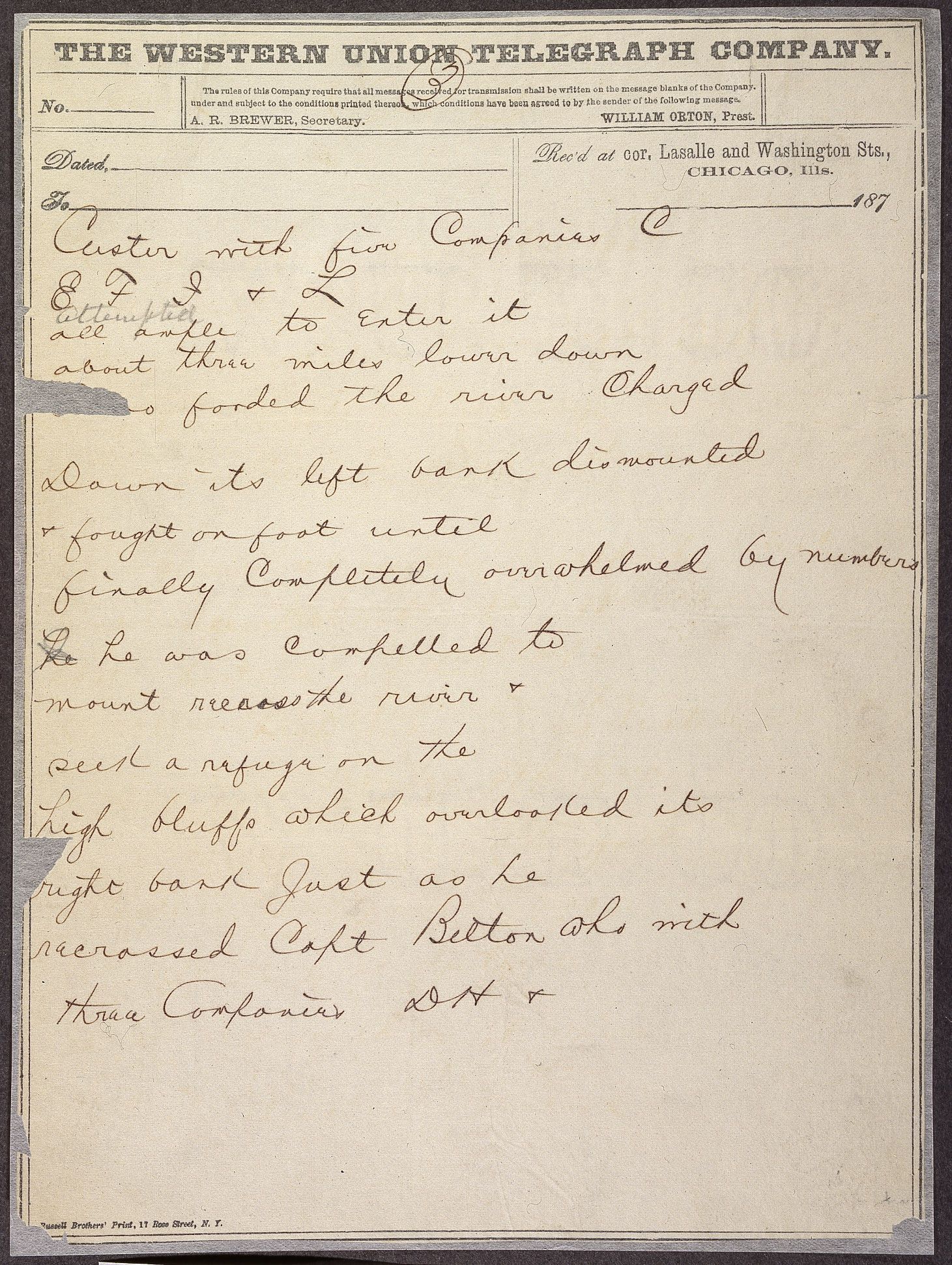
First Report of the Battle of the Little Bighorn, From Gen. Alfred H. Terry, Montana, to Assistant Adjutant General R.C. Drum, Chicago
Page 4

First Report of the Battle of the Little Bighorn, From Gen. Alfred H. Terry, Montana, to Assistant Adjutant General R.C. Drum, Chicago
Page 5
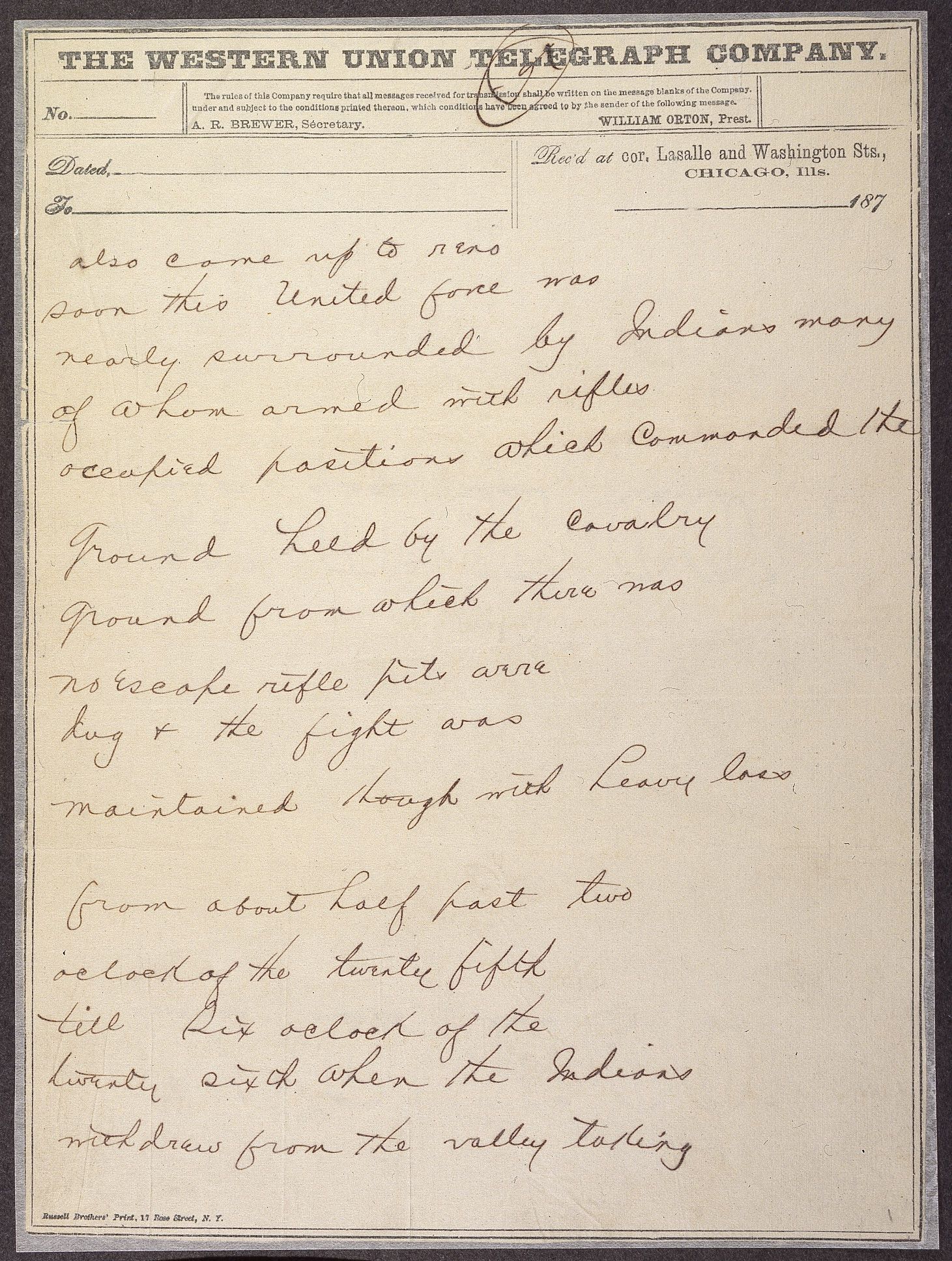
First Report of the Battle of the Little Bighorn, From Gen. Alfred H. Terry, Montana, to Assistant Adjutant General R.C. Drum, Chicago
Page 6
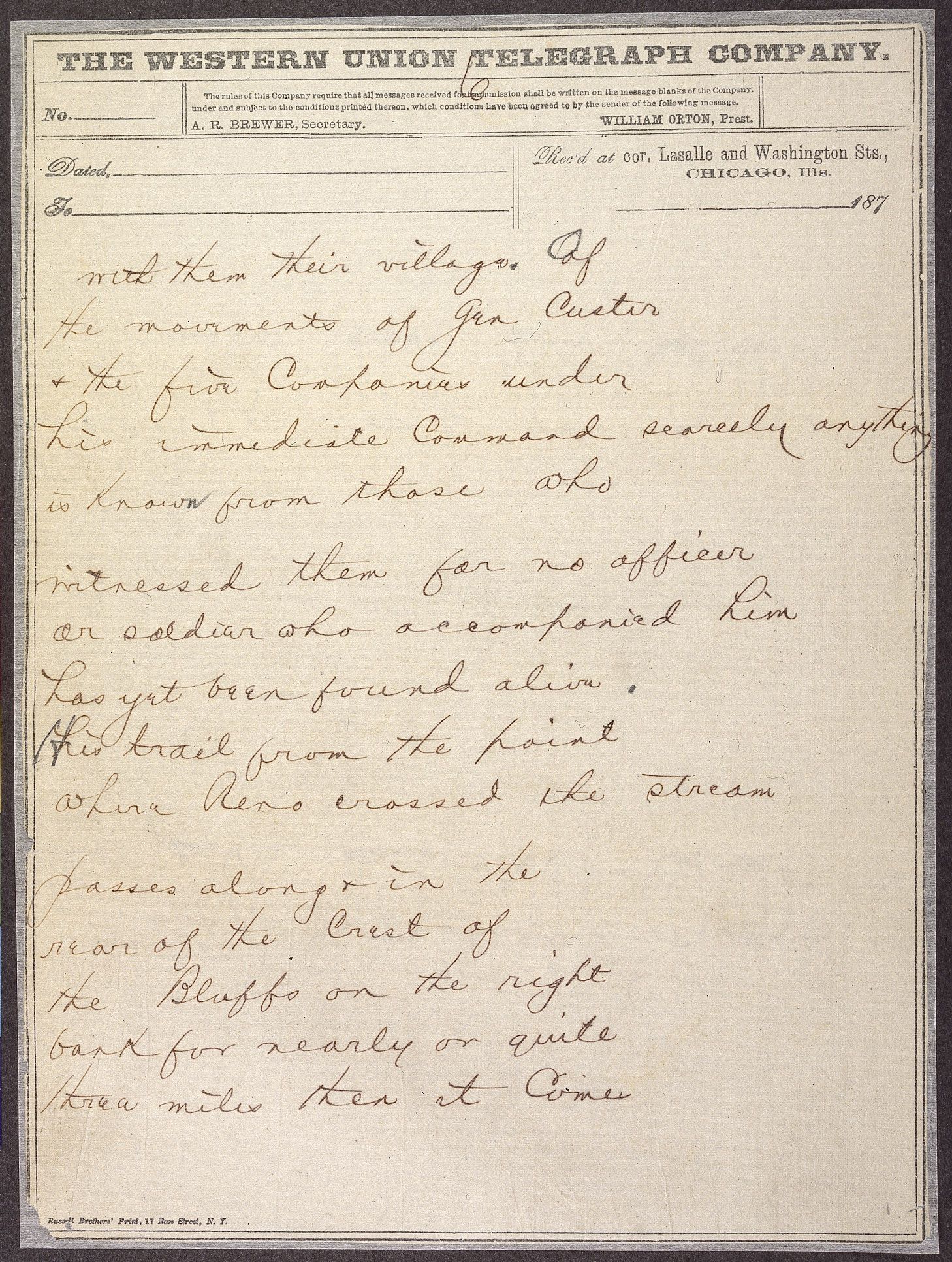
First Report of the Battle of the Little Bighorn, From Gen. Alfred H. Terry, Montana, to Assistant Adjutant General R.C. Drum, Chicago
Page 7
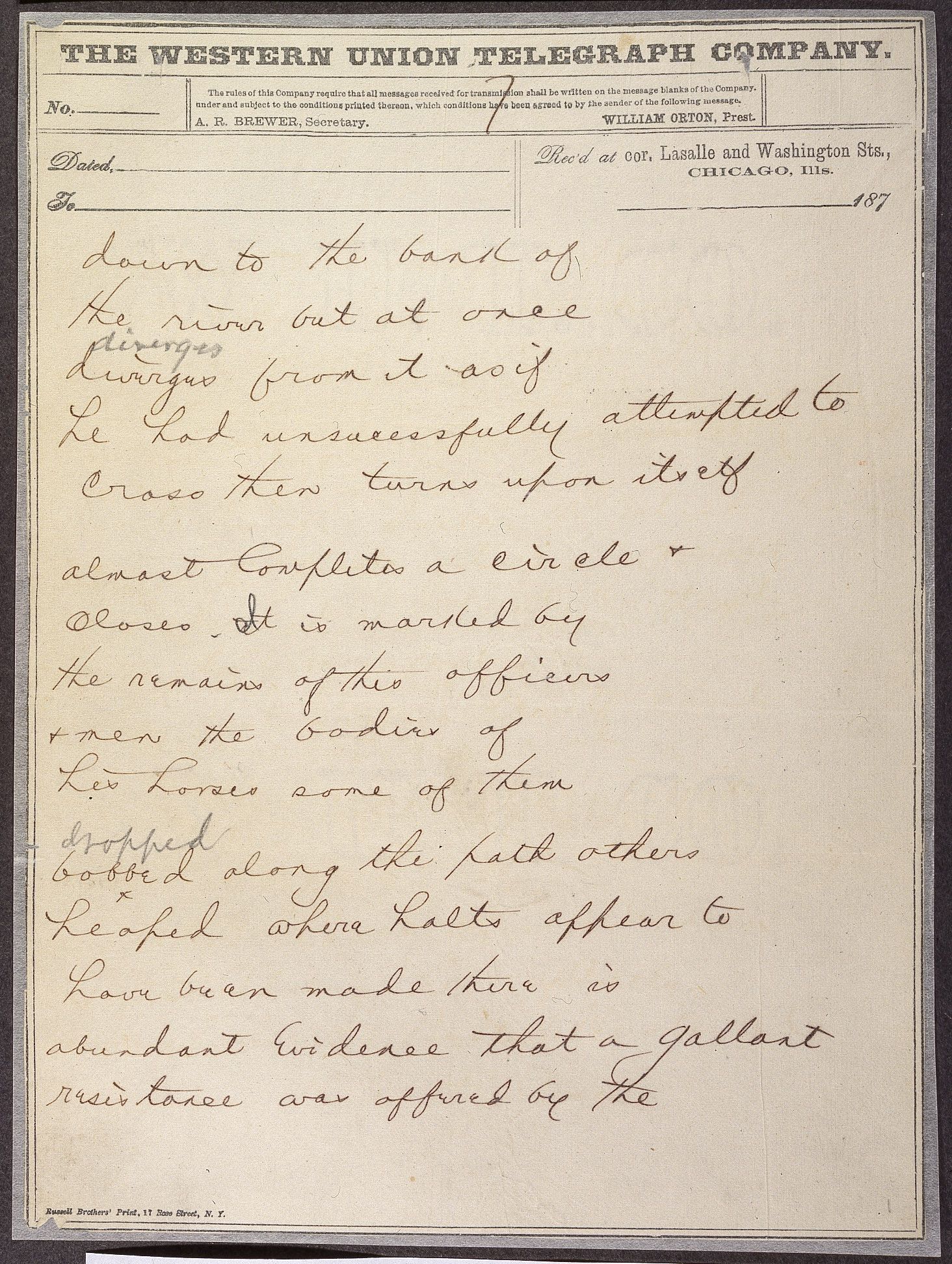
First Report of the Battle of the Little Bighorn, From Gen. Alfred H. Terry, Montana, to Assistant Adjutant General R.C. Drum, Chicago
Page 8
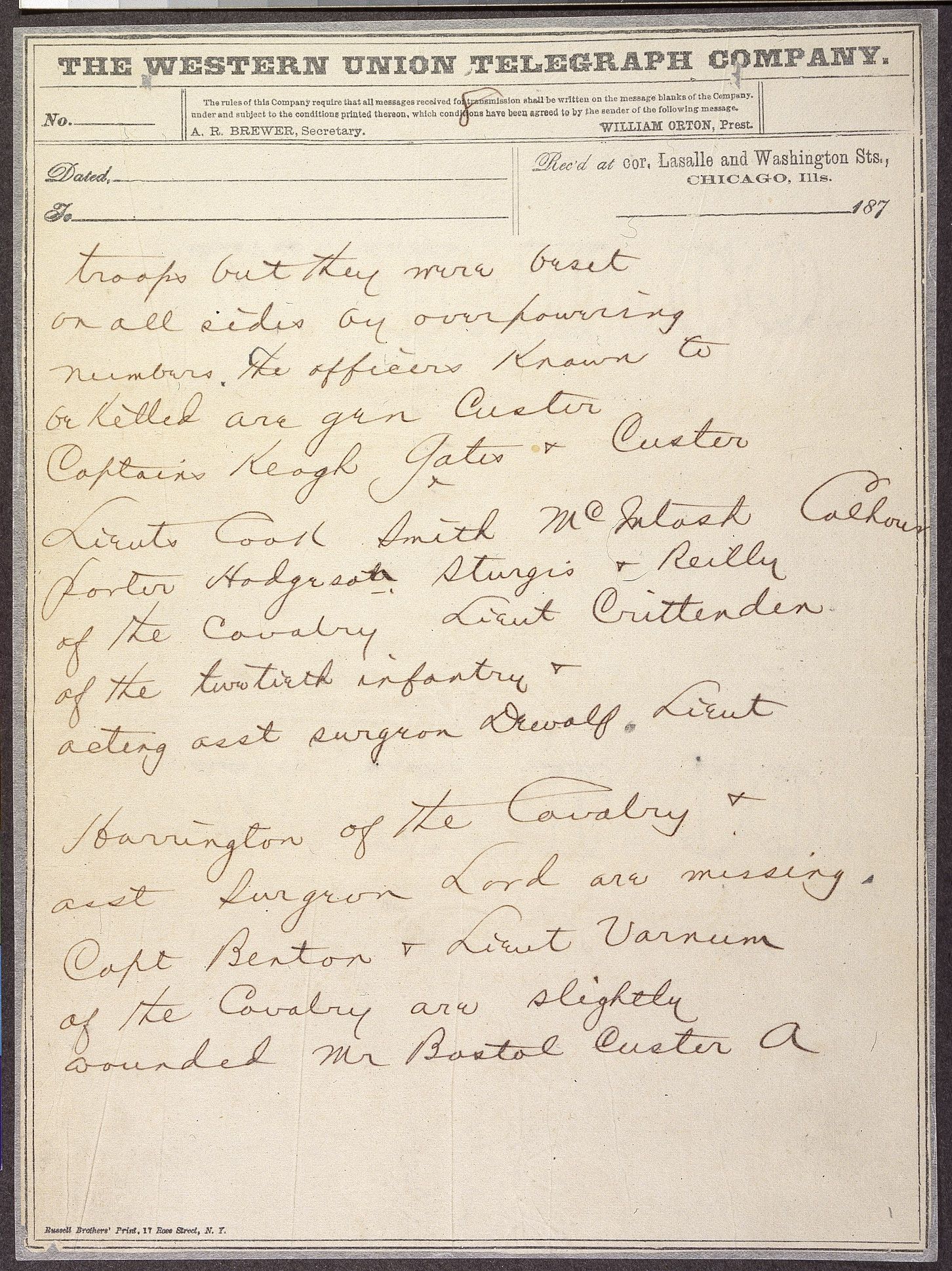
First Report of the Battle of the Little Bighorn, From Gen. Alfred H. Terry, Montana, to Assistant Adjutant General R.C. Drum, Chicago
Page 9

First Report of the Battle of the Little Bighorn, From Gen. Alfred H. Terry, Montana, to Assistant Adjutant General R.C. Drum, Chicago
Page 10

First Report of the Battle of the Little Bighorn, From Gen. Alfred H. Terry, Montana, to Assistant Adjutant General R.C. Drum, Chicago
Page 11

First Report of the Battle of the Little Bighorn, From Gen. Alfred H. Terry, Montana, to Assistant Adjutant General R.C. Drum, Chicago
Page 12
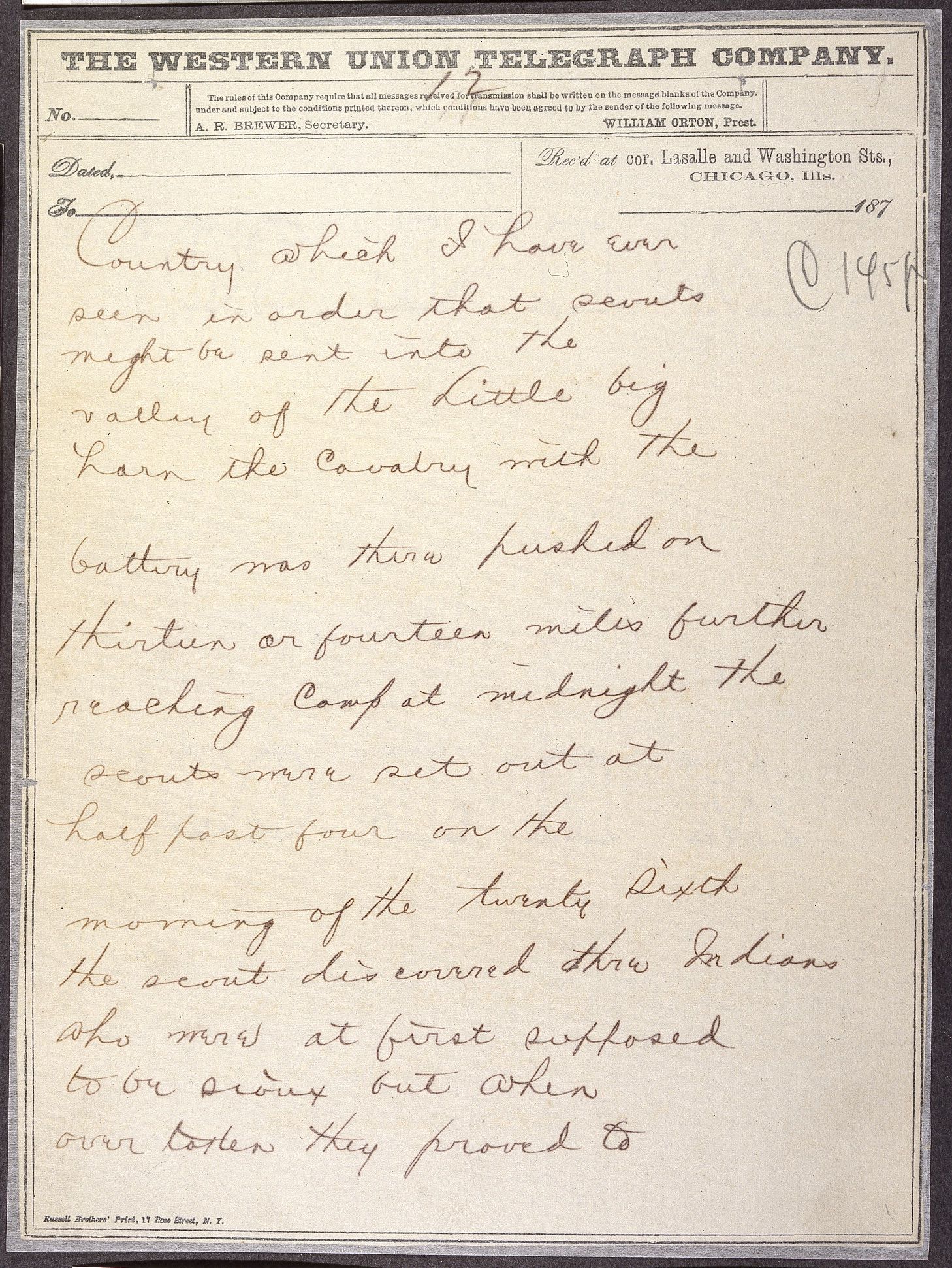
First Report of the Battle of the Little Bighorn, From Gen. Alfred H. Terry, Montana, to Assistant Adjutant General R.C. Drum, Chicago
Page 13
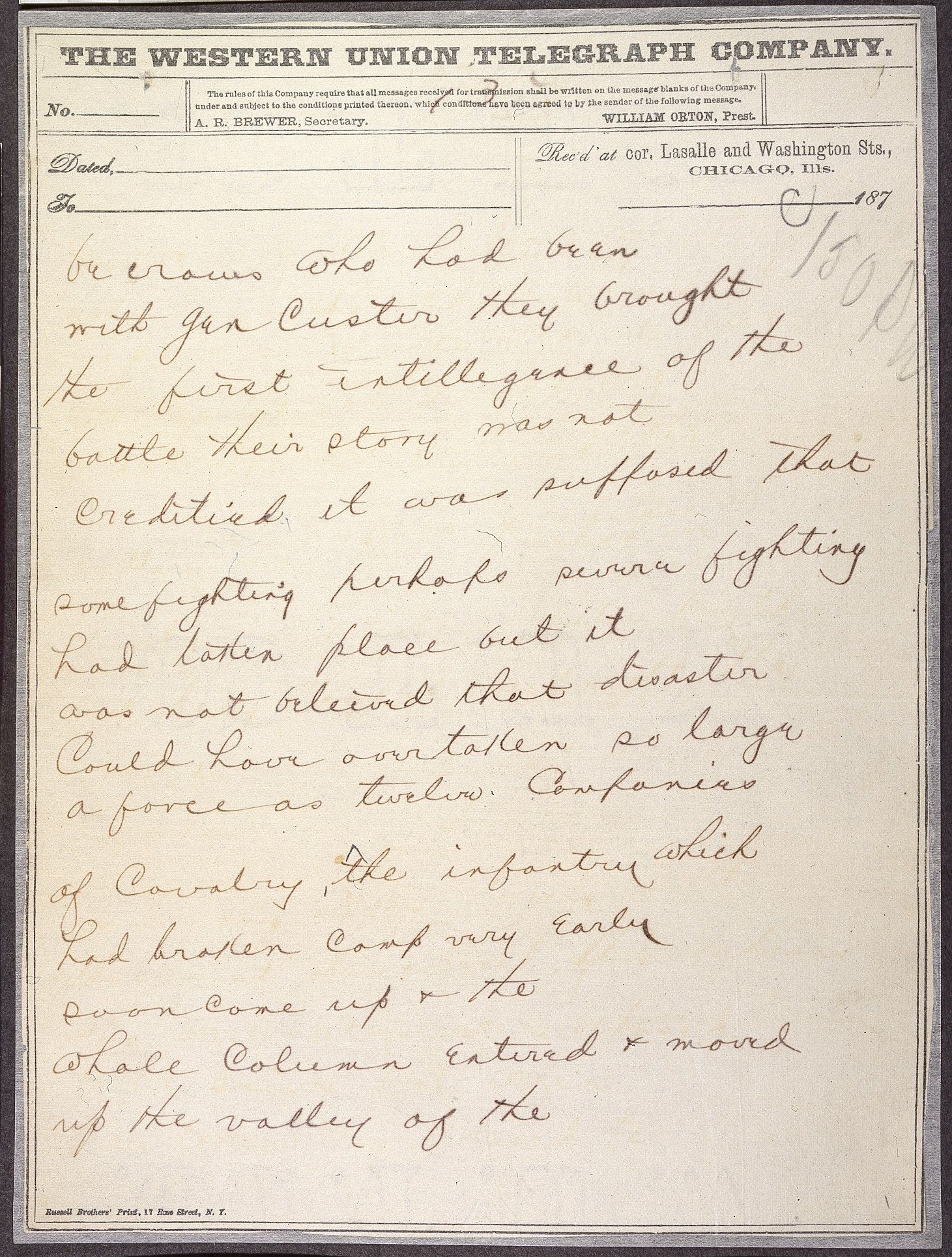
First Report of the Battle of the Little Bighorn, From Gen. Alfred H. Terry, Montana, to Assistant Adjutant General R.C. Drum, Chicago
Page 14
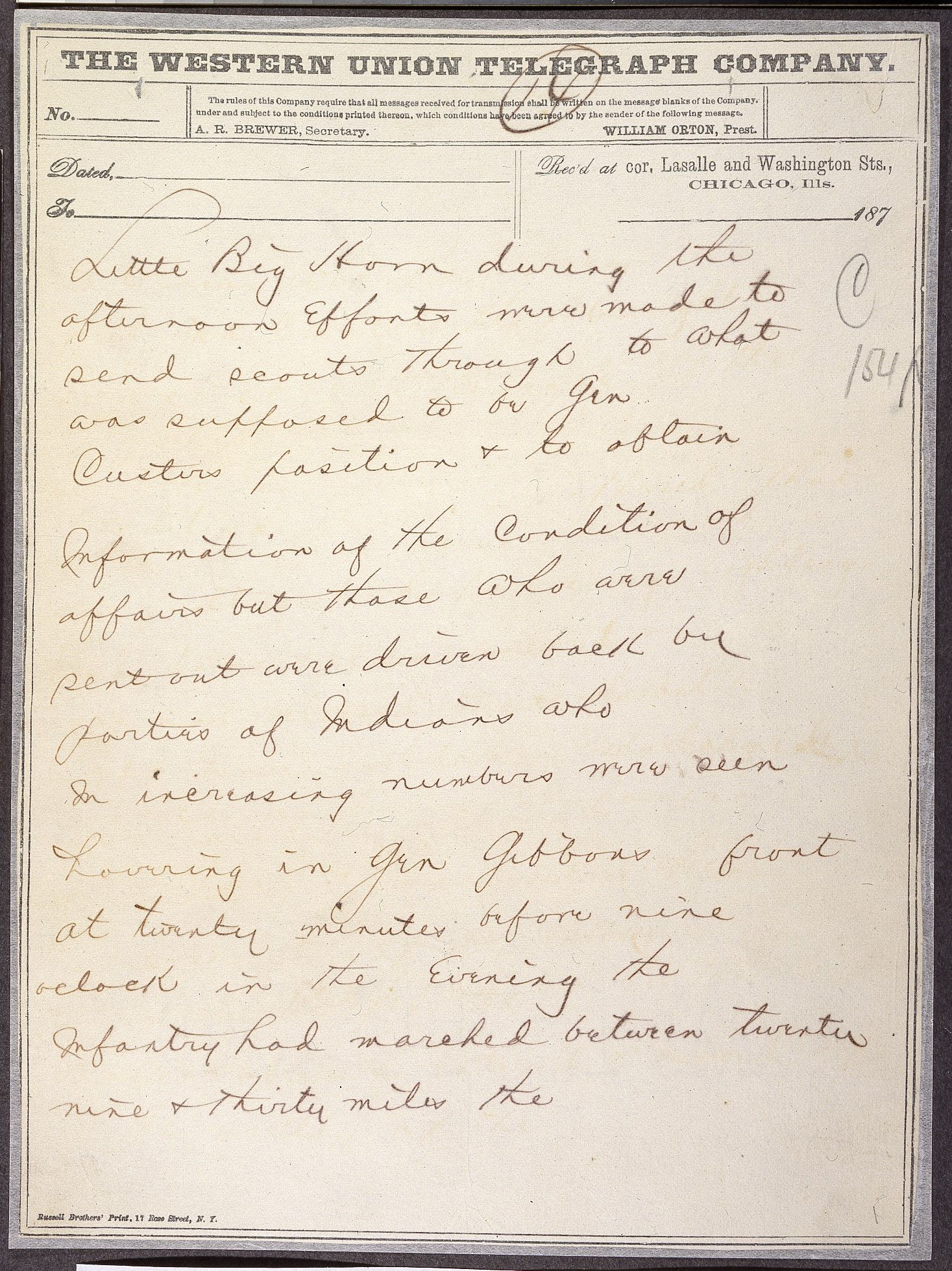
First Report of the Battle of the Little Bighorn, From Gen. Alfred H. Terry, Montana, to Assistant Adjutant General R.C. Drum, Chicago
Page 15
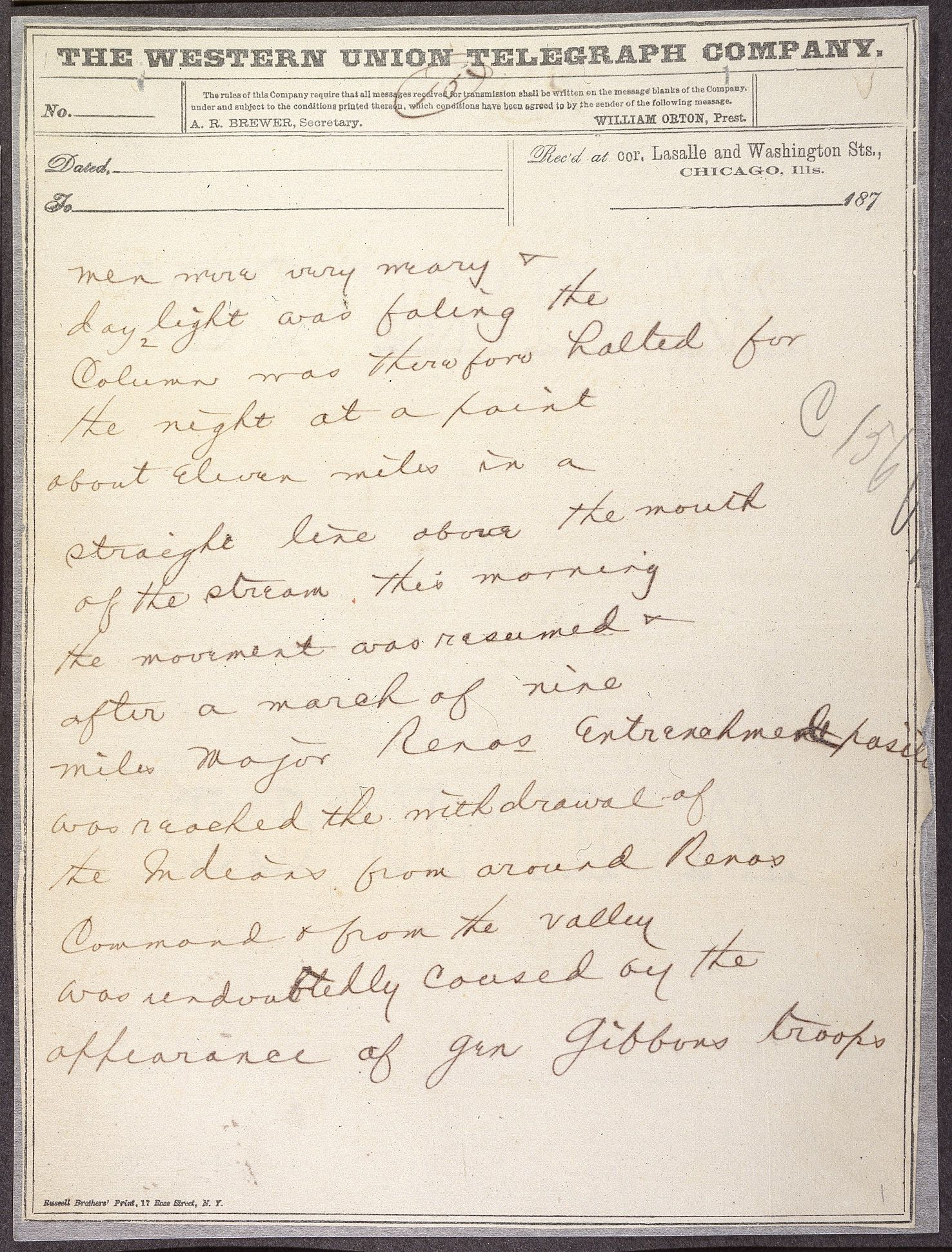
First Report of the Battle of the Little Bighorn, From Gen. Alfred H. Terry, Montana, to Assistant Adjutant General R.C. Drum, Chicago
Page 16

First Report of the Battle of the Little Bighorn, From Gen. Alfred H. Terry, Montana, to Assistant Adjutant General R.C. Drum, Chicago
Page 17

First Report of the Battle of the Little Bighorn, From Gen. Alfred H. Terry, Montana, to Assistant Adjutant General R.C. Drum, Chicago
Page 18
